Understanding Father and Child Relationship Through Play
VerifiedAdded on 2021/02/21
|38
|11152
|29
AI Summary
The current study examines the association between father and child play (RTP) and child cognitive outcomes. Using both frequentist and Bayesian approaches, it assesses RTP in quantity and quality, showing a positive link to child working memory performance. The findings suggest that encouraging fathers to engage in RTP with their daughters may enhance working memory performance.
Contribute Materials
Your contribution can guide someone’s learning journey. Share your
documents today.
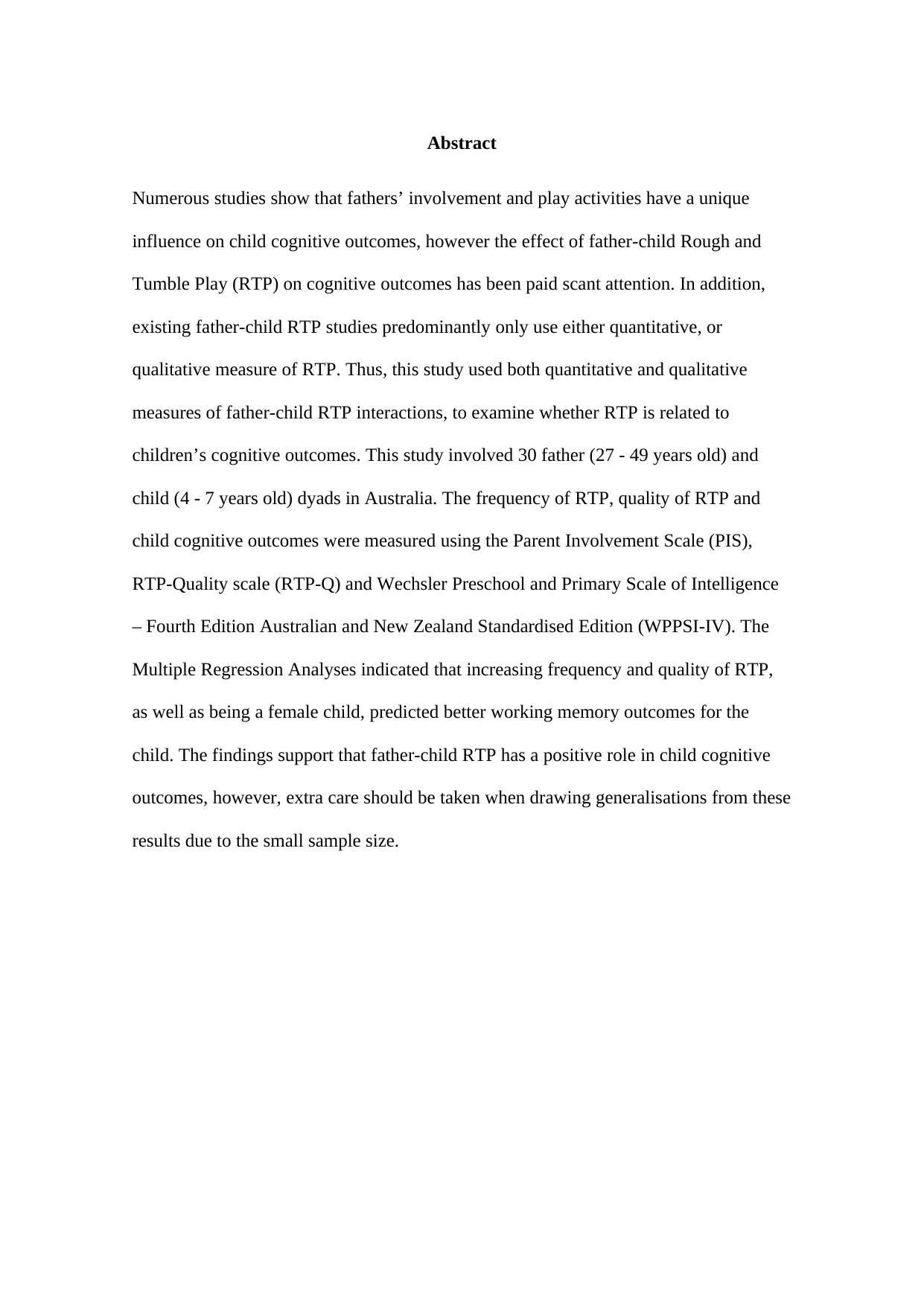
Abstract
Numerous studies show that fathers’ involvement and play activities have a unique
influence on child cognitive outcomes, however the effect of father-child Rough and
Tumble Play (RTP) on cognitive outcomes has been paid scant attention. In addition,
existing father-child RTP studies predominantly only use either quantitative, or
qualitative measure of RTP. Thus, this study used both quantitative and qualitative
measures of father-child RTP interactions, to examine whether RTP is related to
children’s cognitive outcomes. This study involved 30 father (27 - 49 years old) and
child (4 - 7 years old) dyads in Australia. The frequency of RTP, quality of RTP and
child cognitive outcomes were measured using the Parent Involvement Scale (PIS),
RTP-Quality scale (RTP-Q) and Wechsler Preschool and Primary Scale of Intelligence
– Fourth Edition Australian and New Zealand Standardised Edition (WPPSI-IV). The
Multiple Regression Analyses indicated that increasing frequency and quality of RTP,
as well as being a female child, predicted better working memory outcomes for the
child. The findings support that father-child RTP has a positive role in child cognitive
outcomes, however, extra care should be taken when drawing generalisations from these
results due to the small sample size.
Numerous studies show that fathers’ involvement and play activities have a unique
influence on child cognitive outcomes, however the effect of father-child Rough and
Tumble Play (RTP) on cognitive outcomes has been paid scant attention. In addition,
existing father-child RTP studies predominantly only use either quantitative, or
qualitative measure of RTP. Thus, this study used both quantitative and qualitative
measures of father-child RTP interactions, to examine whether RTP is related to
children’s cognitive outcomes. This study involved 30 father (27 - 49 years old) and
child (4 - 7 years old) dyads in Australia. The frequency of RTP, quality of RTP and
child cognitive outcomes were measured using the Parent Involvement Scale (PIS),
RTP-Quality scale (RTP-Q) and Wechsler Preschool and Primary Scale of Intelligence
– Fourth Edition Australian and New Zealand Standardised Edition (WPPSI-IV). The
Multiple Regression Analyses indicated that increasing frequency and quality of RTP,
as well as being a female child, predicted better working memory outcomes for the
child. The findings support that father-child RTP has a positive role in child cognitive
outcomes, however, extra care should be taken when drawing generalisations from these
results due to the small sample size.
Secure Best Marks with AI Grader
Need help grading? Try our AI Grader for instant feedback on your assignments.
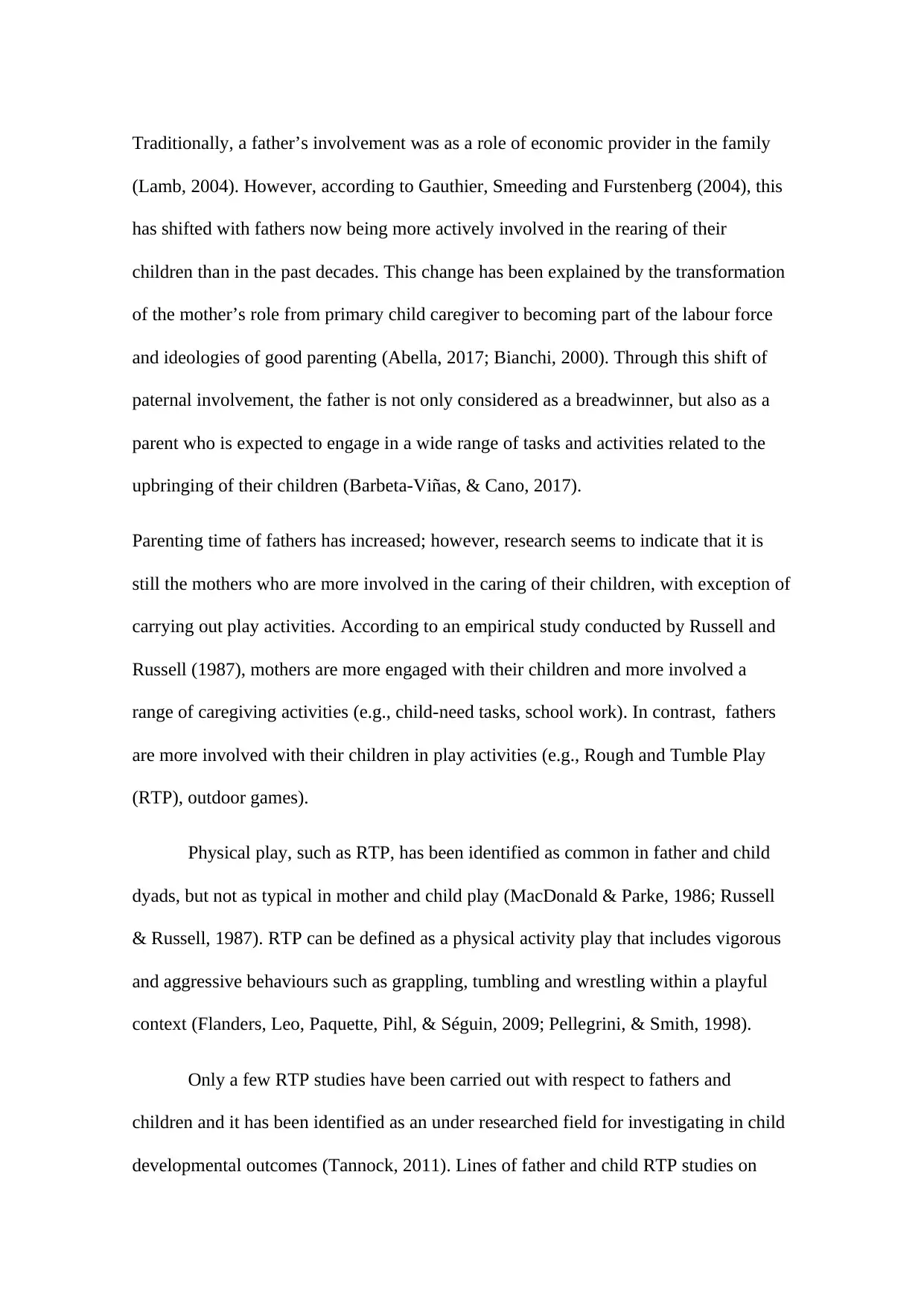
Traditionally, a father’s involvement was as a role of economic provider in the family
(Lamb, 2004). However, according to Gauthier, Smeeding and Furstenberg (2004), this
has shifted with fathers now being more actively involved in the rearing of their
children than in the past decades. This change has been explained by the transformation
of the mother’s role from primary child caregiver to becoming part of the labour force
and ideologies of good parenting (Abella, 2017; Bianchi, 2000). Through this shift of
paternal involvement, the father is not only considered as a breadwinner, but also as a
parent who is expected to engage in a wide range of tasks and activities related to the
upbringing of their children (Barbeta-Viñas, & Cano, 2017).
Parenting time of fathers has increased; however, research seems to indicate that it is
still the mothers who are more involved in the caring of their children, with exception of
carrying out play activities. According to an empirical study conducted by Russell and
Russell (1987), mothers are more engaged with their children and more involved a
range of caregiving activities (e.g., child-need tasks, school work). In contrast, fathers
are more involved with their children in play activities (e.g., Rough and Tumble Play
(RTP), outdoor games).
Physical play, such as RTP, has been identified as common in father and child
dyads, but not as typical in mother and child play (MacDonald & Parke, 1986; Russell
& Russell, 1987). RTP can be defined as a physical activity play that includes vigorous
and aggressive behaviours such as grappling, tumbling and wrestling within a playful
context (Flanders, Leo, Paquette, Pihl, & Séguin, 2009; Pellegrini, & Smith, 1998).
Only a few RTP studies have been carried out with respect to fathers and
children and it has been identified as an under researched field for investigating in child
developmental outcomes (Tannock, 2011). Lines of father and child RTP studies on
(Lamb, 2004). However, according to Gauthier, Smeeding and Furstenberg (2004), this
has shifted with fathers now being more actively involved in the rearing of their
children than in the past decades. This change has been explained by the transformation
of the mother’s role from primary child caregiver to becoming part of the labour force
and ideologies of good parenting (Abella, 2017; Bianchi, 2000). Through this shift of
paternal involvement, the father is not only considered as a breadwinner, but also as a
parent who is expected to engage in a wide range of tasks and activities related to the
upbringing of their children (Barbeta-Viñas, & Cano, 2017).
Parenting time of fathers has increased; however, research seems to indicate that it is
still the mothers who are more involved in the caring of their children, with exception of
carrying out play activities. According to an empirical study conducted by Russell and
Russell (1987), mothers are more engaged with their children and more involved a
range of caregiving activities (e.g., child-need tasks, school work). In contrast, fathers
are more involved with their children in play activities (e.g., Rough and Tumble Play
(RTP), outdoor games).
Physical play, such as RTP, has been identified as common in father and child
dyads, but not as typical in mother and child play (MacDonald & Parke, 1986; Russell
& Russell, 1987). RTP can be defined as a physical activity play that includes vigorous
and aggressive behaviours such as grappling, tumbling and wrestling within a playful
context (Flanders, Leo, Paquette, Pihl, & Séguin, 2009; Pellegrini, & Smith, 1998).
Only a few RTP studies have been carried out with respect to fathers and
children and it has been identified as an under researched field for investigating in child
developmental outcomes (Tannock, 2011). Lines of father and child RTP studies on
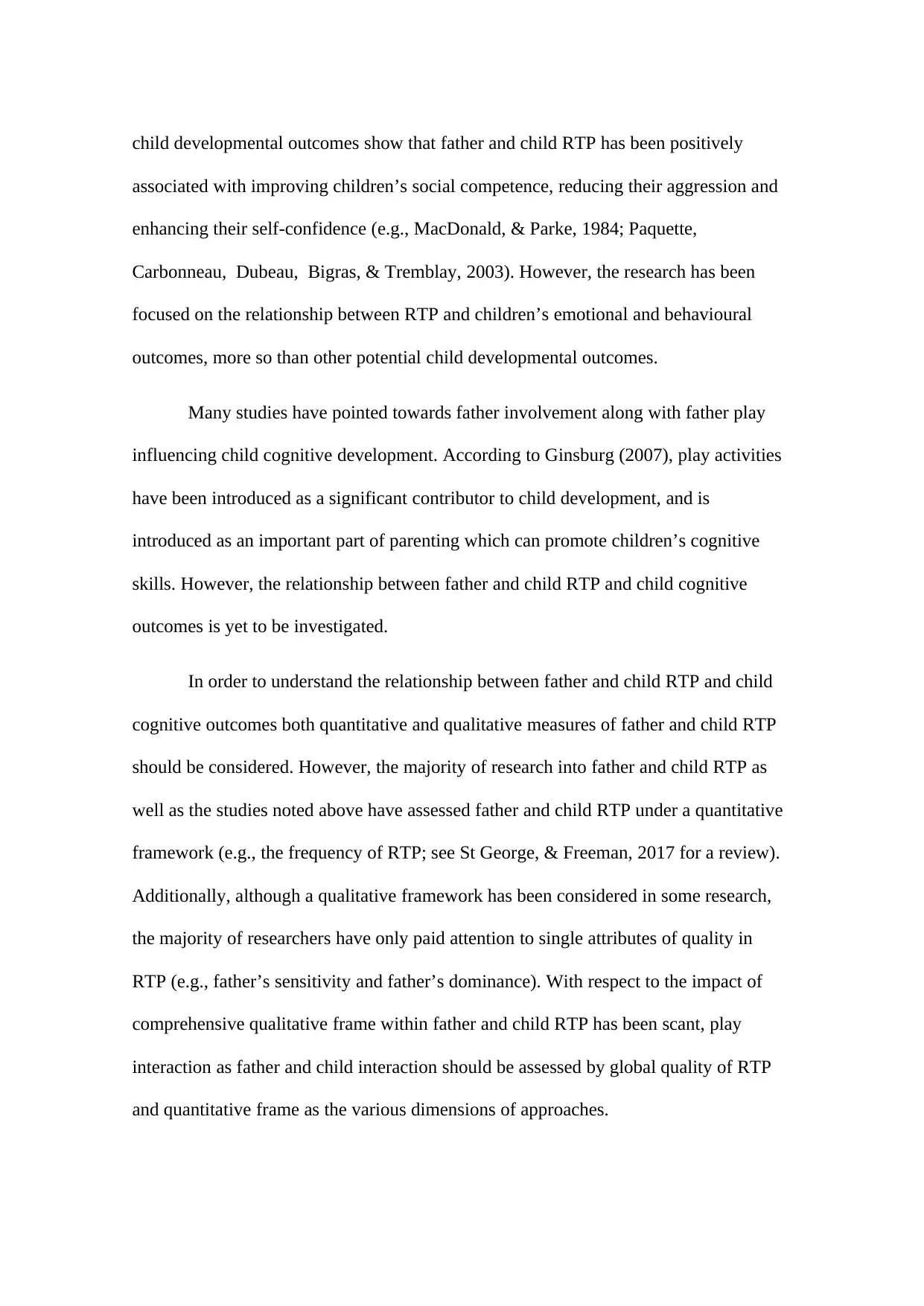
child developmental outcomes show that father and child RTP has been positively
associated with improving children’s social competence, reducing their aggression and
enhancing their self-confidence (e.g., MacDonald, & Parke, 1984; Paquette,
Carbonneau, Dubeau, Bigras, & Tremblay, 2003). However, the research has been
focused on the relationship between RTP and children’s emotional and behavioural
outcomes, more so than other potential child developmental outcomes.
Many studies have pointed towards father involvement along with father play
influencing child cognitive development. According to Ginsburg (2007), play activities
have been introduced as a significant contributor to child development, and is
introduced as an important part of parenting which can promote children’s cognitive
skills. However, the relationship between father and child RTP and child cognitive
outcomes is yet to be investigated.
In order to understand the relationship between father and child RTP and child
cognitive outcomes both quantitative and qualitative measures of father and child RTP
should be considered. However, the majority of research into father and child RTP as
well as the studies noted above have assessed father and child RTP under a quantitative
framework (e.g., the frequency of RTP; see St George, & Freeman, 2017 for a review).
Additionally, although a qualitative framework has been considered in some research,
the majority of researchers have only paid attention to single attributes of quality in
RTP (e.g., father’s sensitivity and father’s dominance). With respect to the impact of
comprehensive qualitative frame within father and child RTP has been scant, play
interaction as father and child interaction should be assessed by global quality of RTP
and quantitative frame as the various dimensions of approaches.
associated with improving children’s social competence, reducing their aggression and
enhancing their self-confidence (e.g., MacDonald, & Parke, 1984; Paquette,
Carbonneau, Dubeau, Bigras, & Tremblay, 2003). However, the research has been
focused on the relationship between RTP and children’s emotional and behavioural
outcomes, more so than other potential child developmental outcomes.
Many studies have pointed towards father involvement along with father play
influencing child cognitive development. According to Ginsburg (2007), play activities
have been introduced as a significant contributor to child development, and is
introduced as an important part of parenting which can promote children’s cognitive
skills. However, the relationship between father and child RTP and child cognitive
outcomes is yet to be investigated.
In order to understand the relationship between father and child RTP and child
cognitive outcomes both quantitative and qualitative measures of father and child RTP
should be considered. However, the majority of research into father and child RTP as
well as the studies noted above have assessed father and child RTP under a quantitative
framework (e.g., the frequency of RTP; see St George, & Freeman, 2017 for a review).
Additionally, although a qualitative framework has been considered in some research,
the majority of researchers have only paid attention to single attributes of quality in
RTP (e.g., father’s sensitivity and father’s dominance). With respect to the impact of
comprehensive qualitative frame within father and child RTP has been scant, play
interaction as father and child interaction should be assessed by global quality of RTP
and quantitative frame as the various dimensions of approaches.
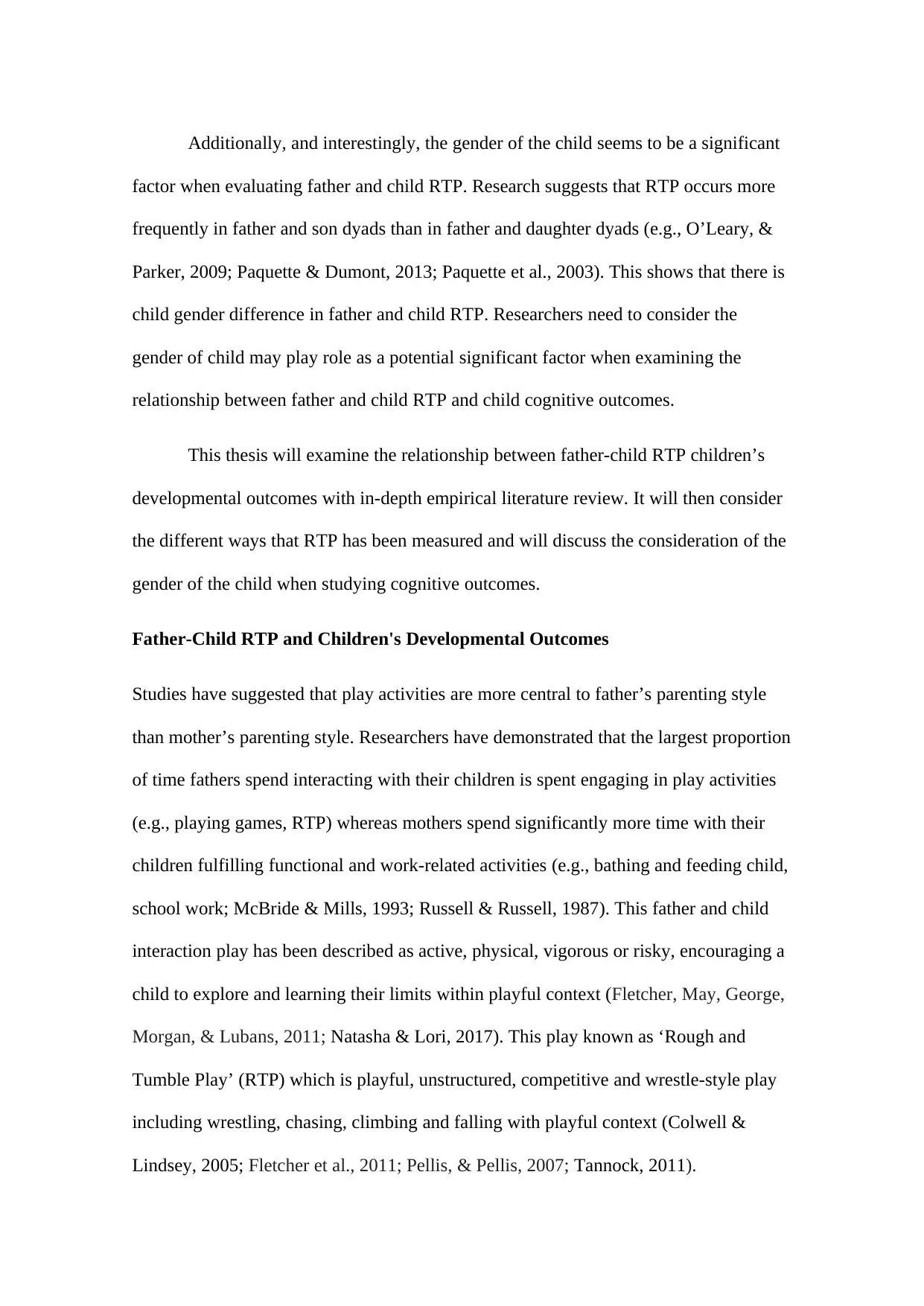
Additionally, and interestingly, the gender of the child seems to be a significant
factor when evaluating father and child RTP. Research suggests that RTP occurs more
frequently in father and son dyads than in father and daughter dyads (e.g., O’Leary, &
Parker, 2009; Paquette & Dumont, 2013; Paquette et al., 2003). This shows that there is
child gender difference in father and child RTP. Researchers need to consider the
gender of child may play role as a potential significant factor when examining the
relationship between father and child RTP and child cognitive outcomes.
This thesis will examine the relationship between father-child RTP children’s
developmental outcomes with in-depth empirical literature review. It will then consider
the different ways that RTP has been measured and will discuss the consideration of the
gender of the child when studying cognitive outcomes.
Father-Child RTP and Children's Developmental Outcomes
Studies have suggested that play activities are more central to father’s parenting style
than mother’s parenting style. Researchers have demonstrated that the largest proportion
of time fathers spend interacting with their children is spent engaging in play activities
(e.g., playing games, RTP) whereas mothers spend significantly more time with their
children fulfilling functional and work-related activities (e.g., bathing and feeding child,
school work; McBride & Mills, 1993; Russell & Russell, 1987). This father and child
interaction play has been described as active, physical, vigorous or risky, encouraging a
child to explore and learning their limits within playful context (Fletcher, May, George,
Morgan, & Lubans, 2011; Natasha & Lori, 2017). This play known as ‘Rough and
Tumble Play’ (RTP) which is playful, unstructured, competitive and wrestle-style play
including wrestling, chasing, climbing and falling with playful context (Colwell &
Lindsey, 2005; Fletcher et al., 2011; Pellis, & Pellis, 2007; Tannock, 2011).
factor when evaluating father and child RTP. Research suggests that RTP occurs more
frequently in father and son dyads than in father and daughter dyads (e.g., O’Leary, &
Parker, 2009; Paquette & Dumont, 2013; Paquette et al., 2003). This shows that there is
child gender difference in father and child RTP. Researchers need to consider the
gender of child may play role as a potential significant factor when examining the
relationship between father and child RTP and child cognitive outcomes.
This thesis will examine the relationship between father-child RTP children’s
developmental outcomes with in-depth empirical literature review. It will then consider
the different ways that RTP has been measured and will discuss the consideration of the
gender of the child when studying cognitive outcomes.
Father-Child RTP and Children's Developmental Outcomes
Studies have suggested that play activities are more central to father’s parenting style
than mother’s parenting style. Researchers have demonstrated that the largest proportion
of time fathers spend interacting with their children is spent engaging in play activities
(e.g., playing games, RTP) whereas mothers spend significantly more time with their
children fulfilling functional and work-related activities (e.g., bathing and feeding child,
school work; McBride & Mills, 1993; Russell & Russell, 1987). This father and child
interaction play has been described as active, physical, vigorous or risky, encouraging a
child to explore and learning their limits within playful context (Fletcher, May, George,
Morgan, & Lubans, 2011; Natasha & Lori, 2017). This play known as ‘Rough and
Tumble Play’ (RTP) which is playful, unstructured, competitive and wrestle-style play
including wrestling, chasing, climbing and falling with playful context (Colwell &
Lindsey, 2005; Fletcher et al., 2011; Pellis, & Pellis, 2007; Tannock, 2011).
Secure Best Marks with AI Grader
Need help grading? Try our AI Grader for instant feedback on your assignments.
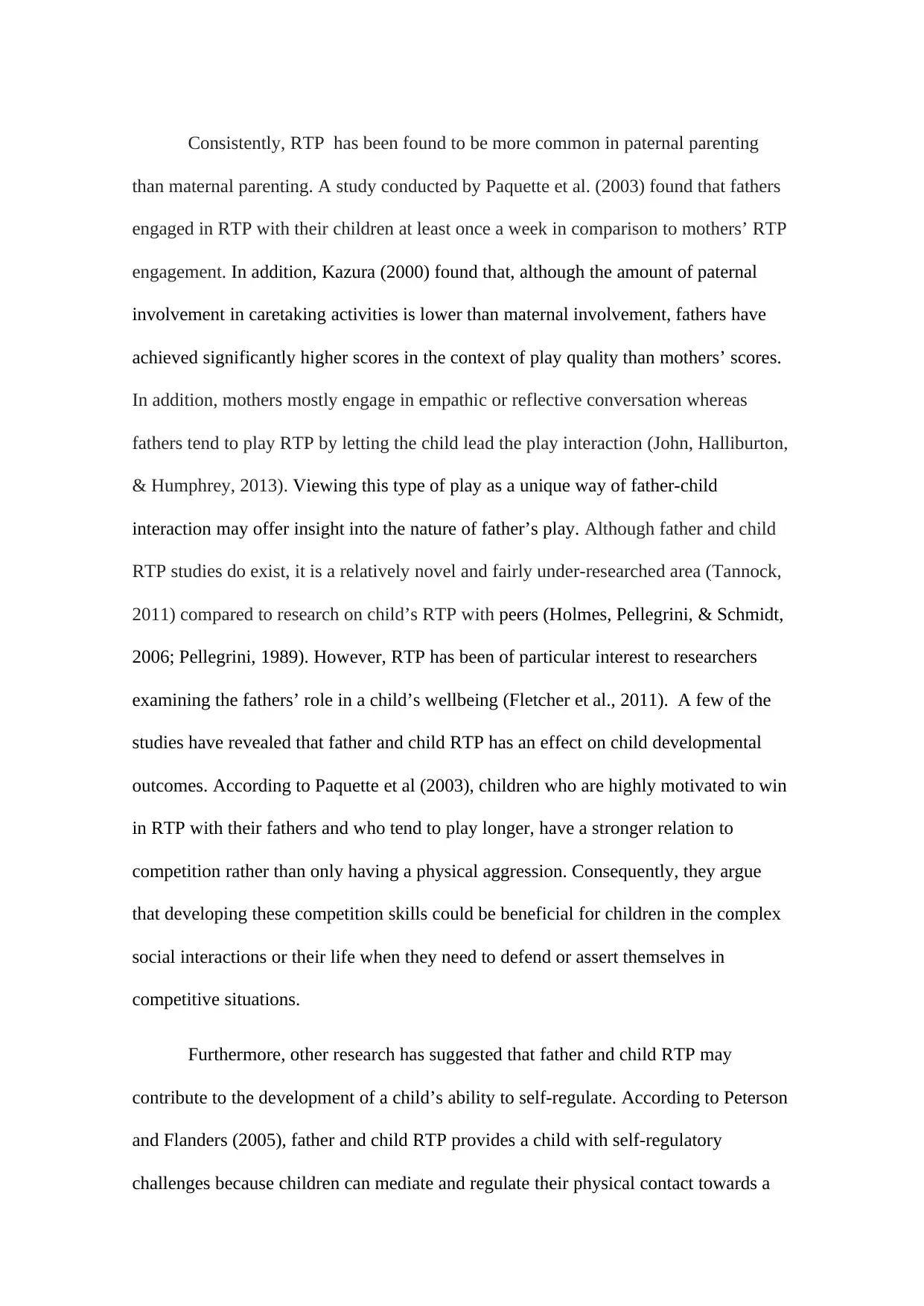
Consistently, RTP has been found to be more common in paternal parenting
than maternal parenting. A study conducted by Paquette et al. (2003) found that fathers
engaged in RTP with their children at least once a week in comparison to mothers’ RTP
engagement. In addition, Kazura (2000) found that, although the amount of paternal
involvement in caretaking activities is lower than maternal involvement, fathers have
achieved significantly higher scores in the context of play quality than mothers’ scores.
In addition, mothers mostly engage in empathic or reflective conversation whereas
fathers tend to play RTP by letting the child lead the play interaction (John, Halliburton,
& Humphrey, 2013). Viewing this type of play as a unique way of father-child
interaction may offer insight into the nature of father’s play. Although father and child
RTP studies do exist, it is a relatively novel and fairly under-researched area (Tannock,
2011) compared to research on child’s RTP with peers (Holmes, Pellegrini, & Schmidt,
2006; Pellegrini, 1989). However, RTP has been of particular interest to researchers
examining the fathers’ role in a child’s wellbeing (Fletcher et al., 2011). A few of the
studies have revealed that father and child RTP has an effect on child developmental
outcomes. According to Paquette et al (2003), children who are highly motivated to win
in RTP with their fathers and who tend to play longer, have a stronger relation to
competition rather than only having a physical aggression. Consequently, they argue
that developing these competition skills could be beneficial for children in the complex
social interactions or their life when they need to defend or assert themselves in
competitive situations.
Furthermore, other research has suggested that father and child RTP may
contribute to the development of a child’s ability to self-regulate. According to Peterson
and Flanders (2005), father and child RTP provides a child with self-regulatory
challenges because children can mediate and regulate their physical contact towards a
than maternal parenting. A study conducted by Paquette et al. (2003) found that fathers
engaged in RTP with their children at least once a week in comparison to mothers’ RTP
engagement. In addition, Kazura (2000) found that, although the amount of paternal
involvement in caretaking activities is lower than maternal involvement, fathers have
achieved significantly higher scores in the context of play quality than mothers’ scores.
In addition, mothers mostly engage in empathic or reflective conversation whereas
fathers tend to play RTP by letting the child lead the play interaction (John, Halliburton,
& Humphrey, 2013). Viewing this type of play as a unique way of father-child
interaction may offer insight into the nature of father’s play. Although father and child
RTP studies do exist, it is a relatively novel and fairly under-researched area (Tannock,
2011) compared to research on child’s RTP with peers (Holmes, Pellegrini, & Schmidt,
2006; Pellegrini, 1989). However, RTP has been of particular interest to researchers
examining the fathers’ role in a child’s wellbeing (Fletcher et al., 2011). A few of the
studies have revealed that father and child RTP has an effect on child developmental
outcomes. According to Paquette et al (2003), children who are highly motivated to win
in RTP with their fathers and who tend to play longer, have a stronger relation to
competition rather than only having a physical aggression. Consequently, they argue
that developing these competition skills could be beneficial for children in the complex
social interactions or their life when they need to defend or assert themselves in
competitive situations.
Furthermore, other research has suggested that father and child RTP may
contribute to the development of a child’s ability to self-regulate. According to Peterson
and Flanders (2005), father and child RTP provides a child with self-regulatory
challenges because children can mediate and regulate their physical contact towards a
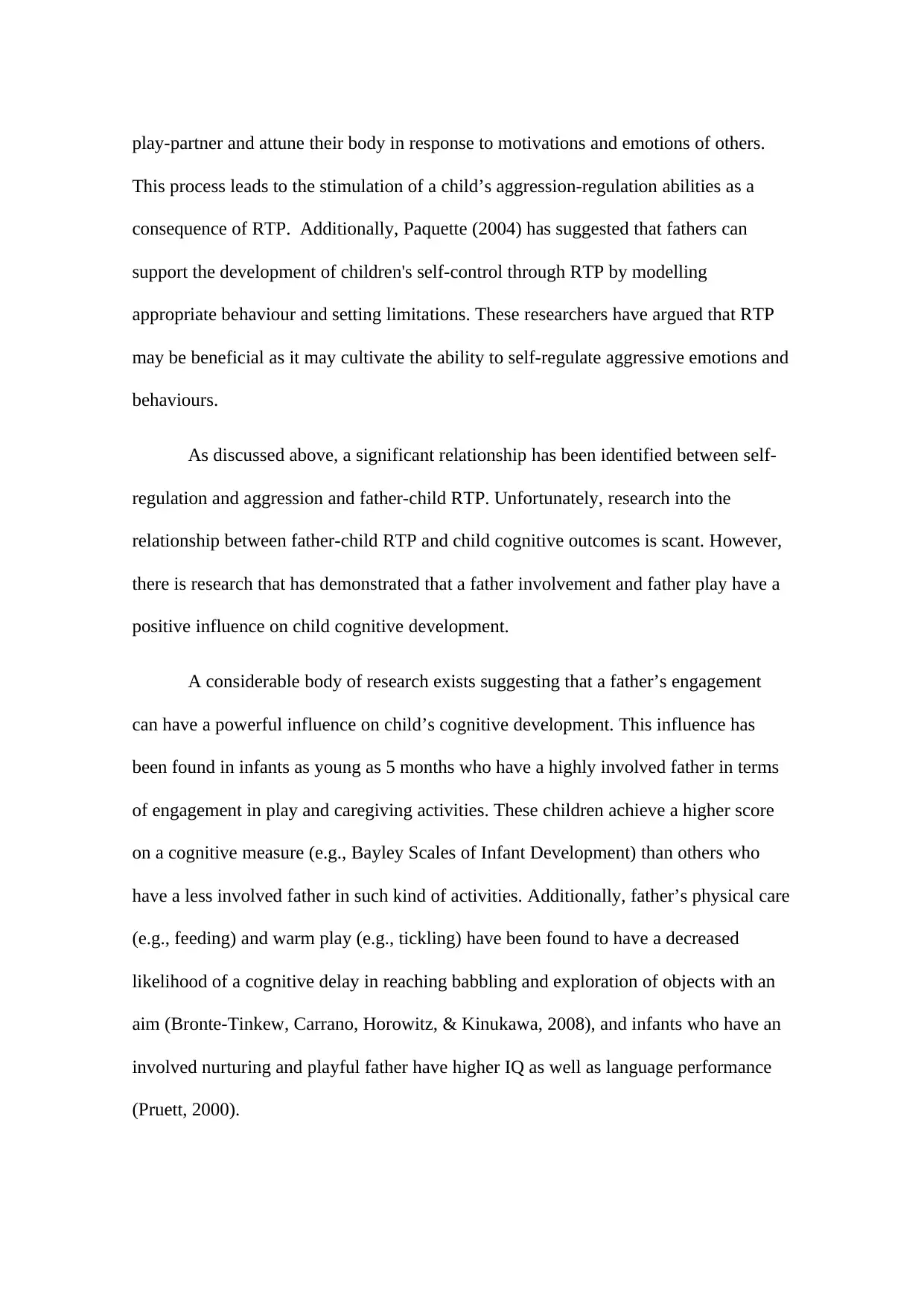
play-partner and attune their body in response to motivations and emotions of others.
This process leads to the stimulation of a child’s aggression-regulation abilities as a
consequence of RTP. Additionally, Paquette (2004) has suggested that fathers can
support the development of children's self-control through RTP by modelling
appropriate behaviour and setting limitations. These researchers have argued that RTP
may be beneficial as it may cultivate the ability to self-regulate aggressive emotions and
behaviours.
As discussed above, a significant relationship has been identified between self-
regulation and aggression and father-child RTP. Unfortunately, research into the
relationship between father-child RTP and child cognitive outcomes is scant. However,
there is research that has demonstrated that a father involvement and father play have a
positive influence on child cognitive development.
A considerable body of research exists suggesting that a father’s engagement
can have a powerful influence on child’s cognitive development. This influence has
been found in infants as young as 5 months who have a highly involved father in terms
of engagement in play and caregiving activities. These children achieve a higher score
on a cognitive measure (e.g., Bayley Scales of Infant Development) than others who
have a less involved father in such kind of activities. Additionally, father’s physical care
(e.g., feeding) and warm play (e.g., tickling) have been found to have a decreased
likelihood of a cognitive delay in reaching babbling and exploration of objects with an
aim (Bronte-Tinkew, Carrano, Horowitz, & Kinukawa, 2008), and infants who have an
involved nurturing and playful father have higher IQ as well as language performance
(Pruett, 2000).
This process leads to the stimulation of a child’s aggression-regulation abilities as a
consequence of RTP. Additionally, Paquette (2004) has suggested that fathers can
support the development of children's self-control through RTP by modelling
appropriate behaviour and setting limitations. These researchers have argued that RTP
may be beneficial as it may cultivate the ability to self-regulate aggressive emotions and
behaviours.
As discussed above, a significant relationship has been identified between self-
regulation and aggression and father-child RTP. Unfortunately, research into the
relationship between father-child RTP and child cognitive outcomes is scant. However,
there is research that has demonstrated that a father involvement and father play have a
positive influence on child cognitive development.
A considerable body of research exists suggesting that a father’s engagement
can have a powerful influence on child’s cognitive development. This influence has
been found in infants as young as 5 months who have a highly involved father in terms
of engagement in play and caregiving activities. These children achieve a higher score
on a cognitive measure (e.g., Bayley Scales of Infant Development) than others who
have a less involved father in such kind of activities. Additionally, father’s physical care
(e.g., feeding) and warm play (e.g., tickling) have been found to have a decreased
likelihood of a cognitive delay in reaching babbling and exploration of objects with an
aim (Bronte-Tinkew, Carrano, Horowitz, & Kinukawa, 2008), and infants who have an
involved nurturing and playful father have higher IQ as well as language performance
(Pruett, 2000).
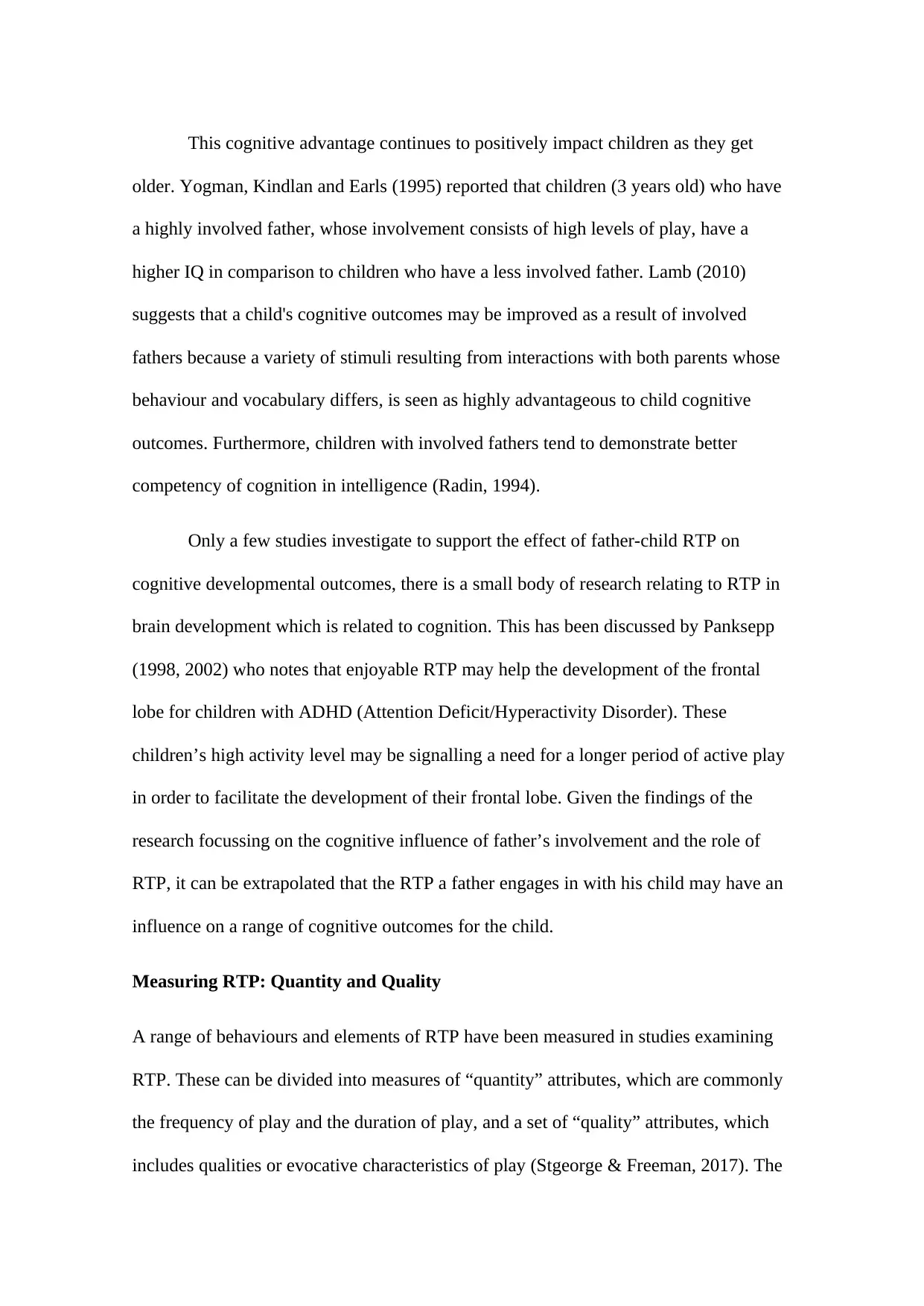
This cognitive advantage continues to positively impact children as they get
older. Yogman, Kindlan and Earls (1995) reported that children (3 years old) who have
a highly involved father, whose involvement consists of high levels of play, have a
higher IQ in comparison to children who have a less involved father. Lamb (2010)
suggests that a child's cognitive outcomes may be improved as a result of involved
fathers because a variety of stimuli resulting from interactions with both parents whose
behaviour and vocabulary differs, is seen as highly advantageous to child cognitive
outcomes. Furthermore, children with involved fathers tend to demonstrate better
competency of cognition in intelligence (Radin, 1994).
Only a few studies investigate to support the effect of father-child RTP on
cognitive developmental outcomes, there is a small body of research relating to RTP in
brain development which is related to cognition. This has been discussed by Panksepp
(1998, 2002) who notes that enjoyable RTP may help the development of the frontal
lobe for children with ADHD (Attention Deficit/Hyperactivity Disorder). These
children’s high activity level may be signalling a need for a longer period of active play
in order to facilitate the development of their frontal lobe. Given the findings of the
research focussing on the cognitive influence of father’s involvement and the role of
RTP, it can be extrapolated that the RTP a father engages in with his child may have an
influence on a range of cognitive outcomes for the child.
Measuring RTP: Quantity and Quality
A range of behaviours and elements of RTP have been measured in studies examining
RTP. These can be divided into measures of “quantity” attributes, which are commonly
the frequency of play and the duration of play, and a set of “quality” attributes, which
includes qualities or evocative characteristics of play (Stgeorge & Freeman, 2017). The
older. Yogman, Kindlan and Earls (1995) reported that children (3 years old) who have
a highly involved father, whose involvement consists of high levels of play, have a
higher IQ in comparison to children who have a less involved father. Lamb (2010)
suggests that a child's cognitive outcomes may be improved as a result of involved
fathers because a variety of stimuli resulting from interactions with both parents whose
behaviour and vocabulary differs, is seen as highly advantageous to child cognitive
outcomes. Furthermore, children with involved fathers tend to demonstrate better
competency of cognition in intelligence (Radin, 1994).
Only a few studies investigate to support the effect of father-child RTP on
cognitive developmental outcomes, there is a small body of research relating to RTP in
brain development which is related to cognition. This has been discussed by Panksepp
(1998, 2002) who notes that enjoyable RTP may help the development of the frontal
lobe for children with ADHD (Attention Deficit/Hyperactivity Disorder). These
children’s high activity level may be signalling a need for a longer period of active play
in order to facilitate the development of their frontal lobe. Given the findings of the
research focussing on the cognitive influence of father’s involvement and the role of
RTP, it can be extrapolated that the RTP a father engages in with his child may have an
influence on a range of cognitive outcomes for the child.
Measuring RTP: Quantity and Quality
A range of behaviours and elements of RTP have been measured in studies examining
RTP. These can be divided into measures of “quantity” attributes, which are commonly
the frequency of play and the duration of play, and a set of “quality” attributes, which
includes qualities or evocative characteristics of play (Stgeorge & Freeman, 2017). The
Paraphrase This Document
Need a fresh take? Get an instant paraphrase of this document with our AI Paraphraser
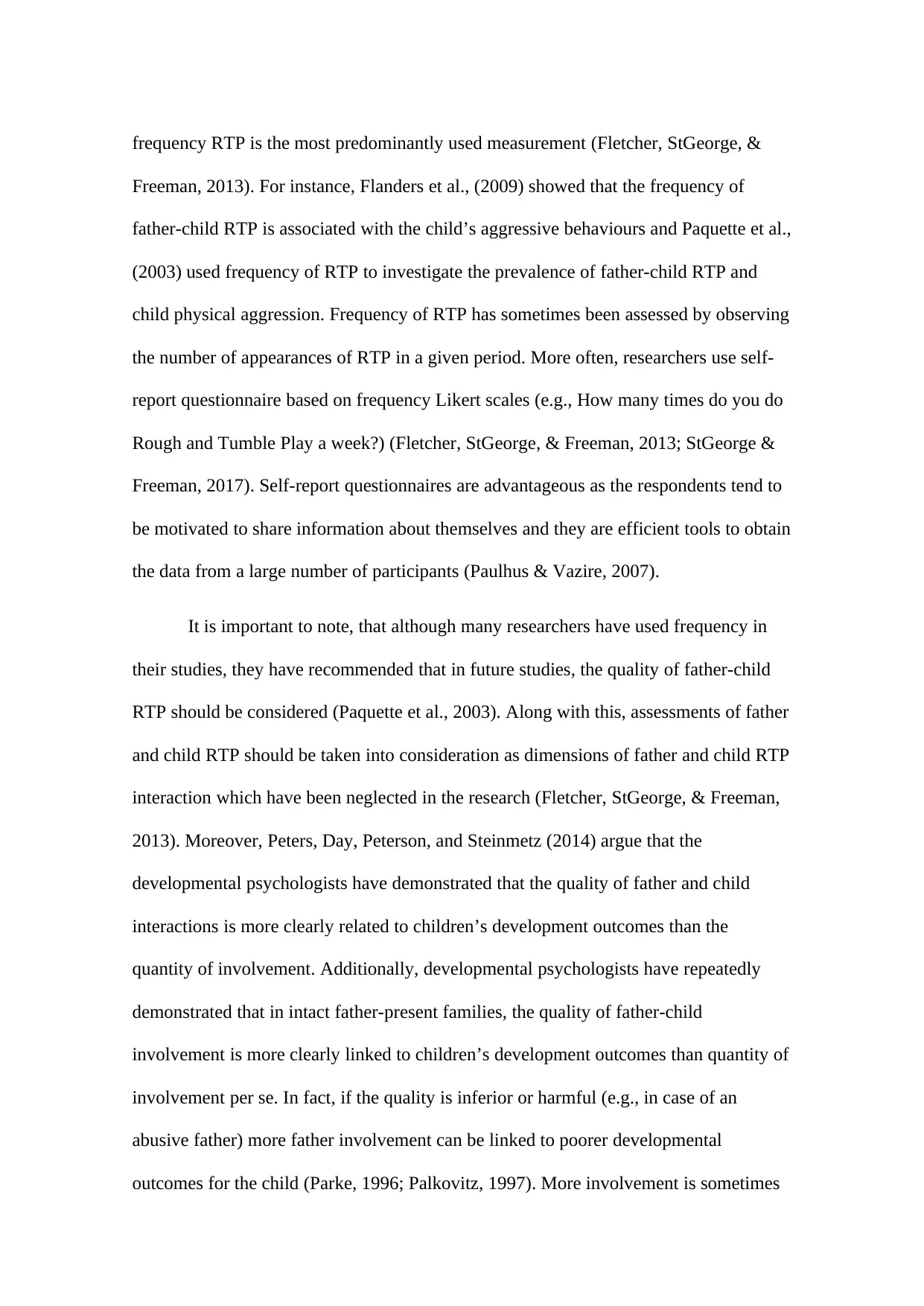
frequency RTP is the most predominantly used measurement (Fletcher, StGeorge, &
Freeman, 2013). For instance, Flanders et al., (2009) showed that the frequency of
father-child RTP is associated with the child’s aggressive behaviours and Paquette et al.,
(2003) used frequency of RTP to investigate the prevalence of father-child RTP and
child physical aggression. Frequency of RTP has sometimes been assessed by observing
the number of appearances of RTP in a given period. More often, researchers use self-
report questionnaire based on frequency Likert scales (e.g., How many times do you do
Rough and Tumble Play a week?) (Fletcher, StGeorge, & Freeman, 2013; StGeorge &
Freeman, 2017). Self-report questionnaires are advantageous as the respondents tend to
be motivated to share information about themselves and they are efficient tools to obtain
the data from a large number of participants (Paulhus & Vazire, 2007).
It is important to note, that although many researchers have used frequency in
their studies, they have recommended that in future studies, the quality of father-child
RTP should be considered (Paquette et al., 2003). Along with this, assessments of father
and child RTP should be taken into consideration as dimensions of father and child RTP
interaction which have been neglected in the research (Fletcher, StGeorge, & Freeman,
2013). Moreover, Peters, Day, Peterson, and Steinmetz (2014) argue that the
developmental psychologists have demonstrated that the quality of father and child
interactions is more clearly related to children’s development outcomes than the
quantity of involvement. Additionally, developmental psychologists have repeatedly
demonstrated that in intact father-present families, the quality of father-child
involvement is more clearly linked to children’s development outcomes than quantity of
involvement per se. In fact, if the quality is inferior or harmful (e.g., in case of an
abusive father) more father involvement can be linked to poorer developmental
outcomes for the child (Parke, 1996; Palkovitz, 1997). More involvement is sometimes
Freeman, 2013). For instance, Flanders et al., (2009) showed that the frequency of
father-child RTP is associated with the child’s aggressive behaviours and Paquette et al.,
(2003) used frequency of RTP to investigate the prevalence of father-child RTP and
child physical aggression. Frequency of RTP has sometimes been assessed by observing
the number of appearances of RTP in a given period. More often, researchers use self-
report questionnaire based on frequency Likert scales (e.g., How many times do you do
Rough and Tumble Play a week?) (Fletcher, StGeorge, & Freeman, 2013; StGeorge &
Freeman, 2017). Self-report questionnaires are advantageous as the respondents tend to
be motivated to share information about themselves and they are efficient tools to obtain
the data from a large number of participants (Paulhus & Vazire, 2007).
It is important to note, that although many researchers have used frequency in
their studies, they have recommended that in future studies, the quality of father-child
RTP should be considered (Paquette et al., 2003). Along with this, assessments of father
and child RTP should be taken into consideration as dimensions of father and child RTP
interaction which have been neglected in the research (Fletcher, StGeorge, & Freeman,
2013). Moreover, Peters, Day, Peterson, and Steinmetz (2014) argue that the
developmental psychologists have demonstrated that the quality of father and child
interactions is more clearly related to children’s development outcomes than the
quantity of involvement. Additionally, developmental psychologists have repeatedly
demonstrated that in intact father-present families, the quality of father-child
involvement is more clearly linked to children’s development outcomes than quantity of
involvement per se. In fact, if the quality is inferior or harmful (e.g., in case of an
abusive father) more father involvement can be linked to poorer developmental
outcomes for the child (Parke, 1996; Palkovitz, 1997). More involvement is sometimes
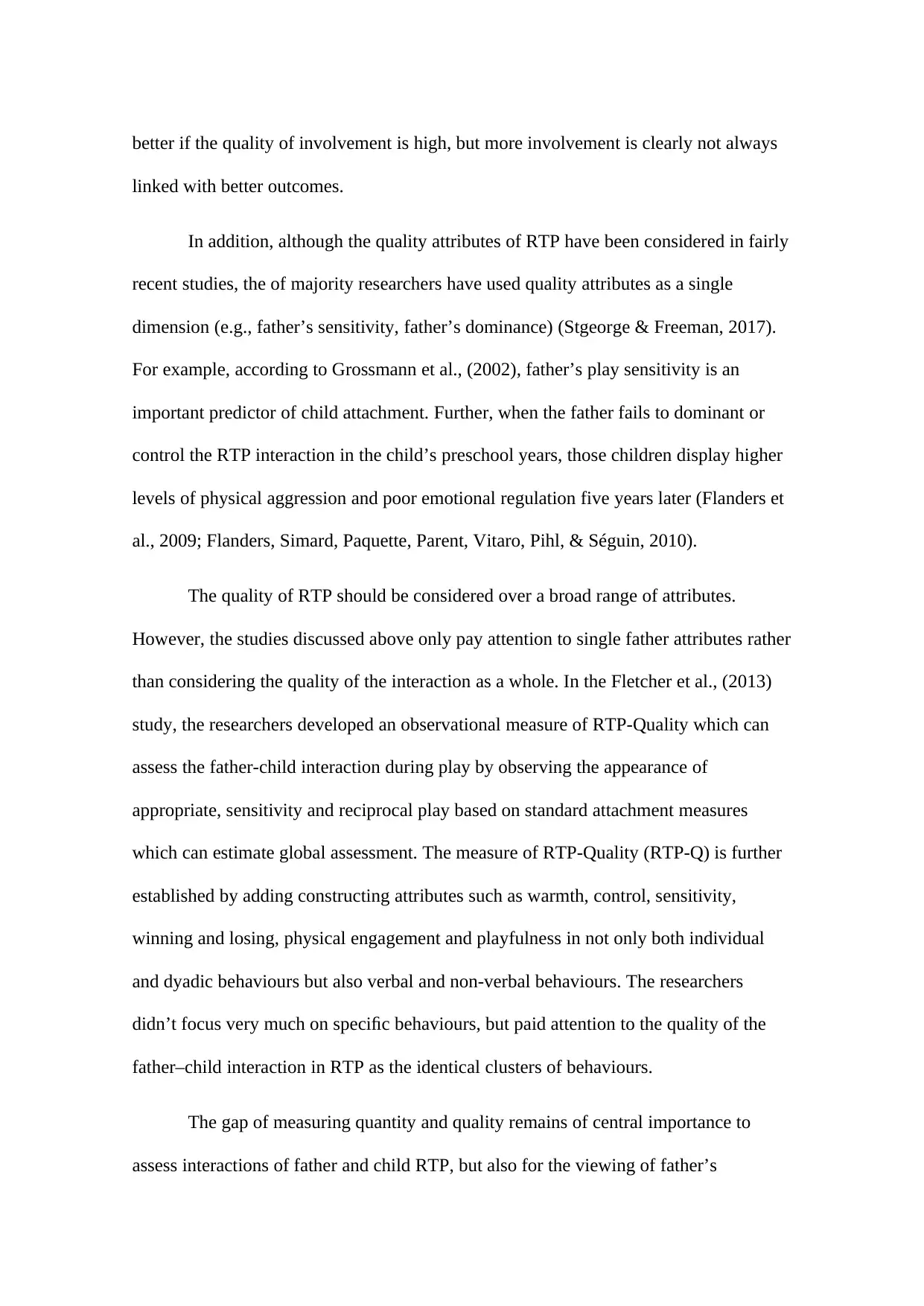
better if the quality of involvement is high, but more involvement is clearly not always
linked with better outcomes.
In addition, although the quality attributes of RTP have been considered in fairly
recent studies, the of majority researchers have used quality attributes as a single
dimension (e.g., father’s sensitivity, father’s dominance) (Stgeorge & Freeman, 2017).
For example, according to Grossmann et al., (2002), father’s play sensitivity is an
important predictor of child attachment. Further, when the father fails to dominant or
control the RTP interaction in the child’s preschool years, those children display higher
levels of physical aggression and poor emotional regulation five years later (Flanders et
al., 2009; Flanders, Simard, Paquette, Parent, Vitaro, Pihl, & Séguin, 2010).
The quality of RTP should be considered over a broad range of attributes.
However, the studies discussed above only pay attention to single father attributes rather
than considering the quality of the interaction as a whole. In the Fletcher et al., (2013)
study, the researchers developed an observational measure of RTP-Quality which can
assess the father-child interaction during play by observing the appearance of
appropriate, sensitivity and reciprocal play based on standard attachment measures
which can estimate global assessment. The measure of RTP-Quality (RTP-Q) is further
established by adding constructing attributes such as warmth, control, sensitivity,
winning and losing, physical engagement and playfulness in not only both individual
and dyadic behaviours but also verbal and non-verbal behaviours. The researchers
didn’t focus very much on specific behaviours, but paid attention to the quality of the
father–child interaction in RTP as the identical clusters of behaviours.
The gap of measuring quantity and quality remains of central importance to
assess interactions of father and child RTP, but also for the viewing of father’s
linked with better outcomes.
In addition, although the quality attributes of RTP have been considered in fairly
recent studies, the of majority researchers have used quality attributes as a single
dimension (e.g., father’s sensitivity, father’s dominance) (Stgeorge & Freeman, 2017).
For example, according to Grossmann et al., (2002), father’s play sensitivity is an
important predictor of child attachment. Further, when the father fails to dominant or
control the RTP interaction in the child’s preschool years, those children display higher
levels of physical aggression and poor emotional regulation five years later (Flanders et
al., 2009; Flanders, Simard, Paquette, Parent, Vitaro, Pihl, & Séguin, 2010).
The quality of RTP should be considered over a broad range of attributes.
However, the studies discussed above only pay attention to single father attributes rather
than considering the quality of the interaction as a whole. In the Fletcher et al., (2013)
study, the researchers developed an observational measure of RTP-Quality which can
assess the father-child interaction during play by observing the appearance of
appropriate, sensitivity and reciprocal play based on standard attachment measures
which can estimate global assessment. The measure of RTP-Quality (RTP-Q) is further
established by adding constructing attributes such as warmth, control, sensitivity,
winning and losing, physical engagement and playfulness in not only both individual
and dyadic behaviours but also verbal and non-verbal behaviours. The researchers
didn’t focus very much on specific behaviours, but paid attention to the quality of the
father–child interaction in RTP as the identical clusters of behaviours.
The gap of measuring quantity and quality remains of central importance to
assess interactions of father and child RTP, but also for the viewing of father’s
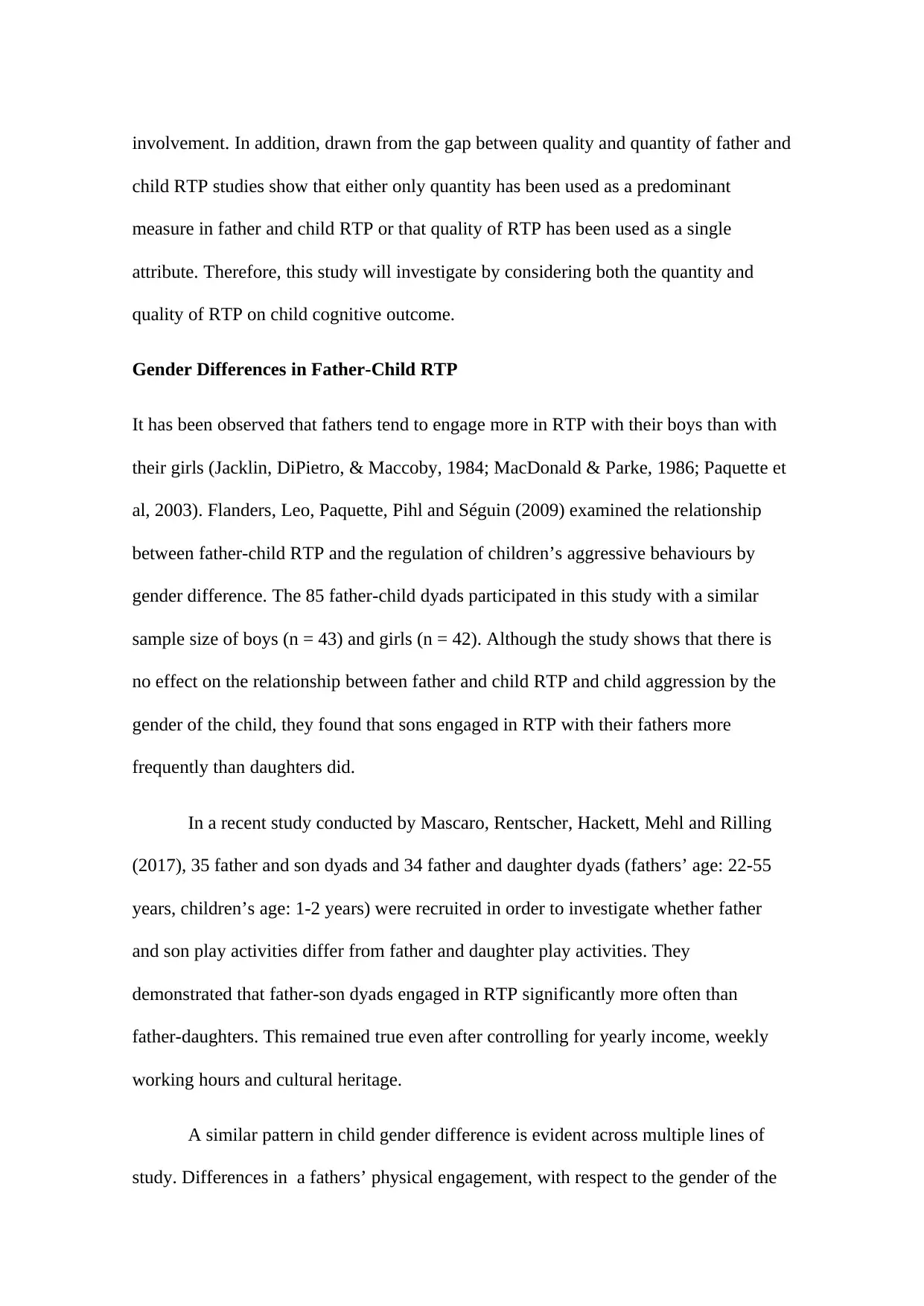
involvement. In addition, drawn from the gap between quality and quantity of father and
child RTP studies show that either only quantity has been used as a predominant
measure in father and child RTP or that quality of RTP has been used as a single
attribute. Therefore, this study will investigate by considering both the quantity and
quality of RTP on child cognitive outcome.
Gender Differences in Father-Child RTP
It has been observed that fathers tend to engage more in RTP with their boys than with
their girls (Jacklin, DiPietro, & Maccoby, 1984; MacDonald & Parke, 1986; Paquette et
al, 2003). Flanders, Leo, Paquette, Pihl and Séguin (2009) examined the relationship
between father-child RTP and the regulation of children’s aggressive behaviours by
gender difference. The 85 father-child dyads participated in this study with a similar
sample size of boys (n = 43) and girls (n = 42). Although the study shows that there is
no effect on the relationship between father and child RTP and child aggression by the
gender of the child, they found that sons engaged in RTP with their fathers more
frequently than daughters did.
In a recent study conducted by Mascaro, Rentscher, Hackett, Mehl and Rilling
(2017), 35 father and son dyads and 34 father and daughter dyads (fathers’ age: 22-55
years, children’s age: 1-2 years) were recruited in order to investigate whether father
and son play activities differ from father and daughter play activities. They
demonstrated that father-son dyads engaged in RTP significantly more often than
father-daughters. This remained true even after controlling for yearly income, weekly
working hours and cultural heritage.
A similar pattern in child gender difference is evident across multiple lines of
study. Differences in a fathers’ physical engagement, with respect to the gender of the
child RTP studies show that either only quantity has been used as a predominant
measure in father and child RTP or that quality of RTP has been used as a single
attribute. Therefore, this study will investigate by considering both the quantity and
quality of RTP on child cognitive outcome.
Gender Differences in Father-Child RTP
It has been observed that fathers tend to engage more in RTP with their boys than with
their girls (Jacklin, DiPietro, & Maccoby, 1984; MacDonald & Parke, 1986; Paquette et
al, 2003). Flanders, Leo, Paquette, Pihl and Séguin (2009) examined the relationship
between father-child RTP and the regulation of children’s aggressive behaviours by
gender difference. The 85 father-child dyads participated in this study with a similar
sample size of boys (n = 43) and girls (n = 42). Although the study shows that there is
no effect on the relationship between father and child RTP and child aggression by the
gender of the child, they found that sons engaged in RTP with their fathers more
frequently than daughters did.
In a recent study conducted by Mascaro, Rentscher, Hackett, Mehl and Rilling
(2017), 35 father and son dyads and 34 father and daughter dyads (fathers’ age: 22-55
years, children’s age: 1-2 years) were recruited in order to investigate whether father
and son play activities differ from father and daughter play activities. They
demonstrated that father-son dyads engaged in RTP significantly more often than
father-daughters. This remained true even after controlling for yearly income, weekly
working hours and cultural heritage.
A similar pattern in child gender difference is evident across multiple lines of
study. Differences in a fathers’ physical engagement, with respect to the gender of the
Secure Best Marks with AI Grader
Need help grading? Try our AI Grader for instant feedback on your assignments.
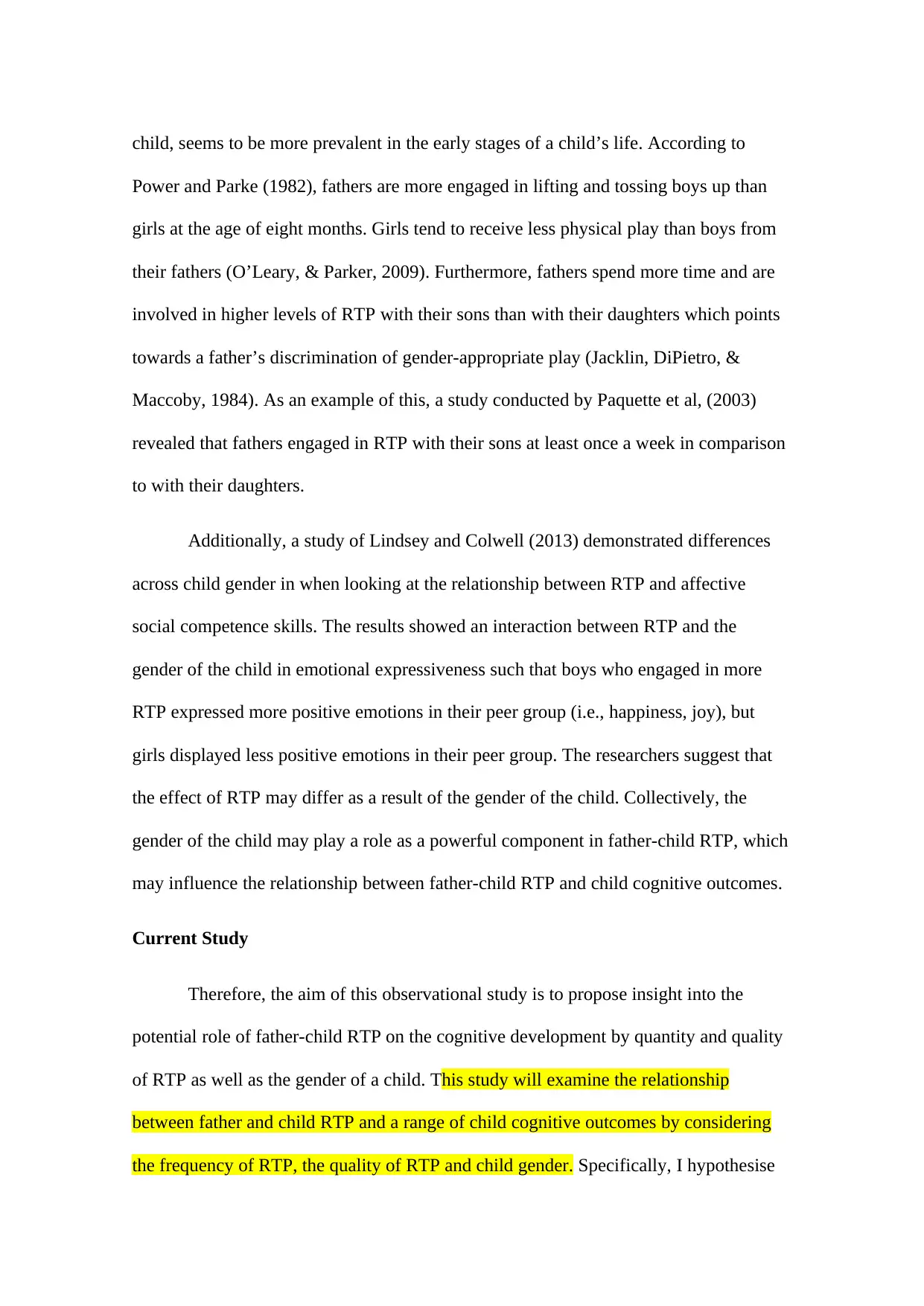
child, seems to be more prevalent in the early stages of a child’s life. According to
Power and Parke (1982), fathers are more engaged in lifting and tossing boys up than
girls at the age of eight months. Girls tend to receive less physical play than boys from
their fathers (O’Leary, & Parker, 2009). Furthermore, fathers spend more time and are
involved in higher levels of RTP with their sons than with their daughters which points
towards a father’s discrimination of gender-appropriate play (Jacklin, DiPietro, &
Maccoby, 1984). As an example of this, a study conducted by Paquette et al, (2003)
revealed that fathers engaged in RTP with their sons at least once a week in comparison
to with their daughters.
Additionally, a study of Lindsey and Colwell (2013) demonstrated differences
across child gender in when looking at the relationship between RTP and affective
social competence skills. The results showed an interaction between RTP and the
gender of the child in emotional expressiveness such that boys who engaged in more
RTP expressed more positive emotions in their peer group (i.e., happiness, joy), but
girls displayed less positive emotions in their peer group. The researchers suggest that
the effect of RTP may differ as a result of the gender of the child. Collectively, the
gender of the child may play a role as a powerful component in father-child RTP, which
may influence the relationship between father-child RTP and child cognitive outcomes.
Current Study
Therefore, the aim of this observational study is to propose insight into the
potential role of father-child RTP on the cognitive development by quantity and quality
of RTP as well as the gender of a child. This study will examine the relationship
between father and child RTP and a range of child cognitive outcomes by considering
the frequency of RTP, the quality of RTP and child gender. Specifically, I hypothesise
Power and Parke (1982), fathers are more engaged in lifting and tossing boys up than
girls at the age of eight months. Girls tend to receive less physical play than boys from
their fathers (O’Leary, & Parker, 2009). Furthermore, fathers spend more time and are
involved in higher levels of RTP with their sons than with their daughters which points
towards a father’s discrimination of gender-appropriate play (Jacklin, DiPietro, &
Maccoby, 1984). As an example of this, a study conducted by Paquette et al, (2003)
revealed that fathers engaged in RTP with their sons at least once a week in comparison
to with their daughters.
Additionally, a study of Lindsey and Colwell (2013) demonstrated differences
across child gender in when looking at the relationship between RTP and affective
social competence skills. The results showed an interaction between RTP and the
gender of the child in emotional expressiveness such that boys who engaged in more
RTP expressed more positive emotions in their peer group (i.e., happiness, joy), but
girls displayed less positive emotions in their peer group. The researchers suggest that
the effect of RTP may differ as a result of the gender of the child. Collectively, the
gender of the child may play a role as a powerful component in father-child RTP, which
may influence the relationship between father-child RTP and child cognitive outcomes.
Current Study
Therefore, the aim of this observational study is to propose insight into the
potential role of father-child RTP on the cognitive development by quantity and quality
of RTP as well as the gender of a child. This study will examine the relationship
between father and child RTP and a range of child cognitive outcomes by considering
the frequency of RTP, the quality of RTP and child gender. Specifically, I hypothesise
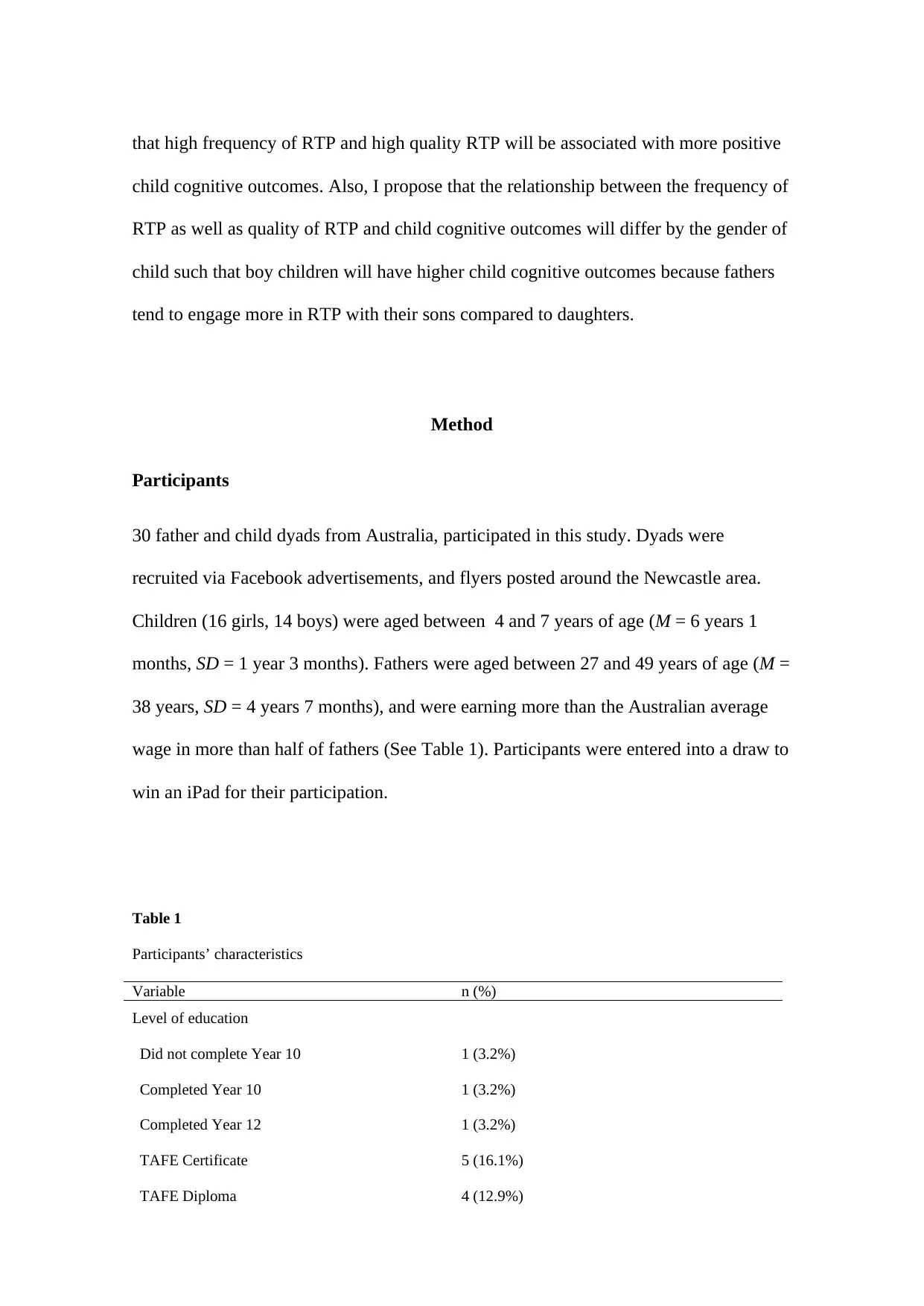
that high frequency of RTP and high quality RTP will be associated with more positive
child cognitive outcomes. Also, I propose that the relationship between the frequency of
RTP as well as quality of RTP and child cognitive outcomes will differ by the gender of
child such that boy children will have higher child cognitive outcomes because fathers
tend to engage more in RTP with their sons compared to daughters.
Method
Participants
30 father and child dyads from Australia, participated in this study. Dyads were
recruited via Facebook advertisements, and flyers posted around the Newcastle area.
Children (16 girls, 14 boys) were aged between 4 and 7 years of age (M = 6 years 1
months, SD = 1 year 3 months). Fathers were aged between 27 and 49 years of age (M =
38 years, SD = 4 years 7 months), and were earning more than the Australian average
wage in more than half of fathers (See Table 1). Participants were entered into a draw to
win an iPad for their participation.
Table 1
Participants’ characteristics
Variable n (%)
Level of education
Did not complete Year 10 1 (3.2%)
Completed Year 10 1 (3.2%)
Completed Year 12 1 (3.2%)
TAFE Certificate 5 (16.1%)
TAFE Diploma 4 (12.9%)
child cognitive outcomes. Also, I propose that the relationship between the frequency of
RTP as well as quality of RTP and child cognitive outcomes will differ by the gender of
child such that boy children will have higher child cognitive outcomes because fathers
tend to engage more in RTP with their sons compared to daughters.
Method
Participants
30 father and child dyads from Australia, participated in this study. Dyads were
recruited via Facebook advertisements, and flyers posted around the Newcastle area.
Children (16 girls, 14 boys) were aged between 4 and 7 years of age (M = 6 years 1
months, SD = 1 year 3 months). Fathers were aged between 27 and 49 years of age (M =
38 years, SD = 4 years 7 months), and were earning more than the Australian average
wage in more than half of fathers (See Table 1). Participants were entered into a draw to
win an iPad for their participation.
Table 1
Participants’ characteristics
Variable n (%)
Level of education
Did not complete Year 10 1 (3.2%)
Completed Year 10 1 (3.2%)
Completed Year 12 1 (3.2%)
TAFE Certificate 5 (16.1%)
TAFE Diploma 4 (12.9%)
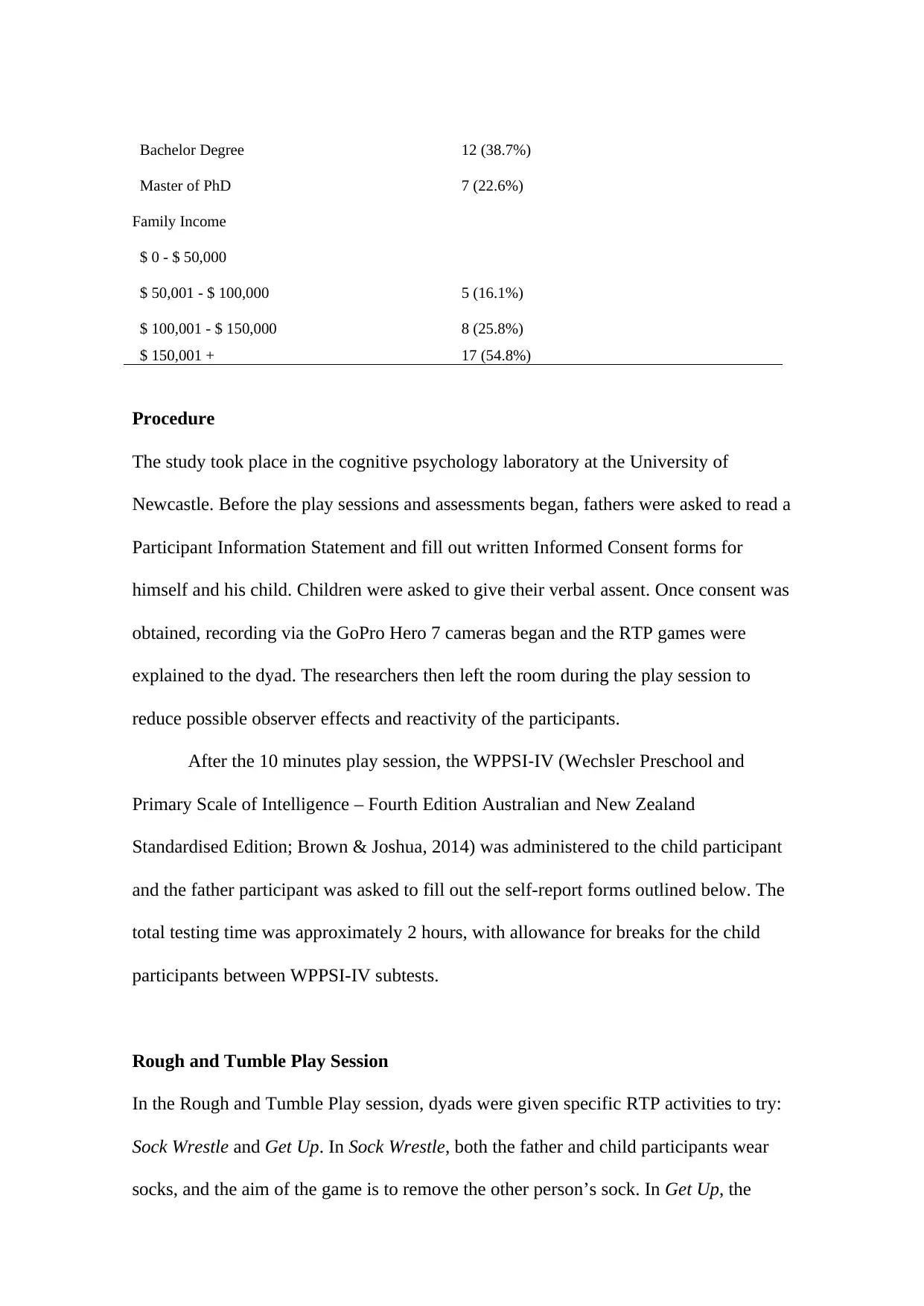
Bachelor Degree 12 (38.7%)
Master of PhD 7 (22.6%)
Family Income
$ 0 - $ 50,000
$ 50,001 - $ 100,000 5 (16.1%)
$ 100,001 - $ 150,000 8 (25.8%)
$ 150,001 + 17 (54.8%)
Procedure
The study took place in the cognitive psychology laboratory at the University of
Newcastle. Before the play sessions and assessments began, fathers were asked to read a
Participant Information Statement and fill out written Informed Consent forms for
himself and his child. Children were asked to give their verbal assent. Once consent was
obtained, recording via the GoPro Hero 7 cameras began and the RTP games were
explained to the dyad. The researchers then left the room during the play session to
reduce possible observer effects and reactivity of the participants.
After the 10 minutes play session, the WPPSI-IV (Wechsler Preschool and
Primary Scale of Intelligence – Fourth Edition Australian and New Zealand
Standardised Edition; Brown & Joshua, 2014) was administered to the child participant
and the father participant was asked to fill out the self-report forms outlined below. The
total testing time was approximately 2 hours, with allowance for breaks for the child
participants between WPPSI-IV subtests.
Rough and Tumble Play Session
In the Rough and Tumble Play session, dyads were given specific RTP activities to try:
Sock Wrestle and Get Up. In Sock Wrestle, both the father and child participants wear
socks, and the aim of the game is to remove the other person’s sock. In Get Up, the
Master of PhD 7 (22.6%)
Family Income
$ 0 - $ 50,000
$ 50,001 - $ 100,000 5 (16.1%)
$ 100,001 - $ 150,000 8 (25.8%)
$ 150,001 + 17 (54.8%)
Procedure
The study took place in the cognitive psychology laboratory at the University of
Newcastle. Before the play sessions and assessments began, fathers were asked to read a
Participant Information Statement and fill out written Informed Consent forms for
himself and his child. Children were asked to give their verbal assent. Once consent was
obtained, recording via the GoPro Hero 7 cameras began and the RTP games were
explained to the dyad. The researchers then left the room during the play session to
reduce possible observer effects and reactivity of the participants.
After the 10 minutes play session, the WPPSI-IV (Wechsler Preschool and
Primary Scale of Intelligence – Fourth Edition Australian and New Zealand
Standardised Edition; Brown & Joshua, 2014) was administered to the child participant
and the father participant was asked to fill out the self-report forms outlined below. The
total testing time was approximately 2 hours, with allowance for breaks for the child
participants between WPPSI-IV subtests.
Rough and Tumble Play Session
In the Rough and Tumble Play session, dyads were given specific RTP activities to try:
Sock Wrestle and Get Up. In Sock Wrestle, both the father and child participants wear
socks, and the aim of the game is to remove the other person’s sock. In Get Up, the
Paraphrase This Document
Need a fresh take? Get an instant paraphrase of this document with our AI Paraphraser
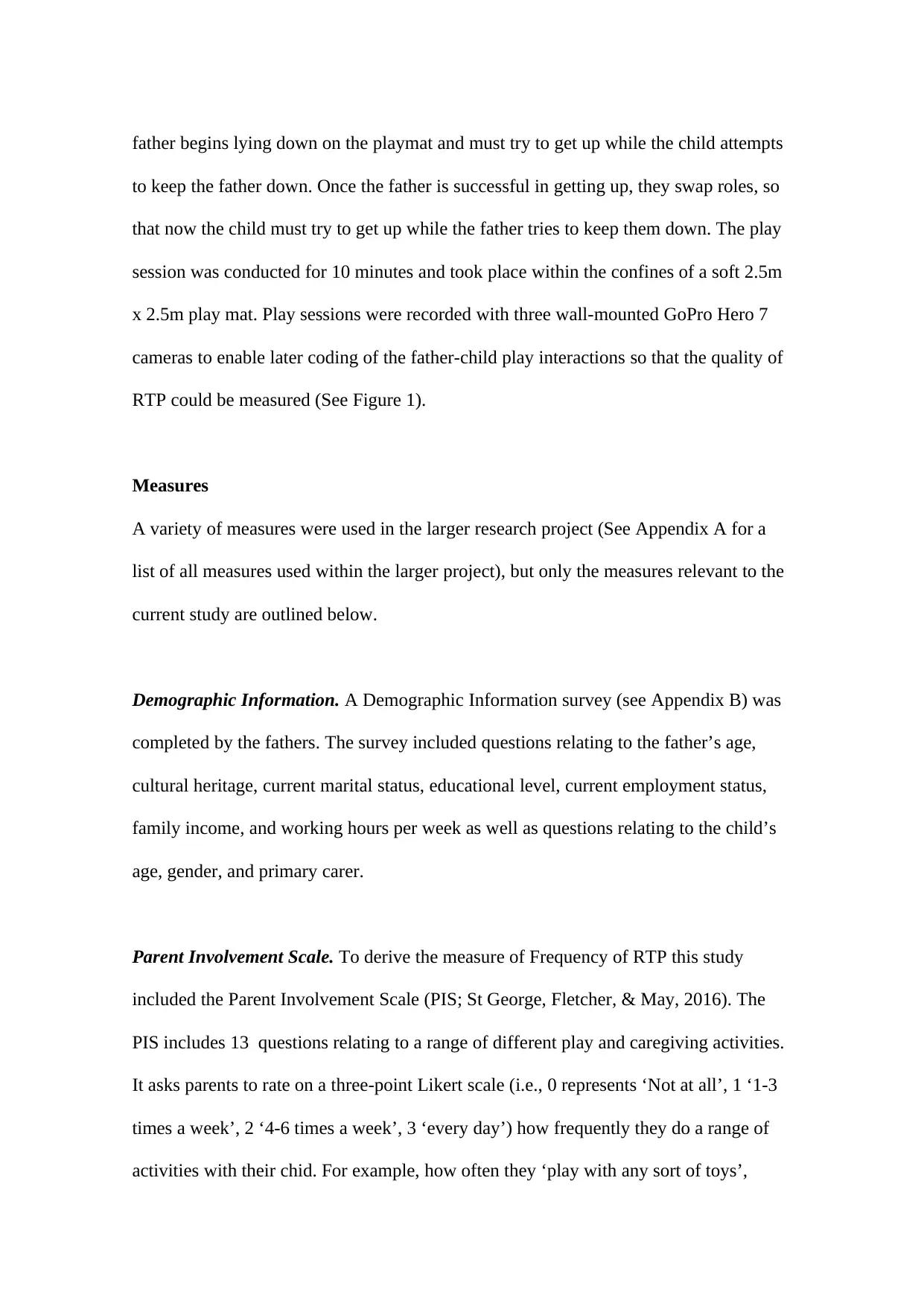
father begins lying down on the playmat and must try to get up while the child attempts
to keep the father down. Once the father is successful in getting up, they swap roles, so
that now the child must try to get up while the father tries to keep them down. The play
session was conducted for 10 minutes and took place within the confines of a soft 2.5m
x 2.5m play mat. Play sessions were recorded with three wall-mounted GoPro Hero 7
cameras to enable later coding of the father-child play interactions so that the quality of
RTP could be measured (See Figure 1).
Measures
A variety of measures were used in the larger research project (See Appendix A for a
list of all measures used within the larger project), but only the measures relevant to the
current study are outlined below.
Demographic Information. A Demographic Information survey (see Appendix B) was
completed by the fathers. The survey included questions relating to the father’s age,
cultural heritage, current marital status, educational level, current employment status,
family income, and working hours per week as well as questions relating to the child’s
age, gender, and primary carer.
Parent Involvement Scale. To derive the measure of Frequency of RTP this study
included the Parent Involvement Scale (PIS; St George, Fletcher, & May, 2016). The
PIS includes 13 questions relating to a range of different play and caregiving activities.
It asks parents to rate on a three-point Likert scale (i.e., 0 represents ‘Not at all’, 1 ‘1-3
times a week’, 2 ‘4-6 times a week’, 3 ‘every day’) how frequently they do a range of
activities with their chid. For example, how often they ‘play with any sort of toys’,
to keep the father down. Once the father is successful in getting up, they swap roles, so
that now the child must try to get up while the father tries to keep them down. The play
session was conducted for 10 minutes and took place within the confines of a soft 2.5m
x 2.5m play mat. Play sessions were recorded with three wall-mounted GoPro Hero 7
cameras to enable later coding of the father-child play interactions so that the quality of
RTP could be measured (See Figure 1).
Measures
A variety of measures were used in the larger research project (See Appendix A for a
list of all measures used within the larger project), but only the measures relevant to the
current study are outlined below.
Demographic Information. A Demographic Information survey (see Appendix B) was
completed by the fathers. The survey included questions relating to the father’s age,
cultural heritage, current marital status, educational level, current employment status,
family income, and working hours per week as well as questions relating to the child’s
age, gender, and primary carer.
Parent Involvement Scale. To derive the measure of Frequency of RTP this study
included the Parent Involvement Scale (PIS; St George, Fletcher, & May, 2016). The
PIS includes 13 questions relating to a range of different play and caregiving activities.
It asks parents to rate on a three-point Likert scale (i.e., 0 represents ‘Not at all’, 1 ‘1-3
times a week’, 2 ‘4-6 times a week’, 3 ‘every day’) how frequently they do a range of
activities with their chid. For example, how often they ‘play with any sort of toys’,
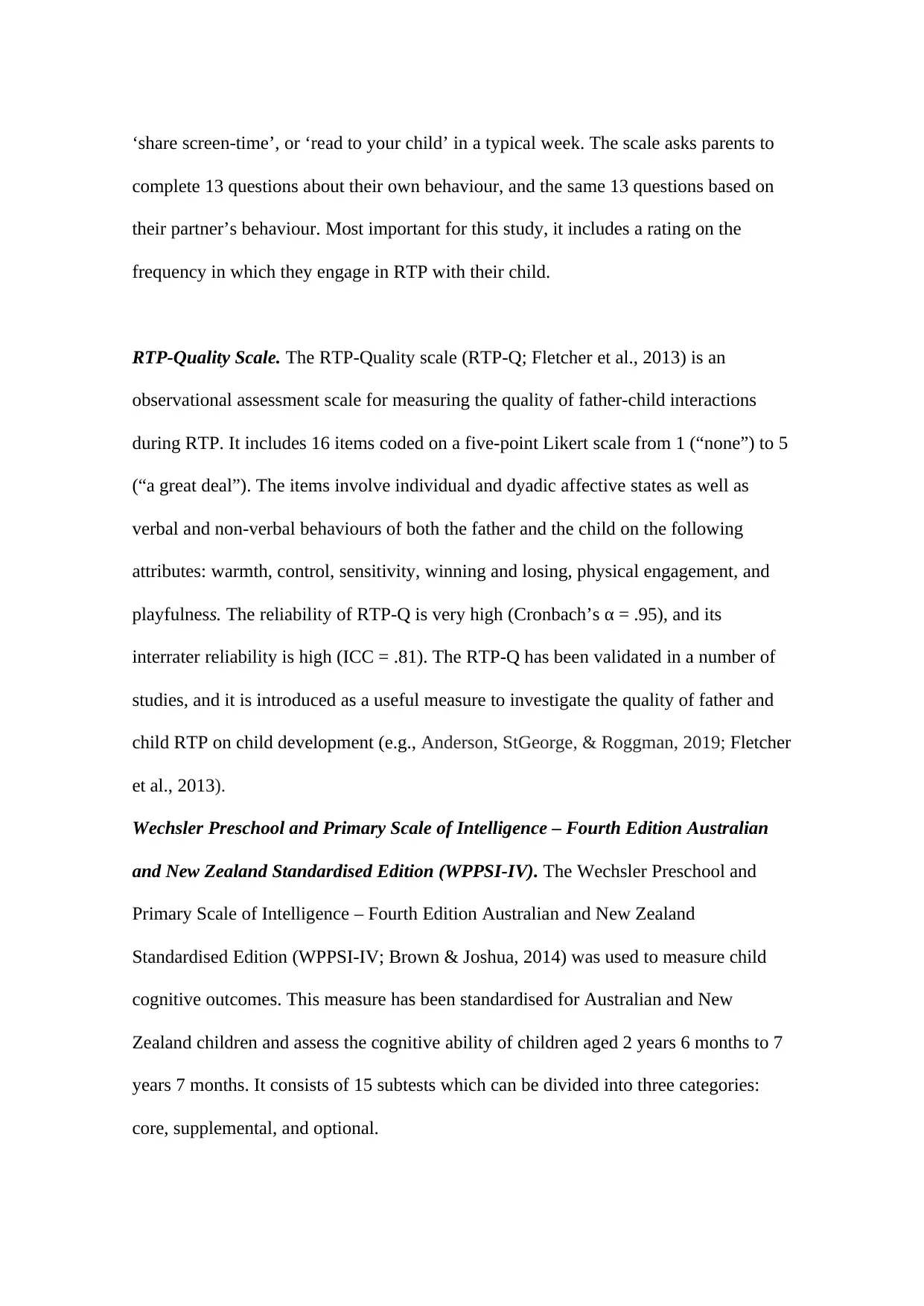
‘share screen-time’, or ‘read to your child’ in a typical week. The scale asks parents to
complete 13 questions about their own behaviour, and the same 13 questions based on
their partner’s behaviour. Most important for this study, it includes a rating on the
frequency in which they engage in RTP with their child.
RTP-Quality Scale. The RTP-Quality scale (RTP-Q; Fletcher et al., 2013) is an
observational assessment scale for measuring the quality of father-child interactions
during RTP. It includes 16 items coded on a five-point Likert scale from 1 (“none”) to 5
(“a great deal”). The items involve individual and dyadic affective states as well as
verbal and non-verbal behaviours of both the father and the child on the following
attributes: warmth, control, sensitivity, winning and losing, physical engagement, and
playfulness. The reliability of RTP-Q is very high (Cronbach’s α = .95), and its
interrater reliability is high (ICC = .81). The RTP-Q has been validated in a number of
studies, and it is introduced as a useful measure to investigate the quality of father and
child RTP on child development (e.g., Anderson, StGeorge, & Roggman, 2019; Fletcher
et al., 2013).
Wechsler Preschool and Primary Scale of Intelligence – Fourth Edition Australian
and New Zealand Standardised Edition (WPPSI-IV). The Wechsler Preschool and
Primary Scale of Intelligence – Fourth Edition Australian and New Zealand
Standardised Edition (WPPSI-IV; Brown & Joshua, 2014) was used to measure child
cognitive outcomes. This measure has been standardised for Australian and New
Zealand children and assess the cognitive ability of children aged 2 years 6 months to 7
years 7 months. It consists of 15 subtests which can be divided into three categories:
core, supplemental, and optional.
complete 13 questions about their own behaviour, and the same 13 questions based on
their partner’s behaviour. Most important for this study, it includes a rating on the
frequency in which they engage in RTP with their child.
RTP-Quality Scale. The RTP-Quality scale (RTP-Q; Fletcher et al., 2013) is an
observational assessment scale for measuring the quality of father-child interactions
during RTP. It includes 16 items coded on a five-point Likert scale from 1 (“none”) to 5
(“a great deal”). The items involve individual and dyadic affective states as well as
verbal and non-verbal behaviours of both the father and the child on the following
attributes: warmth, control, sensitivity, winning and losing, physical engagement, and
playfulness. The reliability of RTP-Q is very high (Cronbach’s α = .95), and its
interrater reliability is high (ICC = .81). The RTP-Q has been validated in a number of
studies, and it is introduced as a useful measure to investigate the quality of father and
child RTP on child development (e.g., Anderson, StGeorge, & Roggman, 2019; Fletcher
et al., 2013).
Wechsler Preschool and Primary Scale of Intelligence – Fourth Edition Australian
and New Zealand Standardised Edition (WPPSI-IV). The Wechsler Preschool and
Primary Scale of Intelligence – Fourth Edition Australian and New Zealand
Standardised Edition (WPPSI-IV; Brown & Joshua, 2014) was used to measure child
cognitive outcomes. This measure has been standardised for Australian and New
Zealand children and assess the cognitive ability of children aged 2 years 6 months to 7
years 7 months. It consists of 15 subtests which can be divided into three categories:
core, supplemental, and optional.
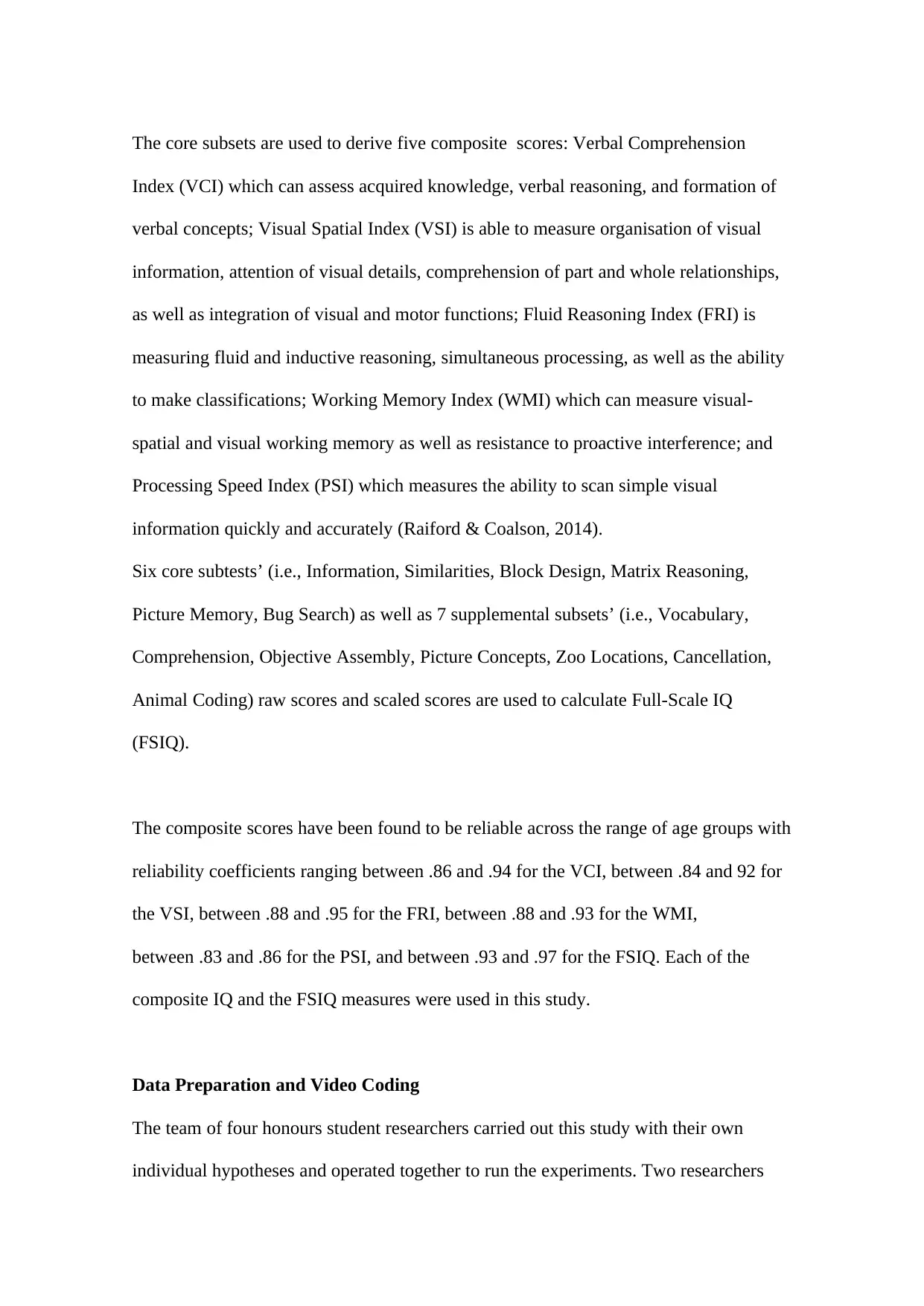
The core subsets are used to derive five composite scores: Verbal Comprehension
Index (VCI) which can assess acquired knowledge, verbal reasoning, and formation of
verbal concepts; Visual Spatial Index (VSI) is able to measure organisation of visual
information, attention of visual details, comprehension of part and whole relationships,
as well as integration of visual and motor functions; Fluid Reasoning Index (FRI) is
measuring fluid and inductive reasoning, simultaneous processing, as well as the ability
to make classifications; Working Memory Index (WMI) which can measure visual-
spatial and visual working memory as well as resistance to proactive interference; and
Processing Speed Index (PSI) which measures the ability to scan simple visual
information quickly and accurately (Raiford & Coalson, 2014).
Six core subtests’ (i.e., Information, Similarities, Block Design, Matrix Reasoning,
Picture Memory, Bug Search) as well as 7 supplemental subsets’ (i.e., Vocabulary,
Comprehension, Objective Assembly, Picture Concepts, Zoo Locations, Cancellation,
Animal Coding) raw scores and scaled scores are used to calculate Full-Scale IQ
(FSIQ).
The composite scores have been found to be reliable across the range of age groups with
reliability coefficients ranging between .86 and .94 for the VCI, between .84 and 92 for
the VSI, between .88 and .95 for the FRI, between .88 and .93 for the WMI,
between .83 and .86 for the PSI, and between .93 and .97 for the FSIQ. Each of the
composite IQ and the FSIQ measures were used in this study.
Data Preparation and Video Coding
The team of four honours student researchers carried out this study with their own
individual hypotheses and operated together to run the experiments. Two researchers
Index (VCI) which can assess acquired knowledge, verbal reasoning, and formation of
verbal concepts; Visual Spatial Index (VSI) is able to measure organisation of visual
information, attention of visual details, comprehension of part and whole relationships,
as well as integration of visual and motor functions; Fluid Reasoning Index (FRI) is
measuring fluid and inductive reasoning, simultaneous processing, as well as the ability
to make classifications; Working Memory Index (WMI) which can measure visual-
spatial and visual working memory as well as resistance to proactive interference; and
Processing Speed Index (PSI) which measures the ability to scan simple visual
information quickly and accurately (Raiford & Coalson, 2014).
Six core subtests’ (i.e., Information, Similarities, Block Design, Matrix Reasoning,
Picture Memory, Bug Search) as well as 7 supplemental subsets’ (i.e., Vocabulary,
Comprehension, Objective Assembly, Picture Concepts, Zoo Locations, Cancellation,
Animal Coding) raw scores and scaled scores are used to calculate Full-Scale IQ
(FSIQ).
The composite scores have been found to be reliable across the range of age groups with
reliability coefficients ranging between .86 and .94 for the VCI, between .84 and 92 for
the VSI, between .88 and .95 for the FRI, between .88 and .93 for the WMI,
between .83 and .86 for the PSI, and between .93 and .97 for the FSIQ. Each of the
composite IQ and the FSIQ measures were used in this study.
Data Preparation and Video Coding
The team of four honours student researchers carried out this study with their own
individual hypotheses and operated together to run the experiments. Two researchers
Secure Best Marks with AI Grader
Need help grading? Try our AI Grader for instant feedback on your assignments.
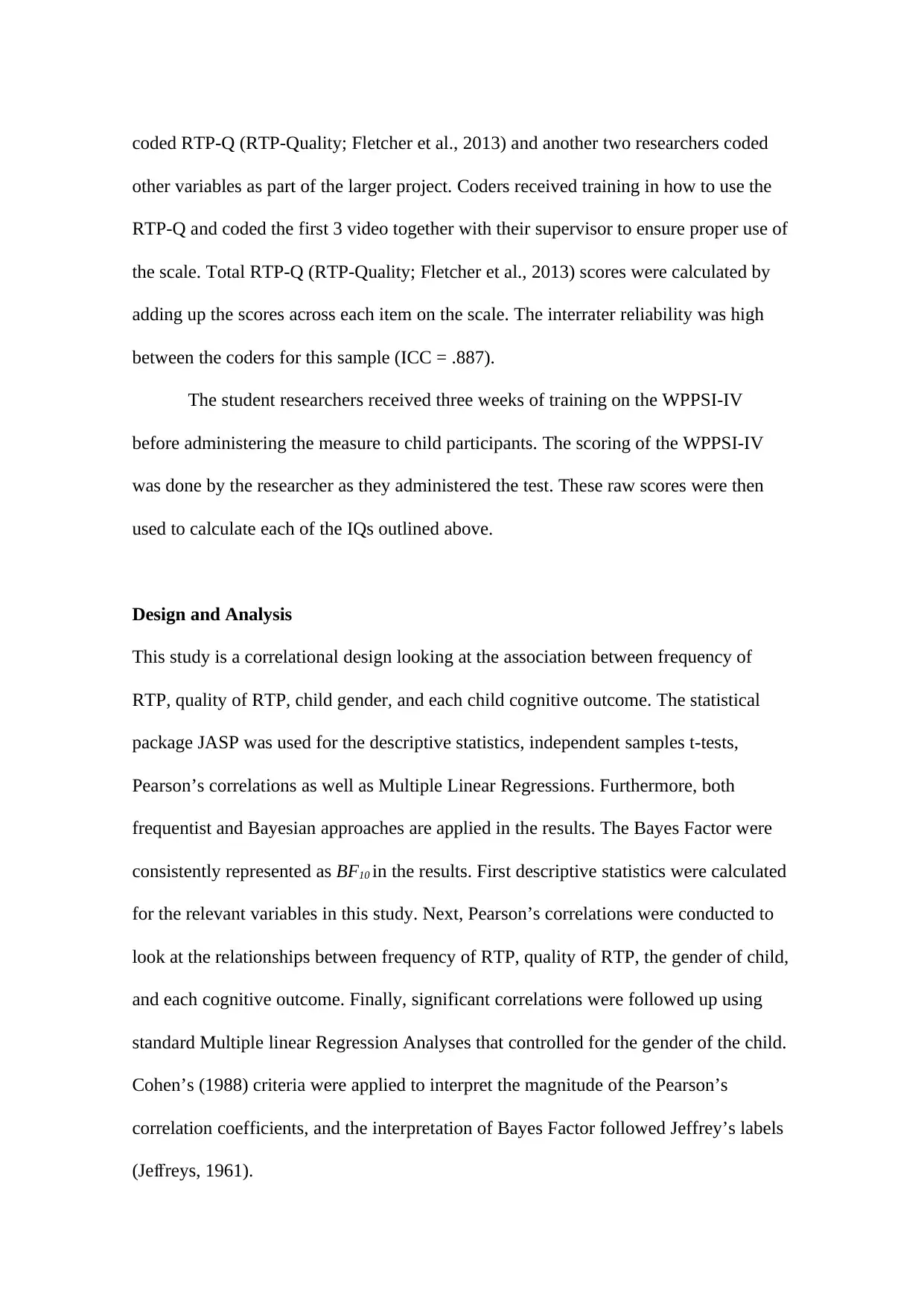
coded RTP-Q (RTP-Quality; Fletcher et al., 2013) and another two researchers coded
other variables as part of the larger project. Coders received training in how to use the
RTP-Q and coded the first 3 video together with their supervisor to ensure proper use of
the scale. Total RTP-Q (RTP-Quality; Fletcher et al., 2013) scores were calculated by
adding up the scores across each item on the scale. The interrater reliability was high
between the coders for this sample (ICC = .887).
The student researchers received three weeks of training on the WPPSI-IV
before administering the measure to child participants. The scoring of the WPPSI-IV
was done by the researcher as they administered the test. These raw scores were then
used to calculate each of the IQs outlined above.
Design and Analysis
This study is a correlational design looking at the association between frequency of
RTP, quality of RTP, child gender, and each child cognitive outcome. The statistical
package JASP was used for the descriptive statistics, independent samples t-tests,
Pearson’s correlations as well as Multiple Linear Regressions. Furthermore, both
frequentist and Bayesian approaches are applied in the results. The Bayes Factor were
consistently represented as BF10 in the results. First descriptive statistics were calculated
for the relevant variables in this study. Next, Pearson’s correlations were conducted to
look at the relationships between frequency of RTP, quality of RTP, the gender of child,
and each cognitive outcome. Finally, significant correlations were followed up using
standard Multiple linear Regression Analyses that controlled for the gender of the child.
Cohen’s (1988) criteria were applied to interpret the magnitude of the Pearson’s
correlation coefficients, and the interpretation of Bayes Factor followed Jeffrey’s labels
(Je reys, 1961).ff
other variables as part of the larger project. Coders received training in how to use the
RTP-Q and coded the first 3 video together with their supervisor to ensure proper use of
the scale. Total RTP-Q (RTP-Quality; Fletcher et al., 2013) scores were calculated by
adding up the scores across each item on the scale. The interrater reliability was high
between the coders for this sample (ICC = .887).
The student researchers received three weeks of training on the WPPSI-IV
before administering the measure to child participants. The scoring of the WPPSI-IV
was done by the researcher as they administered the test. These raw scores were then
used to calculate each of the IQs outlined above.
Design and Analysis
This study is a correlational design looking at the association between frequency of
RTP, quality of RTP, child gender, and each child cognitive outcome. The statistical
package JASP was used for the descriptive statistics, independent samples t-tests,
Pearson’s correlations as well as Multiple Linear Regressions. Furthermore, both
frequentist and Bayesian approaches are applied in the results. The Bayes Factor were
consistently represented as BF10 in the results. First descriptive statistics were calculated
for the relevant variables in this study. Next, Pearson’s correlations were conducted to
look at the relationships between frequency of RTP, quality of RTP, the gender of child,
and each cognitive outcome. Finally, significant correlations were followed up using
standard Multiple linear Regression Analyses that controlled for the gender of the child.
Cohen’s (1988) criteria were applied to interpret the magnitude of the Pearson’s
correlation coefficients, and the interpretation of Bayes Factor followed Jeffrey’s labels
(Je reys, 1961).ff
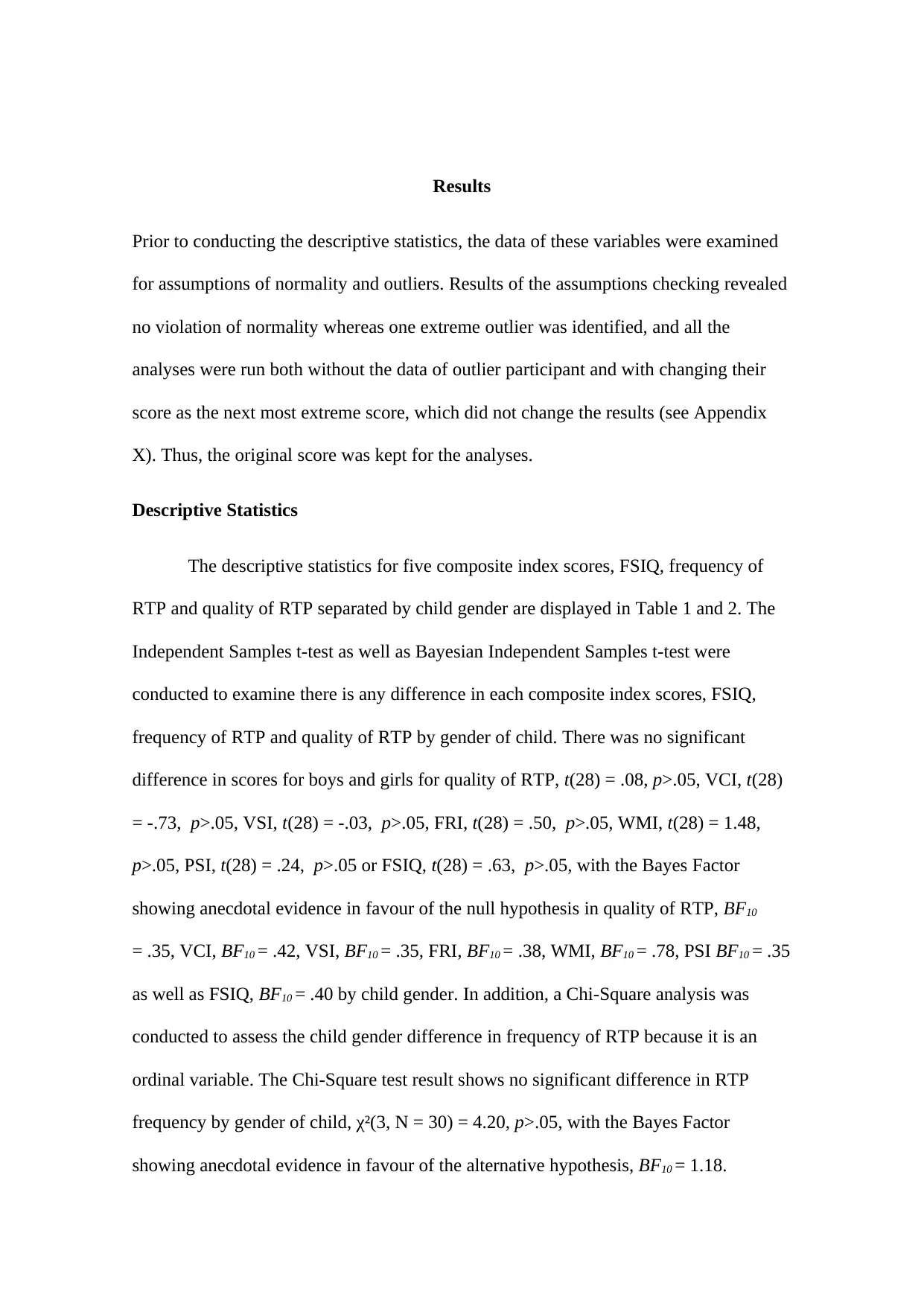
Results
Prior to conducting the descriptive statistics, the data of these variables were examined
for assumptions of normality and outliers. Results of the assumptions checking revealed
no violation of normality whereas one extreme outlier was identified, and all the
analyses were run both without the data of outlier participant and with changing their
score as the next most extreme score, which did not change the results (see Appendix
X). Thus, the original score was kept for the analyses.
Descriptive Statistics
The descriptive statistics for five composite index scores, FSIQ, frequency of
RTP and quality of RTP separated by child gender are displayed in Table 1 and 2. The
Independent Samples t-test as well as Bayesian Independent Samples t-test were
conducted to examine there is any difference in each composite index scores, FSIQ,
frequency of RTP and quality of RTP by gender of child. There was no significant
difference in scores for boys and girls for quality of RTP, t(28) = .08, p>.05, VCI, t(28)
= -.73, p>.05, VSI, t(28) = -.03, p>.05, FRI, t(28) = .50, p>.05, WMI, t(28) = 1.48,
p>.05, PSI, t(28) = .24, p>.05 or FSIQ, t(28) = .63, p>.05, with the Bayes Factor
showing anecdotal evidence in favour of the null hypothesis in quality of RTP, BF10
= .35, VCI, BF10 = .42, VSI, BF10 = .35, FRI, BF10 = .38, WMI, BF10 = .78, PSI BF10 = .35
as well as FSIQ, BF10 = .40 by child gender. In addition, a Chi-Square analysis was
conducted to assess the child gender difference in frequency of RTP because it is an
ordinal variable. The Chi-Square test result shows no significant difference in RTP
frequency by gender of child, χ²(3, N = 30) = 4.20, p>.05, with the Bayes Factor
showing anecdotal evidence in favour of the alternative hypothesis, BF10 = 1.18.
Prior to conducting the descriptive statistics, the data of these variables were examined
for assumptions of normality and outliers. Results of the assumptions checking revealed
no violation of normality whereas one extreme outlier was identified, and all the
analyses were run both without the data of outlier participant and with changing their
score as the next most extreme score, which did not change the results (see Appendix
X). Thus, the original score was kept for the analyses.
Descriptive Statistics
The descriptive statistics for five composite index scores, FSIQ, frequency of
RTP and quality of RTP separated by child gender are displayed in Table 1 and 2. The
Independent Samples t-test as well as Bayesian Independent Samples t-test were
conducted to examine there is any difference in each composite index scores, FSIQ,
frequency of RTP and quality of RTP by gender of child. There was no significant
difference in scores for boys and girls for quality of RTP, t(28) = .08, p>.05, VCI, t(28)
= -.73, p>.05, VSI, t(28) = -.03, p>.05, FRI, t(28) = .50, p>.05, WMI, t(28) = 1.48,
p>.05, PSI, t(28) = .24, p>.05 or FSIQ, t(28) = .63, p>.05, with the Bayes Factor
showing anecdotal evidence in favour of the null hypothesis in quality of RTP, BF10
= .35, VCI, BF10 = .42, VSI, BF10 = .35, FRI, BF10 = .38, WMI, BF10 = .78, PSI BF10 = .35
as well as FSIQ, BF10 = .40 by child gender. In addition, a Chi-Square analysis was
conducted to assess the child gender difference in frequency of RTP because it is an
ordinal variable. The Chi-Square test result shows no significant difference in RTP
frequency by gender of child, χ²(3, N = 30) = 4.20, p>.05, with the Bayes Factor
showing anecdotal evidence in favour of the alternative hypothesis, BF10 = 1.18.
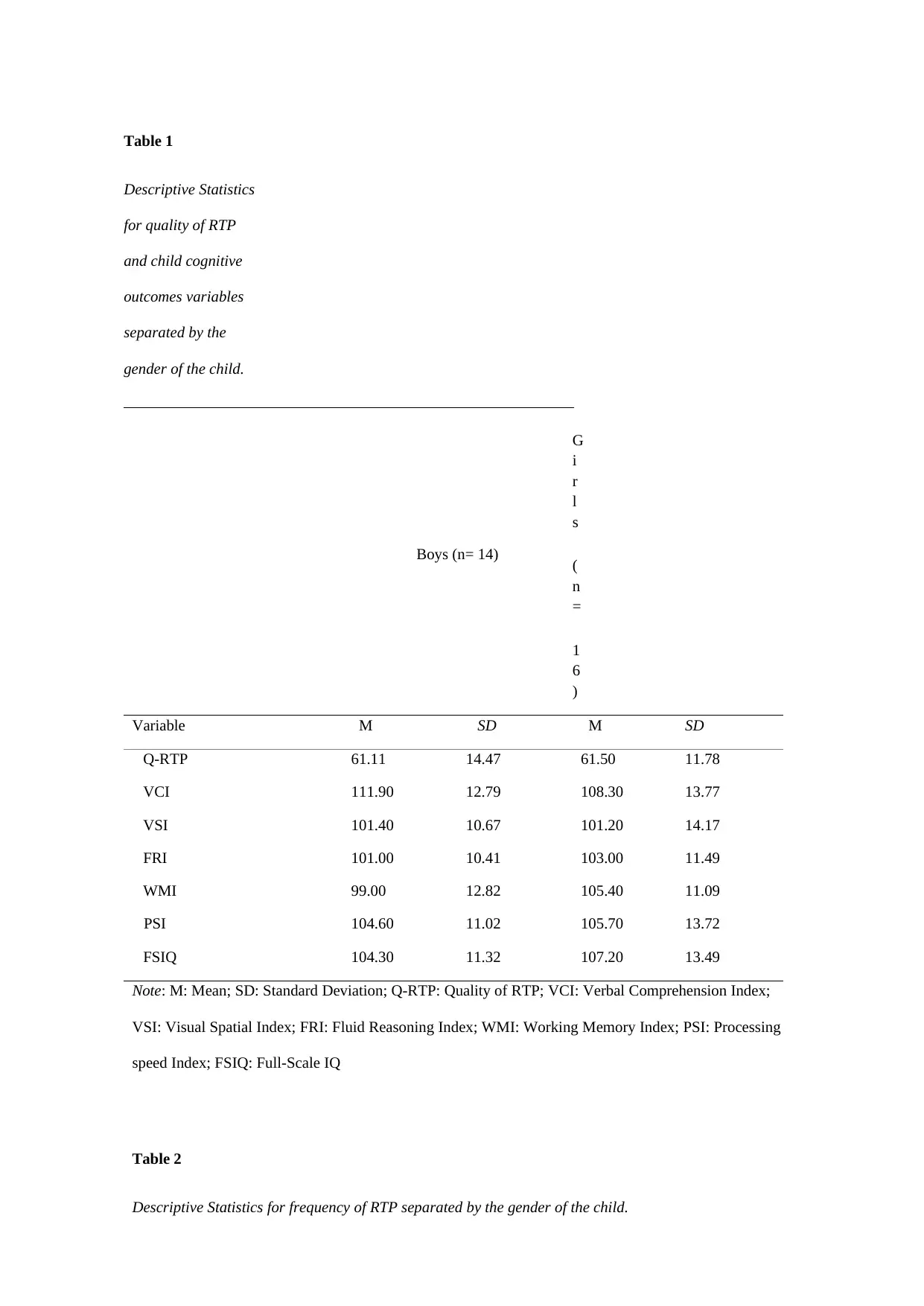
Table 1
Descriptive Statistics
for quality of RTP
and child cognitive
outcomes variables
separated by the
gender of the child.
Boys (n= 14)
G
i
r
l
s
(
n
=
1
6
)
Variable M SD M SD
Q-RTP 61.11 14.47 61.50 11.78
VCI 111.90 12.79 108.30 13.77
VSI 101.40 10.67 101.20 14.17
FRI 101.00 10.41 103.00 11.49
WMI 99.00 12.82 105.40 11.09
PSI 104.60 11.02 105.70 13.72
FSIQ 104.30 11.32 107.20 13.49
Note: M: Mean; SD: Standard Deviation; Q-RTP: Quality of RTP; VCI: Verbal Comprehension Index;
VSI: Visual Spatial Index; FRI: Fluid Reasoning Index; WMI: Working Memory Index; PSI: Processing
speed Index; FSIQ: Full-Scale IQ
Table 2
Descriptive Statistics for frequency of RTP separated by the gender of the child.
Descriptive Statistics
for quality of RTP
and child cognitive
outcomes variables
separated by the
gender of the child.
Boys (n= 14)
G
i
r
l
s
(
n
=
1
6
)
Variable M SD M SD
Q-RTP 61.11 14.47 61.50 11.78
VCI 111.90 12.79 108.30 13.77
VSI 101.40 10.67 101.20 14.17
FRI 101.00 10.41 103.00 11.49
WMI 99.00 12.82 105.40 11.09
PSI 104.60 11.02 105.70 13.72
FSIQ 104.30 11.32 107.20 13.49
Note: M: Mean; SD: Standard Deviation; Q-RTP: Quality of RTP; VCI: Verbal Comprehension Index;
VSI: Visual Spatial Index; FRI: Fluid Reasoning Index; WMI: Working Memory Index; PSI: Processing
speed Index; FSIQ: Full-Scale IQ
Table 2
Descriptive Statistics for frequency of RTP separated by the gender of the child.
Paraphrase This Document
Need a fresh take? Get an instant paraphrase of this document with our AI Paraphraser
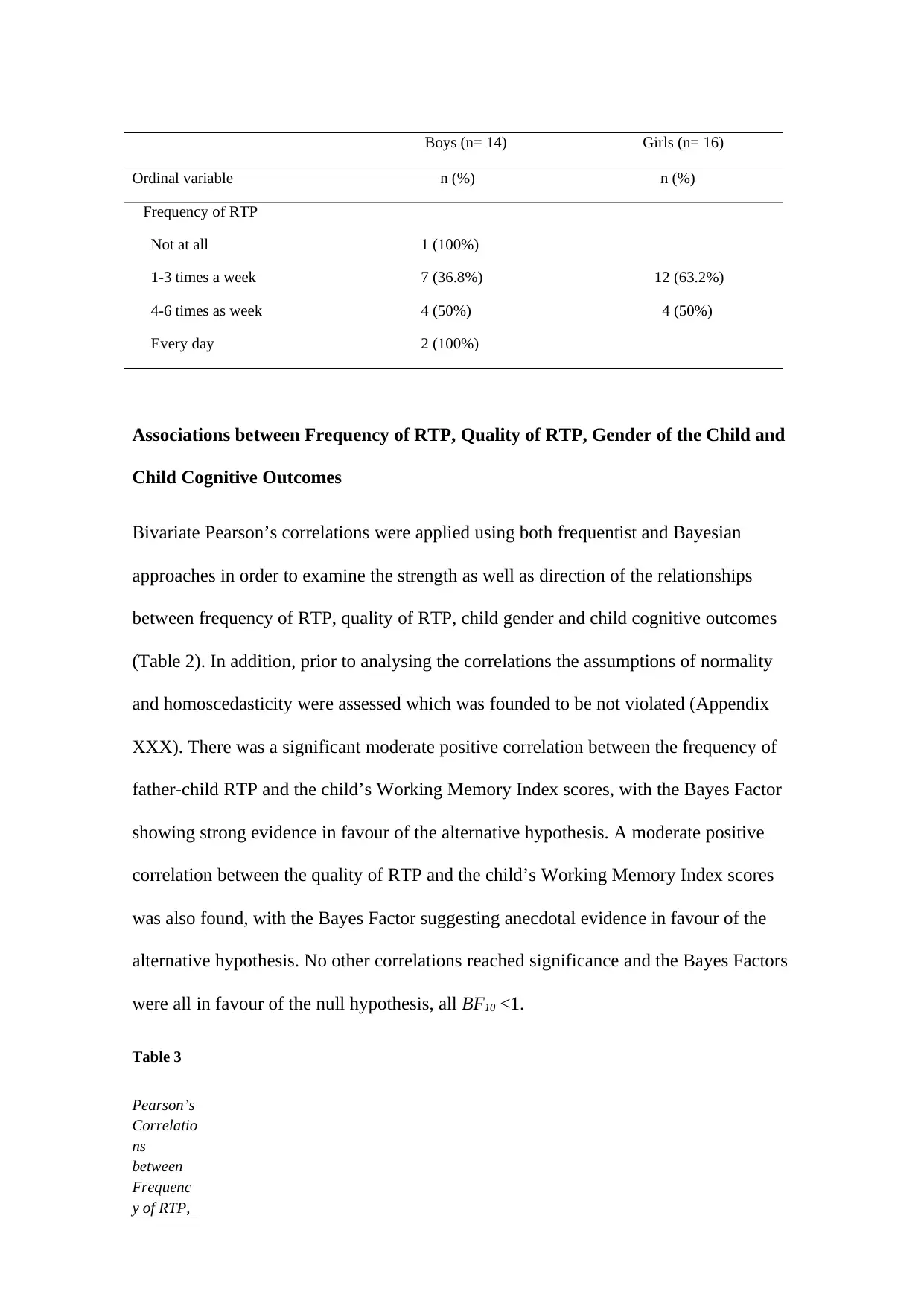
Boys (n= 14) Girls (n= 16)
Ordinal variable n (%) n (%)
Frequency of RTP
Not at all
1-3 times a week
4-6 times as week
Every day
1 (100%)
7 (36.8%)
4 (50%)
2 (100%)
12 (63.2%)
4 (50%)
Associations between Frequency of RTP, Quality of RTP, Gender of the Child and
Child Cognitive Outcomes
Bivariate Pearson’s correlations were applied using both frequentist and Bayesian
approaches in order to examine the strength as well as direction of the relationships
between frequency of RTP, quality of RTP, child gender and child cognitive outcomes
(Table 2). In addition, prior to analysing the correlations the assumptions of normality
and homoscedasticity were assessed which was founded to be not violated (Appendix
XXX). There was a significant moderate positive correlation between the frequency of
father-child RTP and the child’s Working Memory Index scores, with the Bayes Factor
showing strong evidence in favour of the alternative hypothesis. A moderate positive
correlation between the quality of RTP and the child’s Working Memory Index scores
was also found, with the Bayes Factor suggesting anecdotal evidence in favour of the
alternative hypothesis. No other correlations reached significance and the Bayes Factors
were all in favour of the null hypothesis, all BF10 <1.
Table 3
Pearson’s
Correlatio
ns
between
Frequenc
y of RTP,
Ordinal variable n (%) n (%)
Frequency of RTP
Not at all
1-3 times a week
4-6 times as week
Every day
1 (100%)
7 (36.8%)
4 (50%)
2 (100%)
12 (63.2%)
4 (50%)
Associations between Frequency of RTP, Quality of RTP, Gender of the Child and
Child Cognitive Outcomes
Bivariate Pearson’s correlations were applied using both frequentist and Bayesian
approaches in order to examine the strength as well as direction of the relationships
between frequency of RTP, quality of RTP, child gender and child cognitive outcomes
(Table 2). In addition, prior to analysing the correlations the assumptions of normality
and homoscedasticity were assessed which was founded to be not violated (Appendix
XXX). There was a significant moderate positive correlation between the frequency of
father-child RTP and the child’s Working Memory Index scores, with the Bayes Factor
showing strong evidence in favour of the alternative hypothesis. A moderate positive
correlation between the quality of RTP and the child’s Working Memory Index scores
was also found, with the Bayes Factor suggesting anecdotal evidence in favour of the
alternative hypothesis. No other correlations reached significance and the Bayes Factors
were all in favour of the null hypothesis, all BF10 <1.
Table 3
Pearson’s
Correlatio
ns
between
Frequenc
y of RTP,
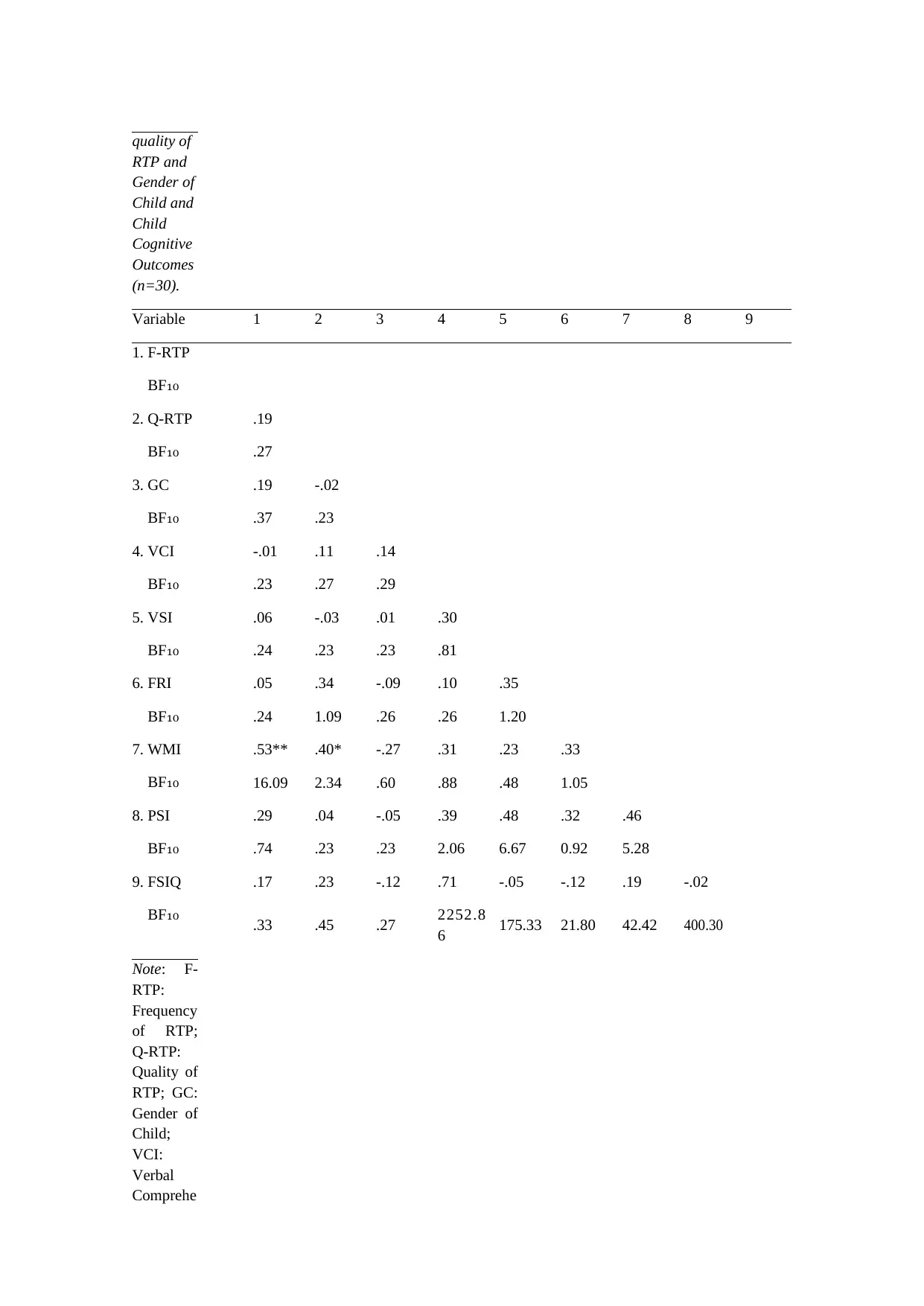
quality of
RTP and
Gender of
Child and
Child
Cognitive
Outcomes
(n=30).
Variable 1 2 3 4 5 6 7 8 9
1. F-RTP
BF₁₀
2. Q-RTP .19
BF₁₀ .27
3. GC .19 -.02
BF₁₀ .37 .23
4. VCI -.01 .11 .14
BF₁₀ .23 .27 .29
5. VSI .06 -.03 .01 .30
BF₁₀ .24 .23 .23 .81
6. FRI .05 .34 -.09 .10 .35
BF₁₀ .24 1.09 .26 .26 1.20
7. WMI .53** .40* -.27 .31 .23 .33
BF₁₀ 16.09 2.34 .60 .88 .48 1.05
8. PSI .29 .04 -.05 .39 .48 .32 .46
BF₁₀ .74 .23 .23 2.06 6.67 0.92 5.28
9. FSIQ .17 .23 -.12 .71 -.05 -.12 .19 -.02
BF₁₀ .33 .45 .27 2252.8
6 175.33 21.80 42.42 400.30
Note: F-
RTP:
Frequency
of RTP;
Q-RTP:
Quality of
RTP; GC:
Gender of
Child;
VCI:
Verbal
Comprehe
RTP and
Gender of
Child and
Child
Cognitive
Outcomes
(n=30).
Variable 1 2 3 4 5 6 7 8 9
1. F-RTP
BF₁₀
2. Q-RTP .19
BF₁₀ .27
3. GC .19 -.02
BF₁₀ .37 .23
4. VCI -.01 .11 .14
BF₁₀ .23 .27 .29
5. VSI .06 -.03 .01 .30
BF₁₀ .24 .23 .23 .81
6. FRI .05 .34 -.09 .10 .35
BF₁₀ .24 1.09 .26 .26 1.20
7. WMI .53** .40* -.27 .31 .23 .33
BF₁₀ 16.09 2.34 .60 .88 .48 1.05
8. PSI .29 .04 -.05 .39 .48 .32 .46
BF₁₀ .74 .23 .23 2.06 6.67 0.92 5.28
9. FSIQ .17 .23 -.12 .71 -.05 -.12 .19 -.02
BF₁₀ .33 .45 .27 2252.8
6 175.33 21.80 42.42 400.30
Note: F-
RTP:
Frequency
of RTP;
Q-RTP:
Quality of
RTP; GC:
Gender of
Child;
VCI:
Verbal
Comprehe
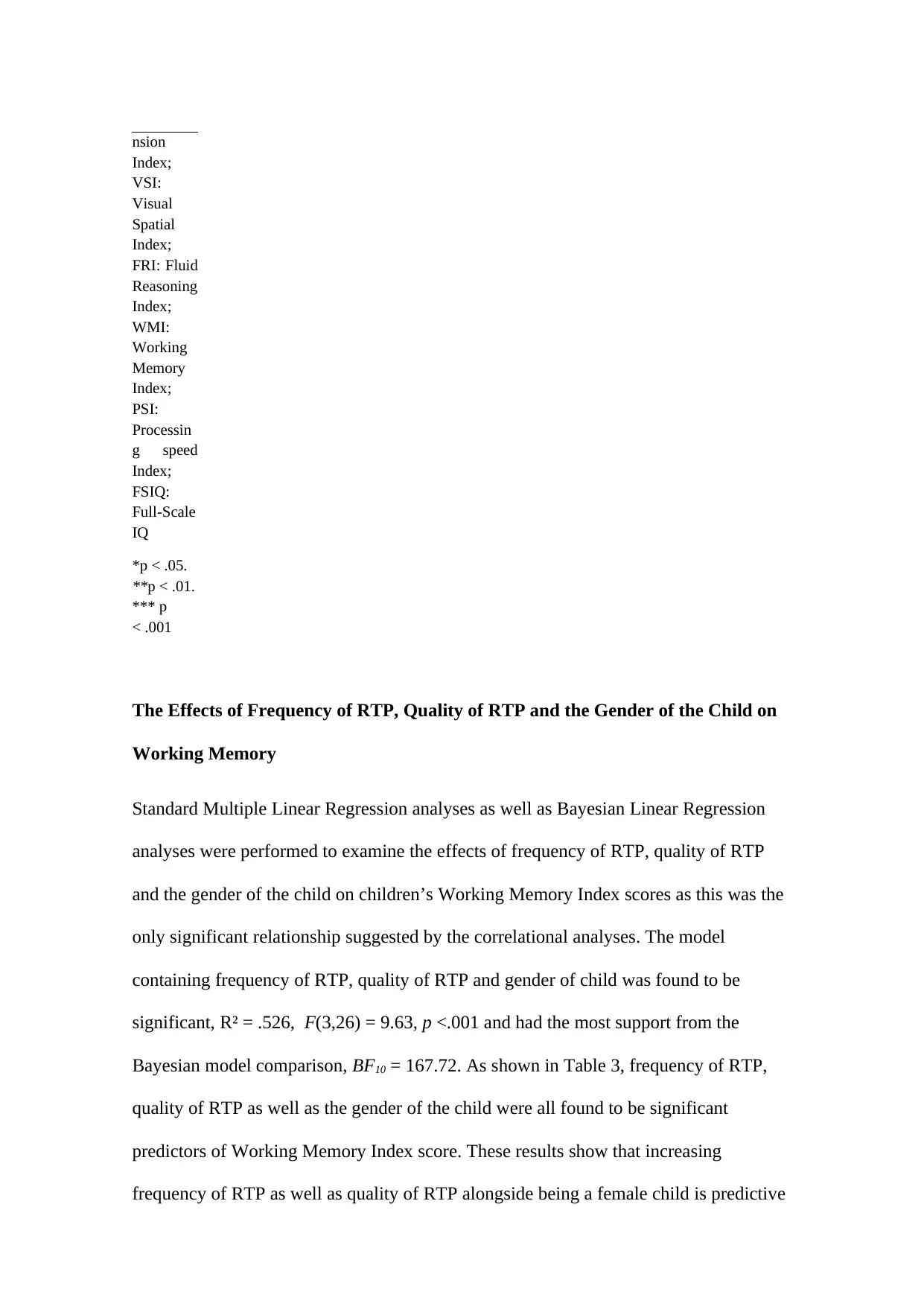
nsion
Index;
VSI:
Visual
Spatial
Index;
FRI: Fluid
Reasoning
Index;
WMI:
Working
Memory
Index;
PSI:
Processin
g speed
Index;
FSIQ:
Full-Scale
IQ
*p < .05.
**p < .01.
*** p
< .001
The Effects of Frequency of RTP, Quality of RTP and the Gender of the Child on
Working Memory
Standard Multiple Linear Regression analyses as well as Bayesian Linear Regression
analyses were performed to examine the effects of frequency of RTP, quality of RTP
and the gender of the child on children’s Working Memory Index scores as this was the
only significant relationship suggested by the correlational analyses. The model
containing frequency of RTP, quality of RTP and gender of child was found to be
significant, R² = .526, F(3,26) = 9.63, p <.001 and had the most support from the
Bayesian model comparison, BF10 = 167.72. As shown in Table 3, frequency of RTP,
quality of RTP as well as the gender of the child were all found to be significant
predictors of Working Memory Index score. These results show that increasing
frequency of RTP as well as quality of RTP alongside being a female child is predictive
Index;
VSI:
Visual
Spatial
Index;
FRI: Fluid
Reasoning
Index;
WMI:
Working
Memory
Index;
PSI:
Processin
g speed
Index;
FSIQ:
Full-Scale
IQ
*p < .05.
**p < .01.
*** p
< .001
The Effects of Frequency of RTP, Quality of RTP and the Gender of the Child on
Working Memory
Standard Multiple Linear Regression analyses as well as Bayesian Linear Regression
analyses were performed to examine the effects of frequency of RTP, quality of RTP
and the gender of the child on children’s Working Memory Index scores as this was the
only significant relationship suggested by the correlational analyses. The model
containing frequency of RTP, quality of RTP and gender of child was found to be
significant, R² = .526, F(3,26) = 9.63, p <.001 and had the most support from the
Bayesian model comparison, BF10 = 167.72. As shown in Table 3, frequency of RTP,
quality of RTP as well as the gender of the child were all found to be significant
predictors of Working Memory Index score. These results show that increasing
frequency of RTP as well as quality of RTP alongside being a female child is predictive
Secure Best Marks with AI Grader
Need help grading? Try our AI Grader for instant feedback on your assignments.
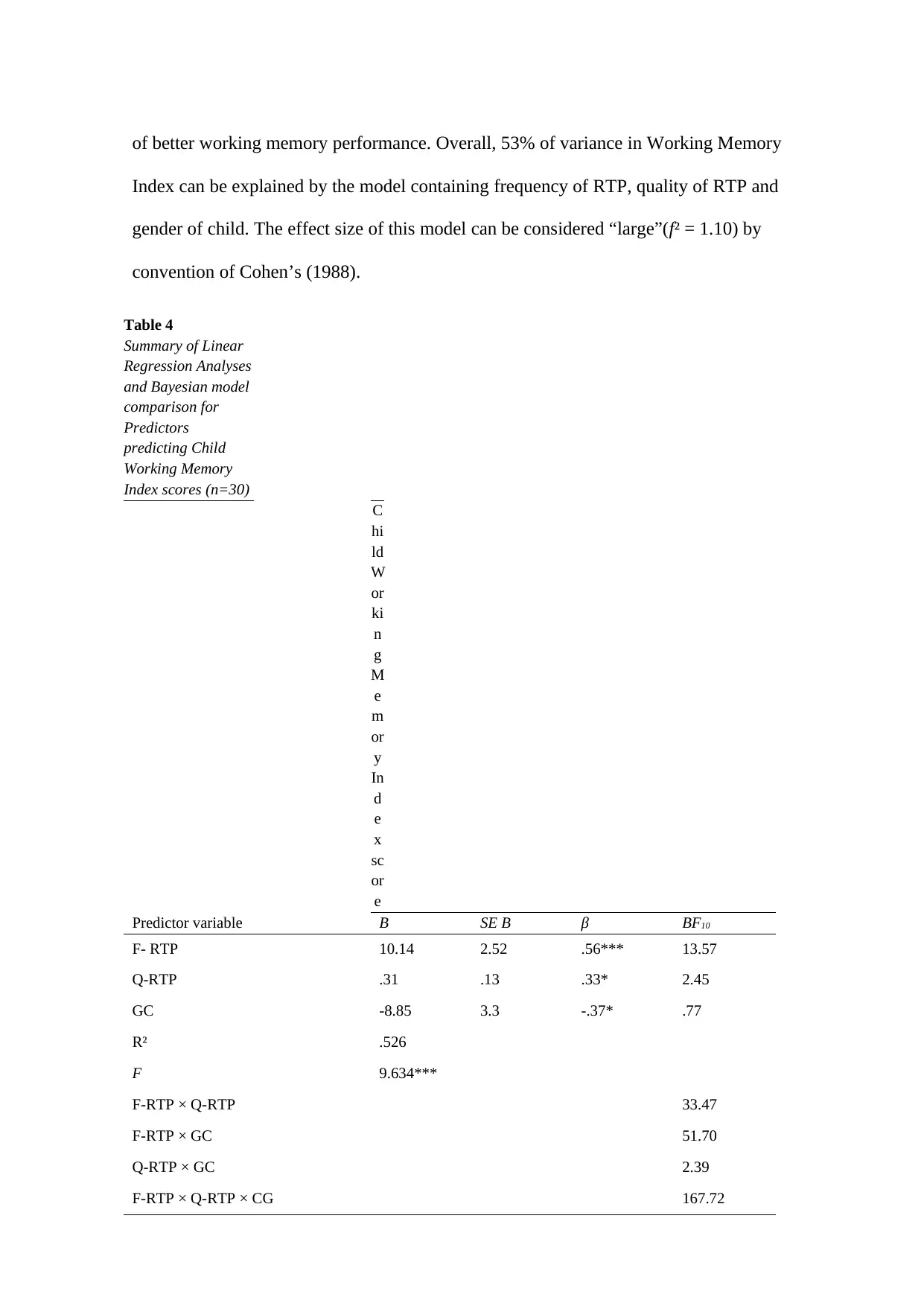
of better working memory performance. Overall, 53% of variance in Working Memory
Index can be explained by the model containing frequency of RTP, quality of RTP and
gender of child. The effect size of this model can be considered “large”(f² = 1.10) by
convention of Cohen’s (1988).
Table 4
Summary of Linear
Regression Analyses
and Bayesian model
comparison for
Predictors
predicting Child
Working Memory
Index scores (n=30)
C
hi
ld
W
or
ki
n
g
M
e
m
or
y
In
d
e
x
sc
or
e
Predictor variable B SE B β BF10
F- RTP 10.14 2.52 .56*** 13.57
Q-RTP .31 .13 .33* 2.45
GC -8.85 3.3 -.37* .77
R² .526
F 9.634***
F-RTP × Q-RTP 33.47
F-RTP × GC 51.70
Q-RTP × GC 2.39
F-RTP × Q-RTP × CG 167.72
Index can be explained by the model containing frequency of RTP, quality of RTP and
gender of child. The effect size of this model can be considered “large”(f² = 1.10) by
convention of Cohen’s (1988).
Table 4
Summary of Linear
Regression Analyses
and Bayesian model
comparison for
Predictors
predicting Child
Working Memory
Index scores (n=30)
C
hi
ld
W
or
ki
n
g
M
e
m
or
y
In
d
e
x
sc
or
e
Predictor variable B SE B β BF10
F- RTP 10.14 2.52 .56*** 13.57
Q-RTP .31 .13 .33* 2.45
GC -8.85 3.3 -.37* .77
R² .526
F 9.634***
F-RTP × Q-RTP 33.47
F-RTP × GC 51.70
Q-RTP × GC 2.39
F-RTP × Q-RTP × CG 167.72

Note: F-RTP: Frequency of RTP; Q-RTP: Quality of RTP; GC: Gender of Child; Gender of Child (1 =
girls, 2 = boys)
*p < .05. *** p < .001
girls, 2 = boys)
*p < .05. *** p < .001

Paraphrase This Document
Need a fresh take? Get an instant paraphrase of this document with our AI Paraphraser
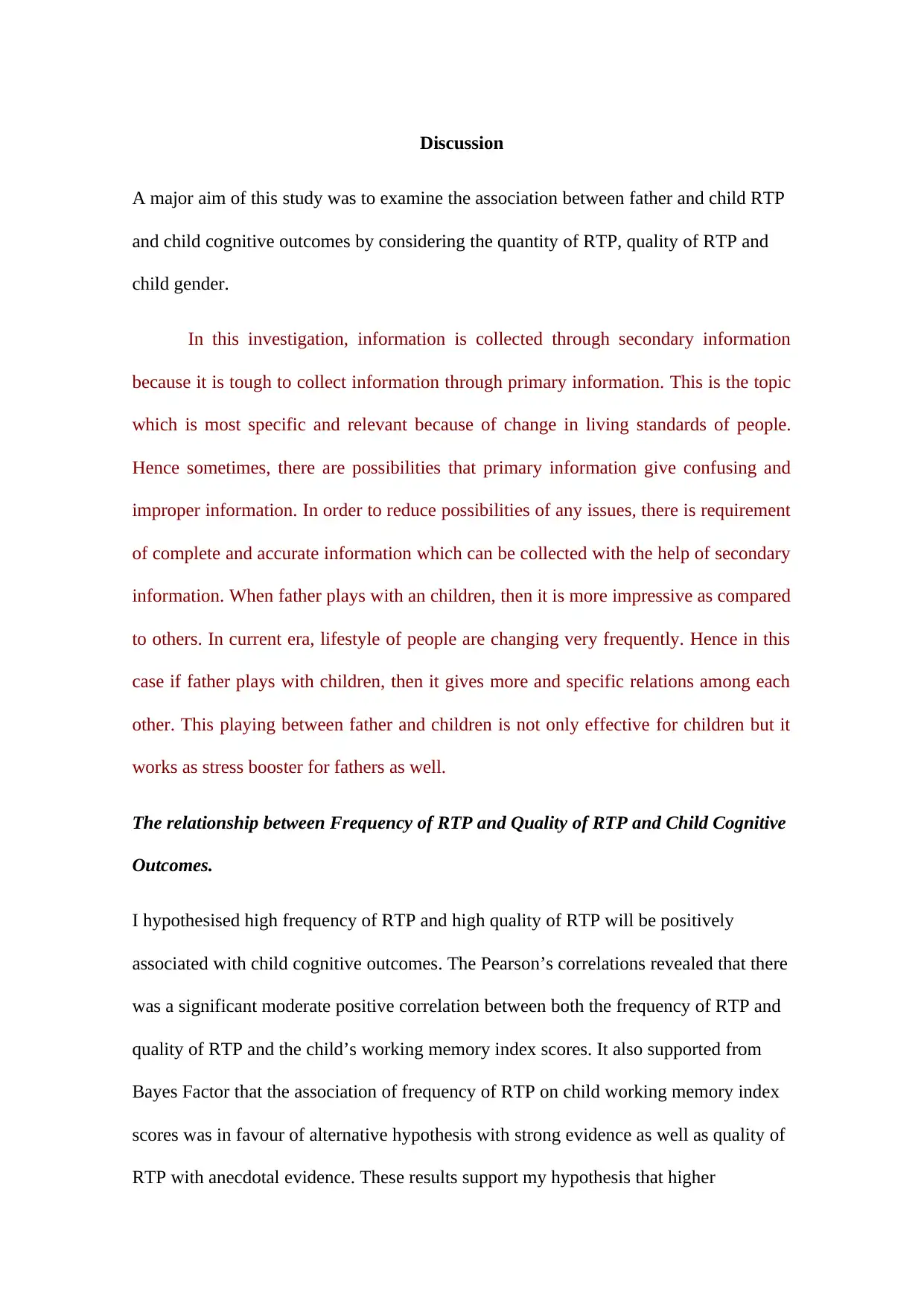
Discussion
A major aim of this study was to examine the association between father and child RTP
and child cognitive outcomes by considering the quantity of RTP, quality of RTP and
child gender.
In this investigation, information is collected through secondary information
because it is tough to collect information through primary information. This is the topic
which is most specific and relevant because of change in living standards of people.
Hence sometimes, there are possibilities that primary information give confusing and
improper information. In order to reduce possibilities of any issues, there is requirement
of complete and accurate information which can be collected with the help of secondary
information. When father plays with an children, then it is more impressive as compared
to others. In current era, lifestyle of people are changing very frequently. Hence in this
case if father plays with children, then it gives more and specific relations among each
other. This playing between father and children is not only effective for children but it
works as stress booster for fathers as well.
The relationship between Frequency of RTP and Quality of RTP and Child Cognitive
Outcomes.
I hypothesised high frequency of RTP and high quality of RTP will be positively
associated with child cognitive outcomes. The Pearson’s correlations revealed that there
was a significant moderate positive correlation between both the frequency of RTP and
quality of RTP and the child’s working memory index scores. It also supported from
Bayes Factor that the association of frequency of RTP on child working memory index
scores was in favour of alternative hypothesis with strong evidence as well as quality of
RTP with anecdotal evidence. These results support my hypothesis that higher
A major aim of this study was to examine the association between father and child RTP
and child cognitive outcomes by considering the quantity of RTP, quality of RTP and
child gender.
In this investigation, information is collected through secondary information
because it is tough to collect information through primary information. This is the topic
which is most specific and relevant because of change in living standards of people.
Hence sometimes, there are possibilities that primary information give confusing and
improper information. In order to reduce possibilities of any issues, there is requirement
of complete and accurate information which can be collected with the help of secondary
information. When father plays with an children, then it is more impressive as compared
to others. In current era, lifestyle of people are changing very frequently. Hence in this
case if father plays with children, then it gives more and specific relations among each
other. This playing between father and children is not only effective for children but it
works as stress booster for fathers as well.
The relationship between Frequency of RTP and Quality of RTP and Child Cognitive
Outcomes.
I hypothesised high frequency of RTP and high quality of RTP will be positively
associated with child cognitive outcomes. The Pearson’s correlations revealed that there
was a significant moderate positive correlation between both the frequency of RTP and
quality of RTP and the child’s working memory index scores. It also supported from
Bayes Factor that the association of frequency of RTP on child working memory index
scores was in favour of alternative hypothesis with strong evidence as well as quality of
RTP with anecdotal evidence. These results support my hypothesis that higher
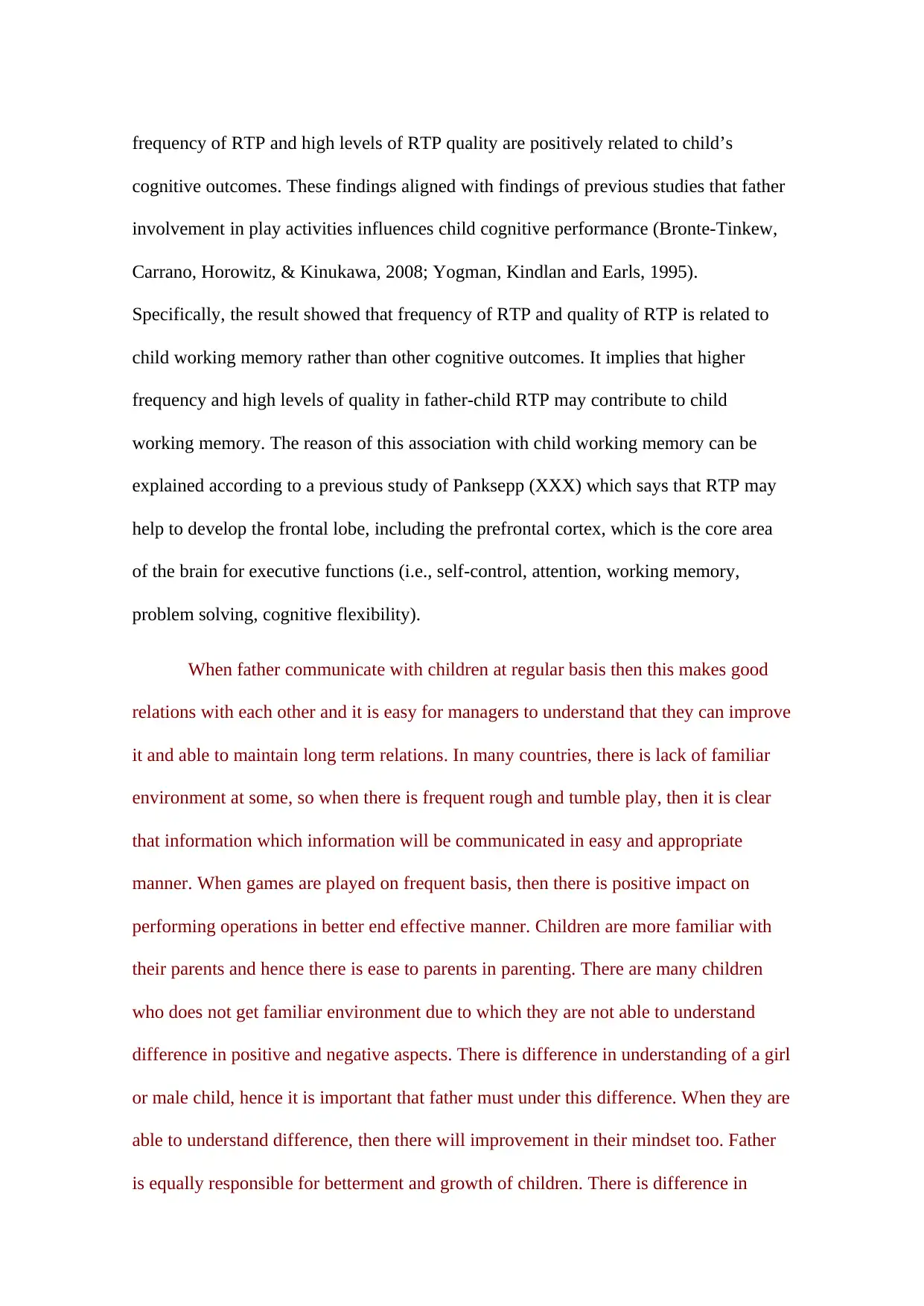
frequency of RTP and high levels of RTP quality are positively related to child’s
cognitive outcomes. These findings aligned with findings of previous studies that father
involvement in play activities influences child cognitive performance (Bronte-Tinkew,
Carrano, Horowitz, & Kinukawa, 2008; Yogman, Kindlan and Earls, 1995).
Specifically, the result showed that frequency of RTP and quality of RTP is related to
child working memory rather than other cognitive outcomes. It implies that higher
frequency and high levels of quality in father-child RTP may contribute to child
working memory. The reason of this association with child working memory can be
explained according to a previous study of Panksepp (XXX) which says that RTP may
help to develop the frontal lobe, including the prefrontal cortex, which is the core area
of the brain for executive functions (i.e., self-control, attention, working memory,
problem solving, cognitive flexibility).
When father communicate with children at regular basis then this makes good
relations with each other and it is easy for managers to understand that they can improve
it and able to maintain long term relations. In many countries, there is lack of familiar
environment at some, so when there is frequent rough and tumble play, then it is clear
that information which information will be communicated in easy and appropriate
manner. When games are played on frequent basis, then there is positive impact on
performing operations in better end effective manner. Children are more familiar with
their parents and hence there is ease to parents in parenting. There are many children
who does not get familiar environment due to which they are not able to understand
difference in positive and negative aspects. There is difference in understanding of a girl
or male child, hence it is important that father must under this difference. When they are
able to understand difference, then there will improvement in their mindset too. Father
is equally responsible for betterment and growth of children. There is difference in
cognitive outcomes. These findings aligned with findings of previous studies that father
involvement in play activities influences child cognitive performance (Bronte-Tinkew,
Carrano, Horowitz, & Kinukawa, 2008; Yogman, Kindlan and Earls, 1995).
Specifically, the result showed that frequency of RTP and quality of RTP is related to
child working memory rather than other cognitive outcomes. It implies that higher
frequency and high levels of quality in father-child RTP may contribute to child
working memory. The reason of this association with child working memory can be
explained according to a previous study of Panksepp (XXX) which says that RTP may
help to develop the frontal lobe, including the prefrontal cortex, which is the core area
of the brain for executive functions (i.e., self-control, attention, working memory,
problem solving, cognitive flexibility).
When father communicate with children at regular basis then this makes good
relations with each other and it is easy for managers to understand that they can improve
it and able to maintain long term relations. In many countries, there is lack of familiar
environment at some, so when there is frequent rough and tumble play, then it is clear
that information which information will be communicated in easy and appropriate
manner. When games are played on frequent basis, then there is positive impact on
performing operations in better end effective manner. Children are more familiar with
their parents and hence there is ease to parents in parenting. There are many children
who does not get familiar environment due to which they are not able to understand
difference in positive and negative aspects. There is difference in understanding of a girl
or male child, hence it is important that father must under this difference. When they are
able to understand difference, then there will improvement in their mindset too. Father
is equally responsible for betterment and growth of children. There is difference in
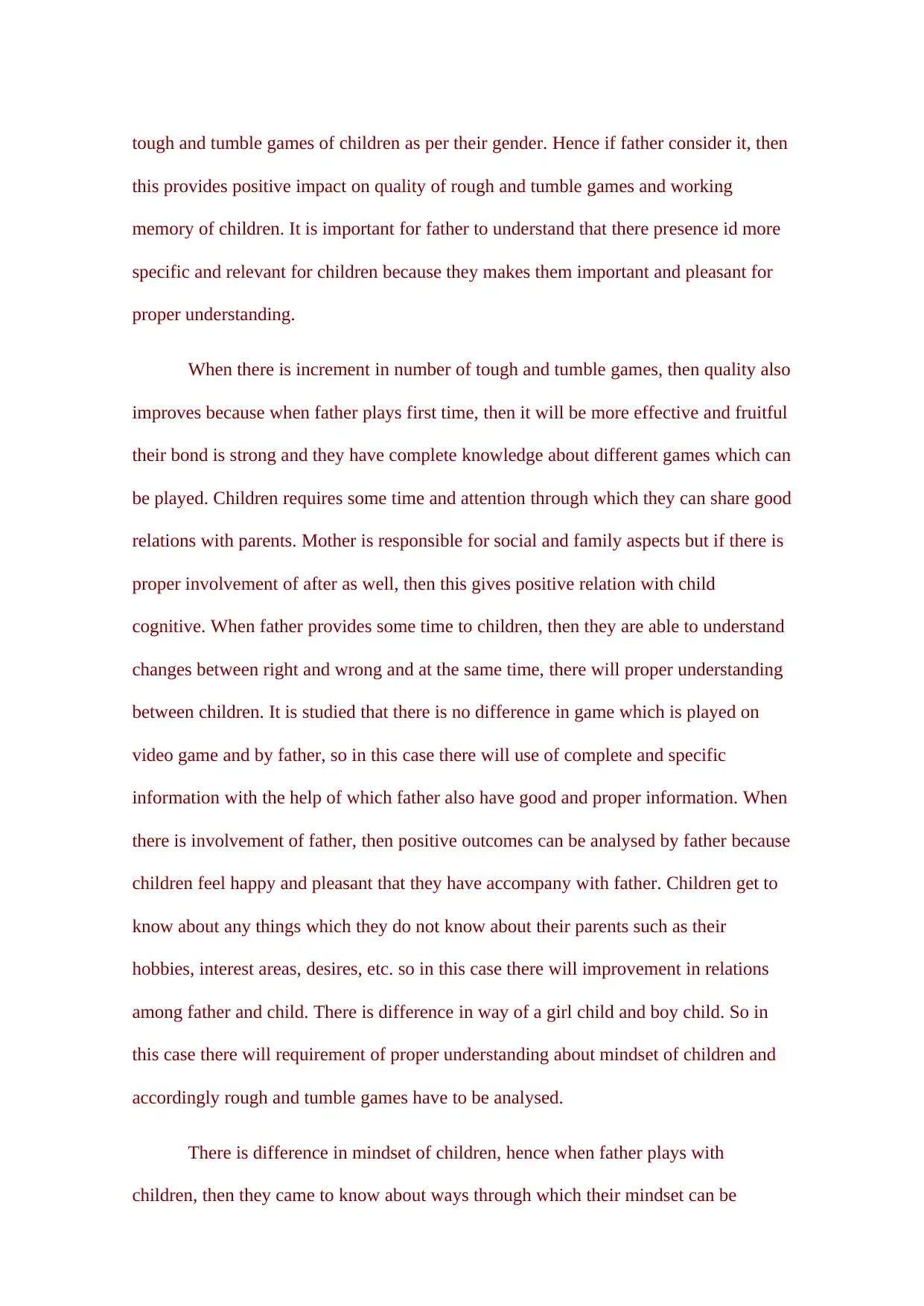
tough and tumble games of children as per their gender. Hence if father consider it, then
this provides positive impact on quality of rough and tumble games and working
memory of children. It is important for father to understand that there presence id more
specific and relevant for children because they makes them important and pleasant for
proper understanding.
When there is increment in number of tough and tumble games, then quality also
improves because when father plays first time, then it will be more effective and fruitful
their bond is strong and they have complete knowledge about different games which can
be played. Children requires some time and attention through which they can share good
relations with parents. Mother is responsible for social and family aspects but if there is
proper involvement of after as well, then this gives positive relation with child
cognitive. When father provides some time to children, then they are able to understand
changes between right and wrong and at the same time, there will proper understanding
between children. It is studied that there is no difference in game which is played on
video game and by father, so in this case there will use of complete and specific
information with the help of which father also have good and proper information. When
there is involvement of father, then positive outcomes can be analysed by father because
children feel happy and pleasant that they have accompany with father. Children get to
know about any things which they do not know about their parents such as their
hobbies, interest areas, desires, etc. so in this case there will improvement in relations
among father and child. There is difference in way of a girl child and boy child. So in
this case there will requirement of proper understanding about mindset of children and
accordingly rough and tumble games have to be analysed.
There is difference in mindset of children, hence when father plays with
children, then they came to know about ways through which their mindset can be
this provides positive impact on quality of rough and tumble games and working
memory of children. It is important for father to understand that there presence id more
specific and relevant for children because they makes them important and pleasant for
proper understanding.
When there is increment in number of tough and tumble games, then quality also
improves because when father plays first time, then it will be more effective and fruitful
their bond is strong and they have complete knowledge about different games which can
be played. Children requires some time and attention through which they can share good
relations with parents. Mother is responsible for social and family aspects but if there is
proper involvement of after as well, then this gives positive relation with child
cognitive. When father provides some time to children, then they are able to understand
changes between right and wrong and at the same time, there will proper understanding
between children. It is studied that there is no difference in game which is played on
video game and by father, so in this case there will use of complete and specific
information with the help of which father also have good and proper information. When
there is involvement of father, then positive outcomes can be analysed by father because
children feel happy and pleasant that they have accompany with father. Children get to
know about any things which they do not know about their parents such as their
hobbies, interest areas, desires, etc. so in this case there will improvement in relations
among father and child. There is difference in way of a girl child and boy child. So in
this case there will requirement of proper understanding about mindset of children and
accordingly rough and tumble games have to be analysed.
There is difference in mindset of children, hence when father plays with
children, then they came to know about ways through which their mindset can be
Secure Best Marks with AI Grader
Need help grading? Try our AI Grader for instant feedback on your assignments.
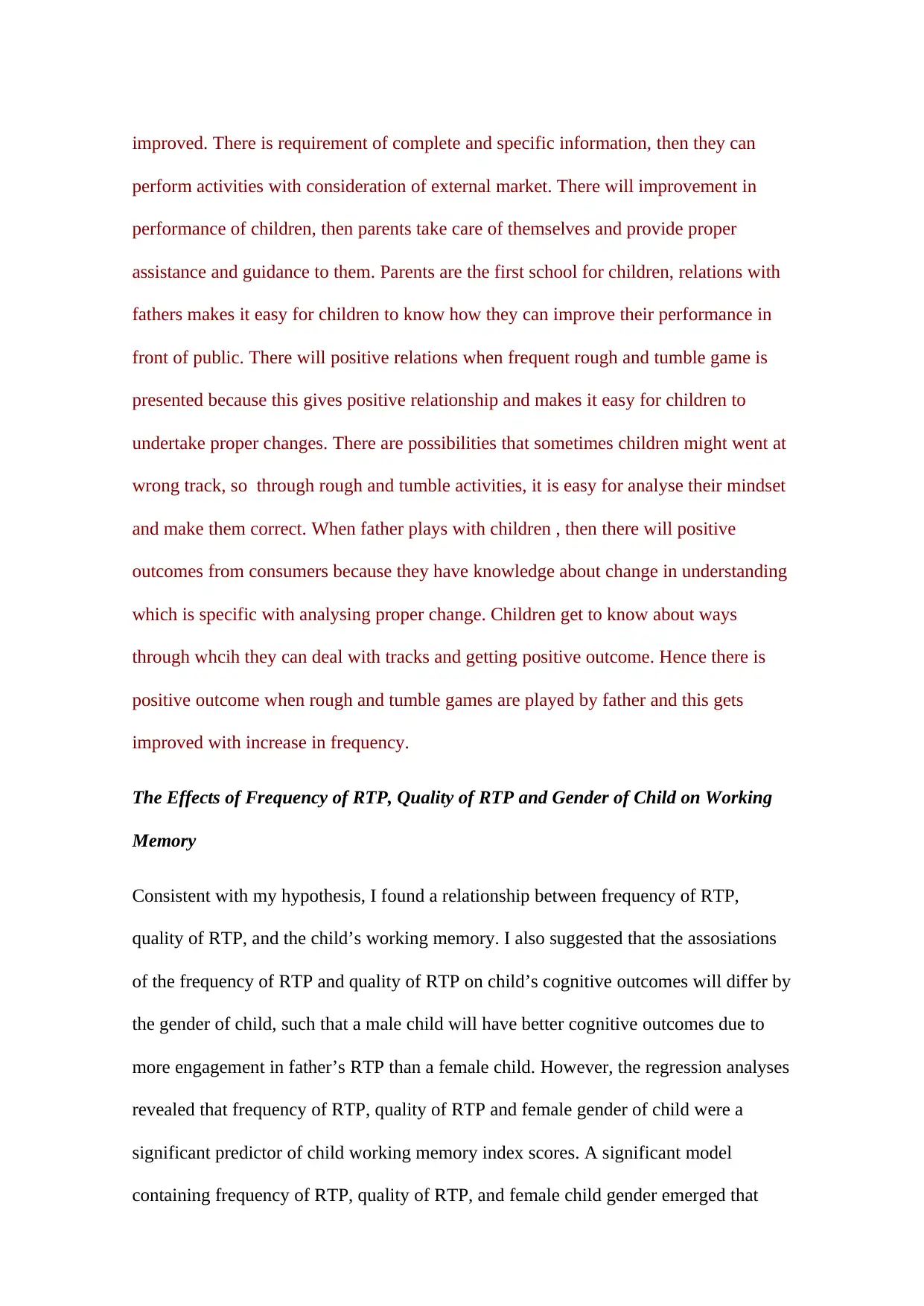
improved. There is requirement of complete and specific information, then they can
perform activities with consideration of external market. There will improvement in
performance of children, then parents take care of themselves and provide proper
assistance and guidance to them. Parents are the first school for children, relations with
fathers makes it easy for children to know how they can improve their performance in
front of public. There will positive relations when frequent rough and tumble game is
presented because this gives positive relationship and makes it easy for children to
undertake proper changes. There are possibilities that sometimes children might went at
wrong track, so through rough and tumble activities, it is easy for analyse their mindset
and make them correct. When father plays with children , then there will positive
outcomes from consumers because they have knowledge about change in understanding
which is specific with analysing proper change. Children get to know about ways
through whcih they can deal with tracks and getting positive outcome. Hence there is
positive outcome when rough and tumble games are played by father and this gets
improved with increase in frequency.
The Effects of Frequency of RTP, Quality of RTP and Gender of Child on Working
Memory
Consistent with my hypothesis, I found a relationship between frequency of RTP,
quality of RTP, and the child’s working memory. I also suggested that the assosiations
of the frequency of RTP and quality of RTP on child’s cognitive outcomes will differ by
the gender of child, such that a male child will have better cognitive outcomes due to
more engagement in father’s RTP than a female child. However, the regression analyses
revealed that frequency of RTP, quality of RTP and female gender of child were a
significant predictor of child working memory index scores. A significant model
containing frequency of RTP, quality of RTP, and female child gender emerged that
perform activities with consideration of external market. There will improvement in
performance of children, then parents take care of themselves and provide proper
assistance and guidance to them. Parents are the first school for children, relations with
fathers makes it easy for children to know how they can improve their performance in
front of public. There will positive relations when frequent rough and tumble game is
presented because this gives positive relationship and makes it easy for children to
undertake proper changes. There are possibilities that sometimes children might went at
wrong track, so through rough and tumble activities, it is easy for analyse their mindset
and make them correct. When father plays with children , then there will positive
outcomes from consumers because they have knowledge about change in understanding
which is specific with analysing proper change. Children get to know about ways
through whcih they can deal with tracks and getting positive outcome. Hence there is
positive outcome when rough and tumble games are played by father and this gets
improved with increase in frequency.
The Effects of Frequency of RTP, Quality of RTP and Gender of Child on Working
Memory
Consistent with my hypothesis, I found a relationship between frequency of RTP,
quality of RTP, and the child’s working memory. I also suggested that the assosiations
of the frequency of RTP and quality of RTP on child’s cognitive outcomes will differ by
the gender of child, such that a male child will have better cognitive outcomes due to
more engagement in father’s RTP than a female child. However, the regression analyses
revealed that frequency of RTP, quality of RTP and female gender of child were a
significant predictor of child working memory index scores. A significant model
containing frequency of RTP, quality of RTP, and female child gender emerged that
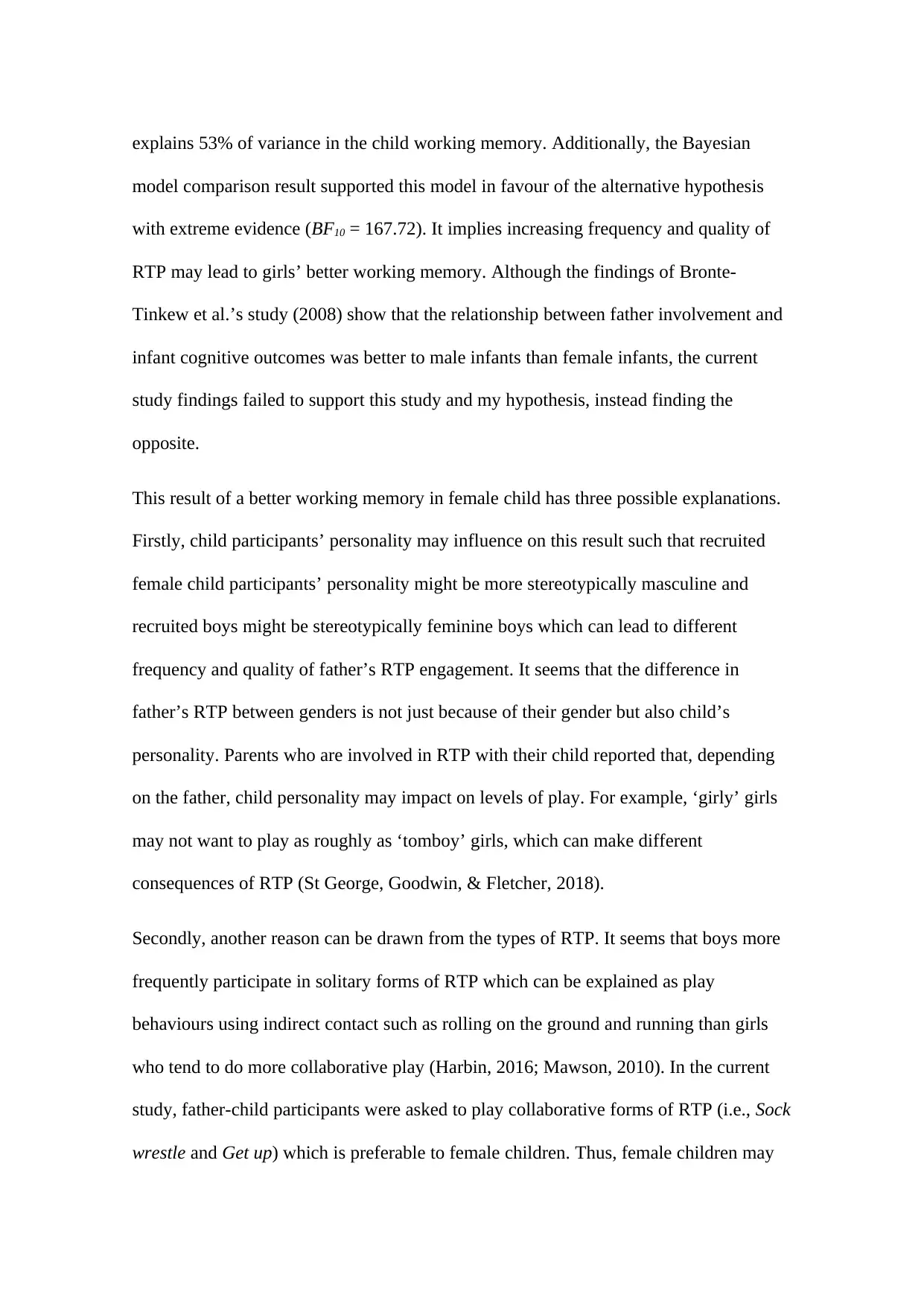
explains 53% of variance in the child working memory. Additionally, the Bayesian
model comparison result supported this model in favour of the alternative hypothesis
with extreme evidence (BF10 = 167.72). It implies increasing frequency and quality of
RTP may lead to girls’ better working memory. Although the findings of Bronte-
Tinkew et al.’s study (2008) show that the relationship between father involvement and
infant cognitive outcomes was better to male infants than female infants, the current
study findings failed to support this study and my hypothesis, instead finding the
opposite.
This result of a better working memory in female child has three possible explanations.
Firstly, child participants’ personality may influence on this result such that recruited
female child participants’ personality might be more stereotypically masculine and
recruited boys might be stereotypically feminine boys which can lead to different
frequency and quality of father’s RTP engagement. It seems that the difference in
father’s RTP between genders is not just because of their gender but also child’s
personality. Parents who are involved in RTP with their child reported that, depending
on the father, child personality may impact on levels of play. For example, ‘girly’ girls
may not want to play as roughly as ‘tomboy’ girls, which can make different
consequences of RTP (St George, Goodwin, & Fletcher, 2018).
Secondly, another reason can be drawn from the types of RTP. It seems that boys more
frequently participate in solitary forms of RTP which can be explained as play
behaviours using indirect contact such as rolling on the ground and running than girls
who tend to do more collaborative play (Harbin, 2016; Mawson, 2010). In the current
study, father-child participants were asked to play collaborative forms of RTP (i.e., Sock
wrestle and Get up) which is preferable to female children. Thus, female children may
model comparison result supported this model in favour of the alternative hypothesis
with extreme evidence (BF10 = 167.72). It implies increasing frequency and quality of
RTP may lead to girls’ better working memory. Although the findings of Bronte-
Tinkew et al.’s study (2008) show that the relationship between father involvement and
infant cognitive outcomes was better to male infants than female infants, the current
study findings failed to support this study and my hypothesis, instead finding the
opposite.
This result of a better working memory in female child has three possible explanations.
Firstly, child participants’ personality may influence on this result such that recruited
female child participants’ personality might be more stereotypically masculine and
recruited boys might be stereotypically feminine boys which can lead to different
frequency and quality of father’s RTP engagement. It seems that the difference in
father’s RTP between genders is not just because of their gender but also child’s
personality. Parents who are involved in RTP with their child reported that, depending
on the father, child personality may impact on levels of play. For example, ‘girly’ girls
may not want to play as roughly as ‘tomboy’ girls, which can make different
consequences of RTP (St George, Goodwin, & Fletcher, 2018).
Secondly, another reason can be drawn from the types of RTP. It seems that boys more
frequently participate in solitary forms of RTP which can be explained as play
behaviours using indirect contact such as rolling on the ground and running than girls
who tend to do more collaborative play (Harbin, 2016; Mawson, 2010). In the current
study, father-child participants were asked to play collaborative forms of RTP (i.e., Sock
wrestle and Get up) which is preferable to female children. Thus, female children may
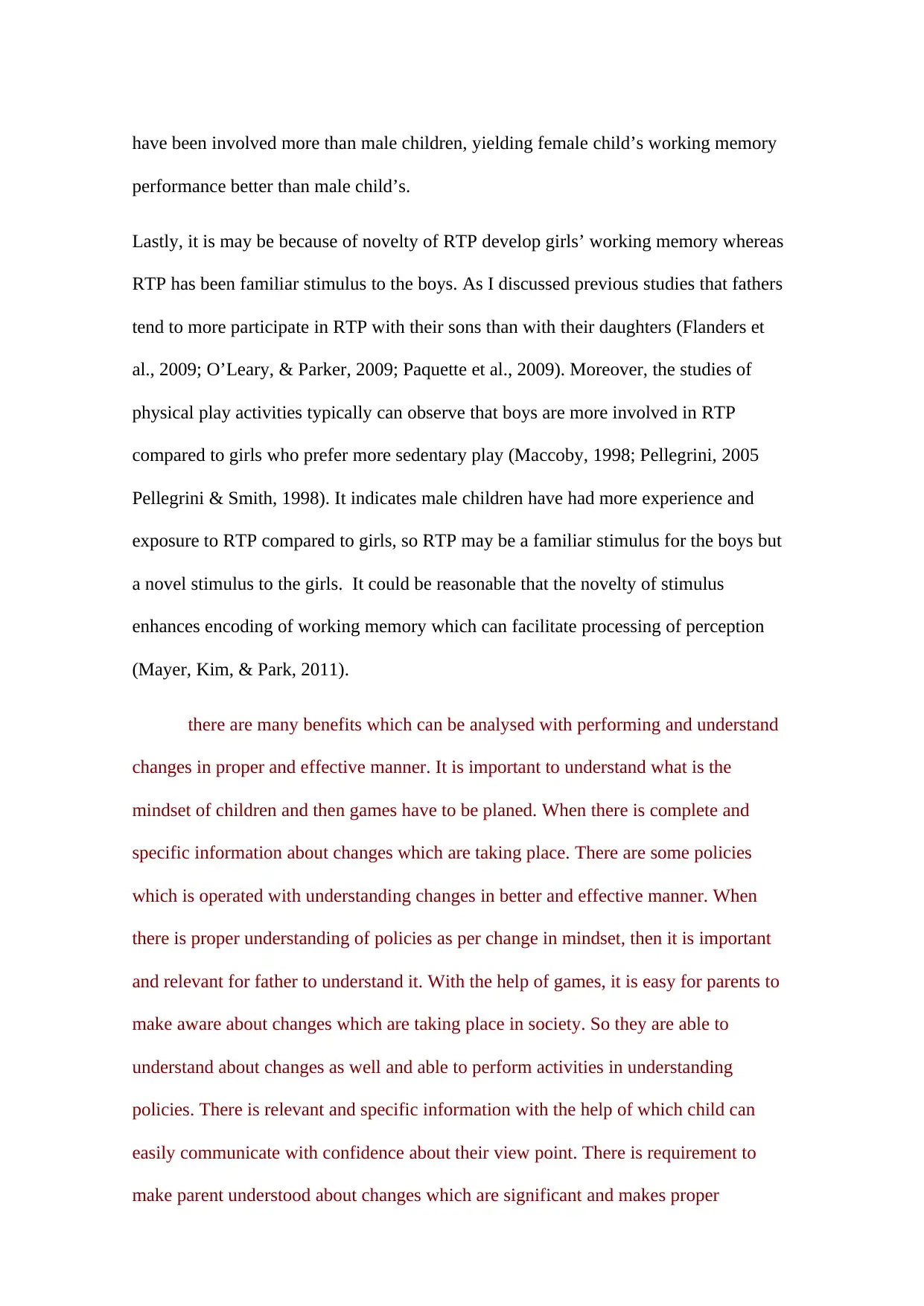
have been involved more than male children, yielding female child’s working memory
performance better than male child’s.
Lastly, it is may be because of novelty of RTP develop girls’ working memory whereas
RTP has been familiar stimulus to the boys. As I discussed previous studies that fathers
tend to more participate in RTP with their sons than with their daughters (Flanders et
al., 2009; O’Leary, & Parker, 2009; Paquette et al., 2009). Moreover, the studies of
physical play activities typically can observe that boys are more involved in RTP
compared to girls who prefer more sedentary play (Maccoby, 1998; Pellegrini, 2005
Pellegrini & Smith, 1998). It indicates male children have had more experience and
exposure to RTP compared to girls, so RTP may be a familiar stimulus for the boys but
a novel stimulus to the girls. It could be reasonable that the novelty of stimulus
enhances encoding of working memory which can facilitate processing of perception
(Mayer, Kim, & Park, 2011).
there are many benefits which can be analysed with performing and understand
changes in proper and effective manner. It is important to understand what is the
mindset of children and then games have to be planed. When there is complete and
specific information about changes which are taking place. There are some policies
which is operated with understanding changes in better and effective manner. When
there is proper understanding of policies as per change in mindset, then it is important
and relevant for father to understand it. With the help of games, it is easy for parents to
make aware about changes which are taking place in society. So they are able to
understand about changes as well and able to perform activities in understanding
policies. There is relevant and specific information with the help of which child can
easily communicate with confidence about their view point. There is requirement to
make parent understood about changes which are significant and makes proper
performance better than male child’s.
Lastly, it is may be because of novelty of RTP develop girls’ working memory whereas
RTP has been familiar stimulus to the boys. As I discussed previous studies that fathers
tend to more participate in RTP with their sons than with their daughters (Flanders et
al., 2009; O’Leary, & Parker, 2009; Paquette et al., 2009). Moreover, the studies of
physical play activities typically can observe that boys are more involved in RTP
compared to girls who prefer more sedentary play (Maccoby, 1998; Pellegrini, 2005
Pellegrini & Smith, 1998). It indicates male children have had more experience and
exposure to RTP compared to girls, so RTP may be a familiar stimulus for the boys but
a novel stimulus to the girls. It could be reasonable that the novelty of stimulus
enhances encoding of working memory which can facilitate processing of perception
(Mayer, Kim, & Park, 2011).
there are many benefits which can be analysed with performing and understand
changes in proper and effective manner. It is important to understand what is the
mindset of children and then games have to be planed. When there is complete and
specific information about changes which are taking place. There are some policies
which is operated with understanding changes in better and effective manner. When
there is proper understanding of policies as per change in mindset, then it is important
and relevant for father to understand it. With the help of games, it is easy for parents to
make aware about changes which are taking place in society. So they are able to
understand about changes as well and able to perform activities in understanding
policies. There is relevant and specific information with the help of which child can
easily communicate with confidence about their view point. There is requirement to
make parent understood about changes which are significant and makes proper
Paraphrase This Document
Need a fresh take? Get an instant paraphrase of this document with our AI Paraphraser
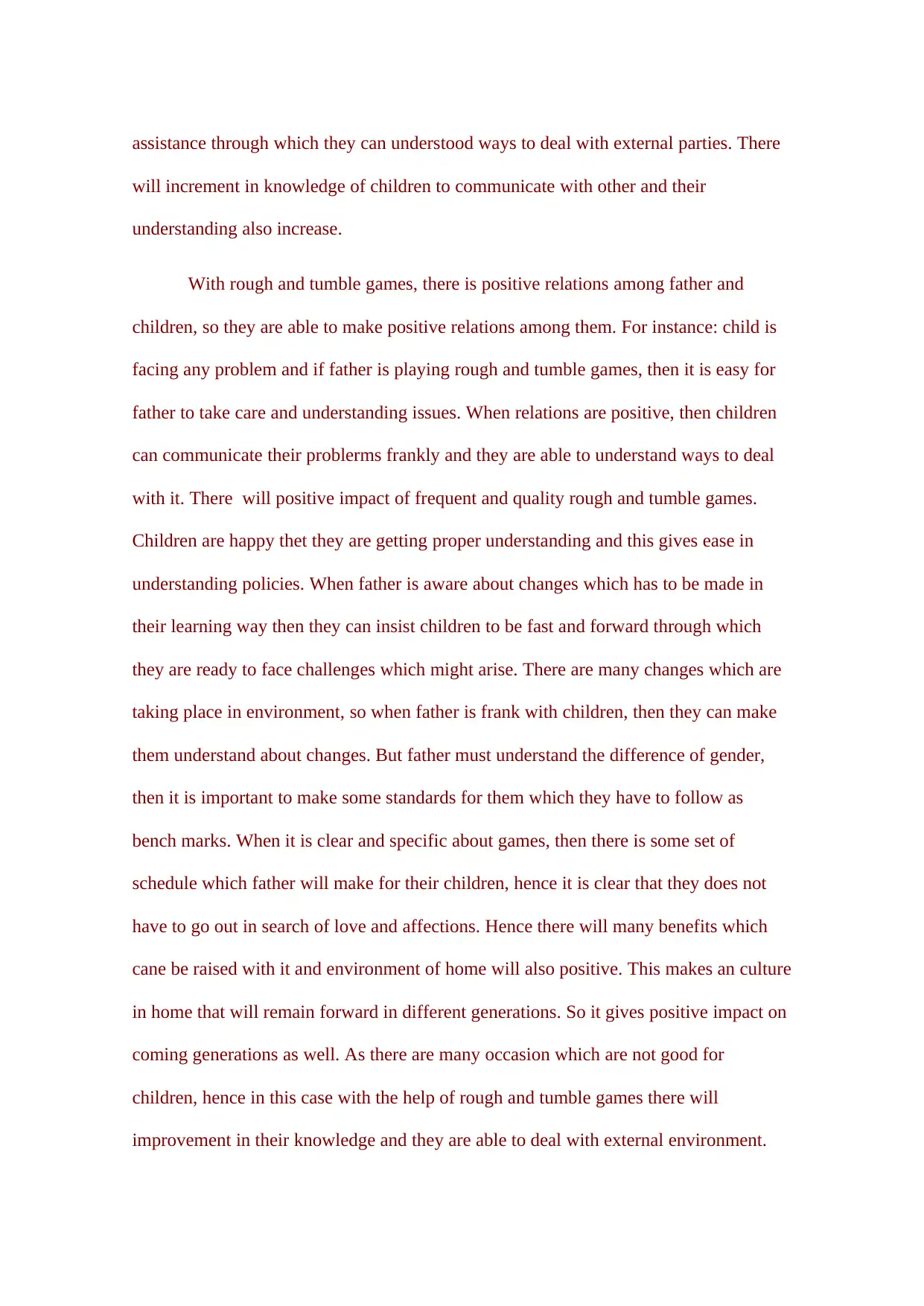
assistance through which they can understood ways to deal with external parties. There
will increment in knowledge of children to communicate with other and their
understanding also increase.
With rough and tumble games, there is positive relations among father and
children, so they are able to make positive relations among them. For instance: child is
facing any problem and if father is playing rough and tumble games, then it is easy for
father to take care and understanding issues. When relations are positive, then children
can communicate their problerms frankly and they are able to understand ways to deal
with it. There will positive impact of frequent and quality rough and tumble games.
Children are happy thet they are getting proper understanding and this gives ease in
understanding policies. When father is aware about changes which has to be made in
their learning way then they can insist children to be fast and forward through which
they are ready to face challenges which might arise. There are many changes which are
taking place in environment, so when father is frank with children, then they can make
them understand about changes. But father must understand the difference of gender,
then it is important to make some standards for them which they have to follow as
bench marks. When it is clear and specific about games, then there is some set of
schedule which father will make for their children, hence it is clear that they does not
have to go out in search of love and affections. Hence there will many benefits which
cane be raised with it and environment of home will also positive. This makes an culture
in home that will remain forward in different generations. So it gives positive impact on
coming generations as well. As there are many occasion which are not good for
children, hence in this case with the help of rough and tumble games there will
improvement in their knowledge and they are able to deal with external environment.
will increment in knowledge of children to communicate with other and their
understanding also increase.
With rough and tumble games, there is positive relations among father and
children, so they are able to make positive relations among them. For instance: child is
facing any problem and if father is playing rough and tumble games, then it is easy for
father to take care and understanding issues. When relations are positive, then children
can communicate their problerms frankly and they are able to understand ways to deal
with it. There will positive impact of frequent and quality rough and tumble games.
Children are happy thet they are getting proper understanding and this gives ease in
understanding policies. When father is aware about changes which has to be made in
their learning way then they can insist children to be fast and forward through which
they are ready to face challenges which might arise. There are many changes which are
taking place in environment, so when father is frank with children, then they can make
them understand about changes. But father must understand the difference of gender,
then it is important to make some standards for them which they have to follow as
bench marks. When it is clear and specific about games, then there is some set of
schedule which father will make for their children, hence it is clear that they does not
have to go out in search of love and affections. Hence there will many benefits which
cane be raised with it and environment of home will also positive. This makes an culture
in home that will remain forward in different generations. So it gives positive impact on
coming generations as well. As there are many occasion which are not good for
children, hence in this case with the help of rough and tumble games there will
improvement in their knowledge and they are able to deal with external environment.

When there is complete and specific information with after about children, then
it is easy for them to understand what is best for them. Children also get to know about
understanding policies which has to be understood about policies which understanding
changes in appropriate policies. So it is clear that there will positive impact on children's
personality with rough and tumble games with involvement of father.
it is easy for them to understand what is best for them. Children also get to know about
understanding policies which has to be understood about policies which understanding
changes in appropriate policies. So it is clear that there will positive impact on children's
personality with rough and tumble games with involvement of father.
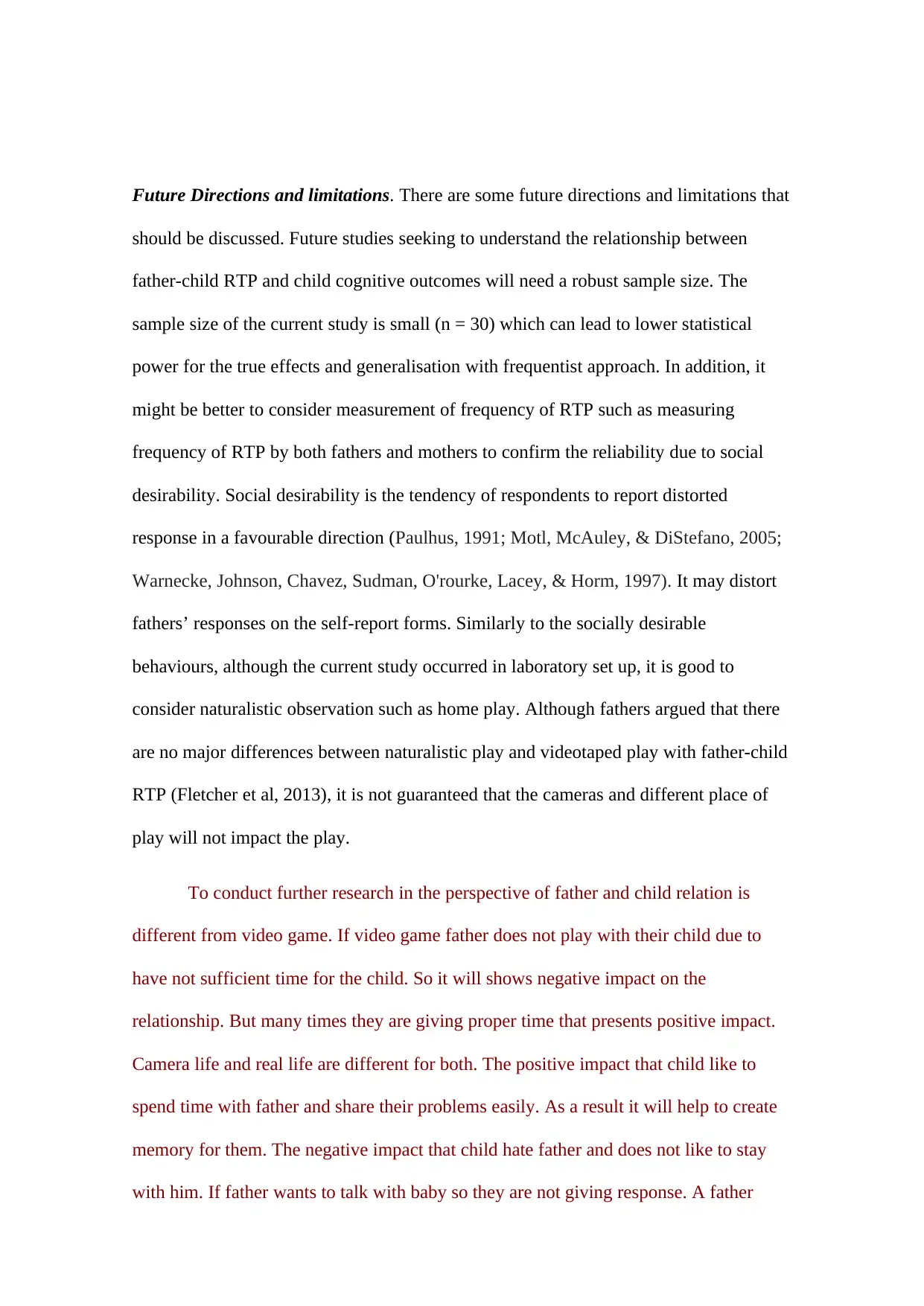
Future Directions and limitations. There are some future directions and limitations that
should be discussed. Future studies seeking to understand the relationship between
father-child RTP and child cognitive outcomes will need a robust sample size. The
sample size of the current study is small (n = 30) which can lead to lower statistical
power for the true effects and generalisation with frequentist approach. In addition, it
might be better to consider measurement of frequency of RTP such as measuring
frequency of RTP by both fathers and mothers to confirm the reliability due to social
desirability. Social desirability is the tendency of respondents to report distorted
response in a favourable direction (Paulhus, 1991; Motl, McAuley, & DiStefano, 2005;
Warnecke, Johnson, Chavez, Sudman, O'rourke, Lacey, & Horm, 1997). It may distort
fathers’ responses on the self-report forms. Similarly to the socially desirable
behaviours, although the current study occurred in laboratory set up, it is good to
consider naturalistic observation such as home play. Although fathers argued that there
are no major differences between naturalistic play and videotaped play with father-child
RTP (Fletcher et al, 2013), it is not guaranteed that the cameras and different place of
play will not impact the play.
To conduct further research in the perspective of father and child relation is
different from video game. If video game father does not play with their child due to
have not sufficient time for the child. So it will shows negative impact on the
relationship. But many times they are giving proper time that presents positive impact.
Camera life and real life are different for both. The positive impact that child like to
spend time with father and share their problems easily. As a result it will help to create
memory for them. The negative impact that child hate father and does not like to stay
with him. If father wants to talk with baby so they are not giving response. A father
should be discussed. Future studies seeking to understand the relationship between
father-child RTP and child cognitive outcomes will need a robust sample size. The
sample size of the current study is small (n = 30) which can lead to lower statistical
power for the true effects and generalisation with frequentist approach. In addition, it
might be better to consider measurement of frequency of RTP such as measuring
frequency of RTP by both fathers and mothers to confirm the reliability due to social
desirability. Social desirability is the tendency of respondents to report distorted
response in a favourable direction (Paulhus, 1991; Motl, McAuley, & DiStefano, 2005;
Warnecke, Johnson, Chavez, Sudman, O'rourke, Lacey, & Horm, 1997). It may distort
fathers’ responses on the self-report forms. Similarly to the socially desirable
behaviours, although the current study occurred in laboratory set up, it is good to
consider naturalistic observation such as home play. Although fathers argued that there
are no major differences between naturalistic play and videotaped play with father-child
RTP (Fletcher et al, 2013), it is not guaranteed that the cameras and different place of
play will not impact the play.
To conduct further research in the perspective of father and child relation is
different from video game. If video game father does not play with their child due to
have not sufficient time for the child. So it will shows negative impact on the
relationship. But many times they are giving proper time that presents positive impact.
Camera life and real life are different for both. The positive impact that child like to
spend time with father and share their problems easily. As a result it will help to create
memory for them. The negative impact that child hate father and does not like to stay
with him. If father wants to talk with baby so they are not giving response. A father
Secure Best Marks with AI Grader
Need help grading? Try our AI Grader for instant feedback on your assignments.
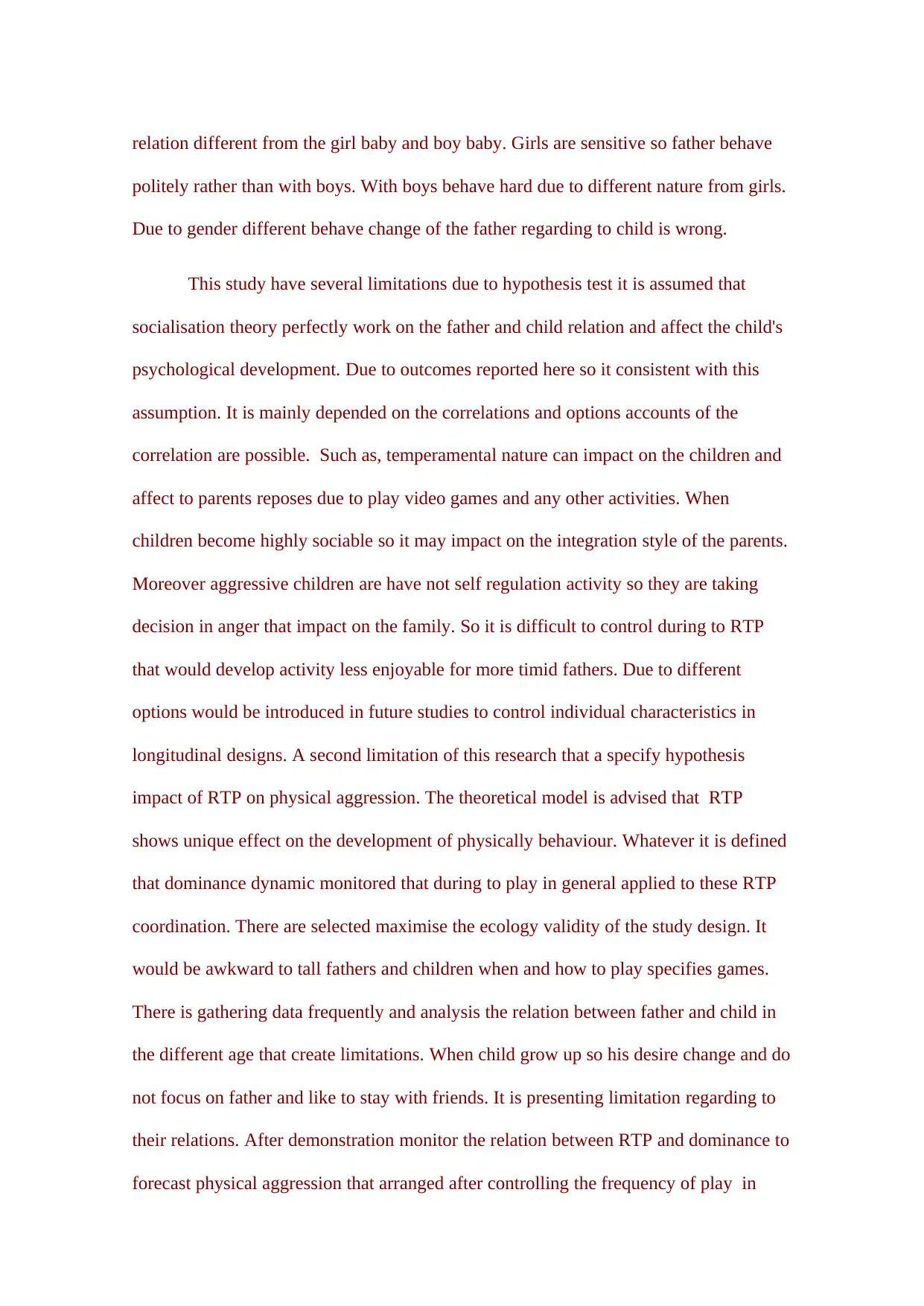
relation different from the girl baby and boy baby. Girls are sensitive so father behave
politely rather than with boys. With boys behave hard due to different nature from girls.
Due to gender different behave change of the father regarding to child is wrong.
This study have several limitations due to hypothesis test it is assumed that
socialisation theory perfectly work on the father and child relation and affect the child's
psychological development. Due to outcomes reported here so it consistent with this
assumption. It is mainly depended on the correlations and options accounts of the
correlation are possible. Such as, temperamental nature can impact on the children and
affect to parents reposes due to play video games and any other activities. When
children become highly sociable so it may impact on the integration style of the parents.
Moreover aggressive children are have not self regulation activity so they are taking
decision in anger that impact on the family. So it is difficult to control during to RTP
that would develop activity less enjoyable for more timid fathers. Due to different
options would be introduced in future studies to control individual characteristics in
longitudinal designs. A second limitation of this research that a specify hypothesis
impact of RTP on physical aggression. The theoretical model is advised that RTP
shows unique effect on the development of physically behaviour. Whatever it is defined
that dominance dynamic monitored that during to play in general applied to these RTP
coordination. There are selected maximise the ecology validity of the study design. It
would be awkward to tall fathers and children when and how to play specifies games.
There is gathering data frequently and analysis the relation between father and child in
the different age that create limitations. When child grow up so his desire change and do
not focus on father and like to stay with friends. It is presenting limitation regarding to
their relations. After demonstration monitor the relation between RTP and dominance to
forecast physical aggression that arranged after controlling the frequency of play in
politely rather than with boys. With boys behave hard due to different nature from girls.
Due to gender different behave change of the father regarding to child is wrong.
This study have several limitations due to hypothesis test it is assumed that
socialisation theory perfectly work on the father and child relation and affect the child's
psychological development. Due to outcomes reported here so it consistent with this
assumption. It is mainly depended on the correlations and options accounts of the
correlation are possible. Such as, temperamental nature can impact on the children and
affect to parents reposes due to play video games and any other activities. When
children become highly sociable so it may impact on the integration style of the parents.
Moreover aggressive children are have not self regulation activity so they are taking
decision in anger that impact on the family. So it is difficult to control during to RTP
that would develop activity less enjoyable for more timid fathers. Due to different
options would be introduced in future studies to control individual characteristics in
longitudinal designs. A second limitation of this research that a specify hypothesis
impact of RTP on physical aggression. The theoretical model is advised that RTP
shows unique effect on the development of physically behaviour. Whatever it is defined
that dominance dynamic monitored that during to play in general applied to these RTP
coordination. There are selected maximise the ecology validity of the study design. It
would be awkward to tall fathers and children when and how to play specifies games.
There is gathering data frequently and analysis the relation between father and child in
the different age that create limitations. When child grow up so his desire change and do
not focus on father and like to stay with friends. It is presenting limitation regarding to
their relations. After demonstration monitor the relation between RTP and dominance to
forecast physical aggression that arranged after controlling the frequency of play in
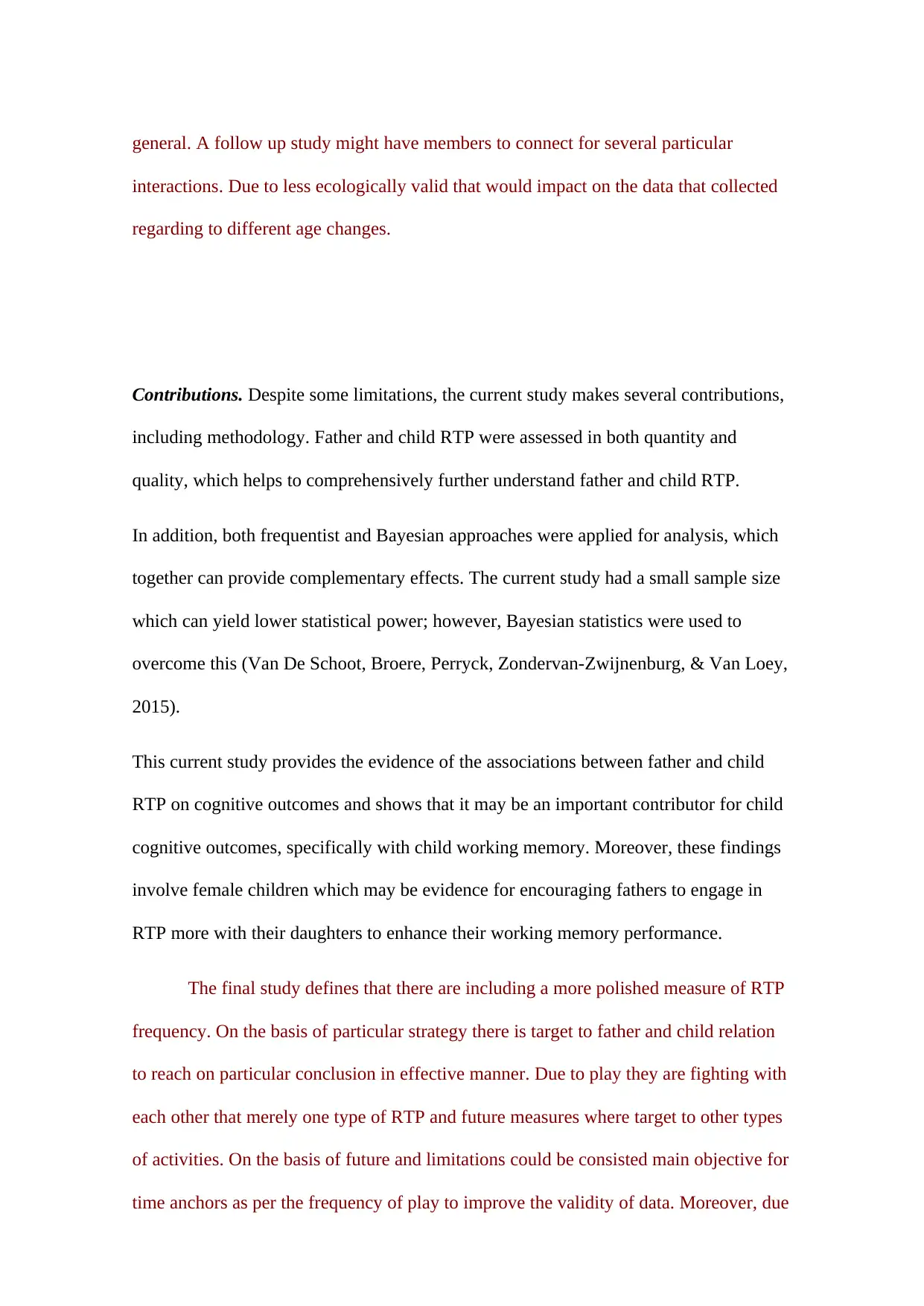
general. A follow up study might have members to connect for several particular
interactions. Due to less ecologically valid that would impact on the data that collected
regarding to different age changes.
Contributions. Despite some limitations, the current study makes several contributions,
including methodology. Father and child RTP were assessed in both quantity and
quality, which helps to comprehensively further understand father and child RTP.
In addition, both frequentist and Bayesian approaches were applied for analysis, which
together can provide complementary effects. The current study had a small sample size
which can yield lower statistical power; however, Bayesian statistics were used to
overcome this (Van De Schoot, Broere, Perryck, Zondervan-Zwijnenburg, & Van Loey,
2015).
This current study provides the evidence of the associations between father and child
RTP on cognitive outcomes and shows that it may be an important contributor for child
cognitive outcomes, specifically with child working memory. Moreover, these findings
involve female children which may be evidence for encouraging fathers to engage in
RTP more with their daughters to enhance their working memory performance.
The final study defines that there are including a more polished measure of RTP
frequency. On the basis of particular strategy there is target to father and child relation
to reach on particular conclusion in effective manner. Due to play they are fighting with
each other that merely one type of RTP and future measures where target to other types
of activities. On the basis of future and limitations could be consisted main objective for
time anchors as per the frequency of play to improve the validity of data. Moreover, due
interactions. Due to less ecologically valid that would impact on the data that collected
regarding to different age changes.
Contributions. Despite some limitations, the current study makes several contributions,
including methodology. Father and child RTP were assessed in both quantity and
quality, which helps to comprehensively further understand father and child RTP.
In addition, both frequentist and Bayesian approaches were applied for analysis, which
together can provide complementary effects. The current study had a small sample size
which can yield lower statistical power; however, Bayesian statistics were used to
overcome this (Van De Schoot, Broere, Perryck, Zondervan-Zwijnenburg, & Van Loey,
2015).
This current study provides the evidence of the associations between father and child
RTP on cognitive outcomes and shows that it may be an important contributor for child
cognitive outcomes, specifically with child working memory. Moreover, these findings
involve female children which may be evidence for encouraging fathers to engage in
RTP more with their daughters to enhance their working memory performance.
The final study defines that there are including a more polished measure of RTP
frequency. On the basis of particular strategy there is target to father and child relation
to reach on particular conclusion in effective manner. Due to play they are fighting with
each other that merely one type of RTP and future measures where target to other types
of activities. On the basis of future and limitations could be consisted main objective for
time anchors as per the frequency of play to improve the validity of data. Moreover, due
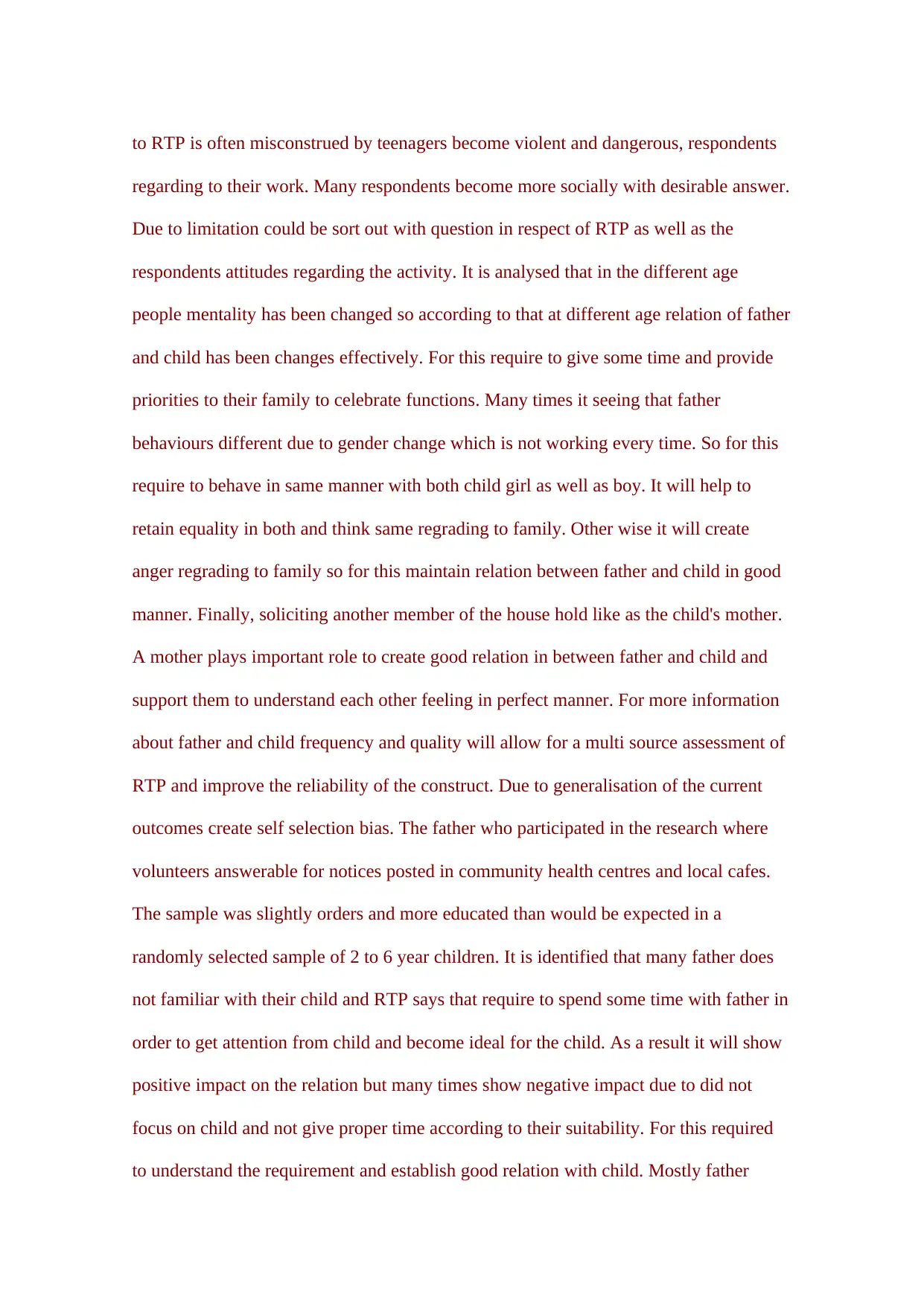
to RTP is often misconstrued by teenagers become violent and dangerous, respondents
regarding to their work. Many respondents become more socially with desirable answer.
Due to limitation could be sort out with question in respect of RTP as well as the
respondents attitudes regarding the activity. It is analysed that in the different age
people mentality has been changed so according to that at different age relation of father
and child has been changes effectively. For this require to give some time and provide
priorities to their family to celebrate functions. Many times it seeing that father
behaviours different due to gender change which is not working every time. So for this
require to behave in same manner with both child girl as well as boy. It will help to
retain equality in both and think same regrading to family. Other wise it will create
anger regrading to family so for this maintain relation between father and child in good
manner. Finally, soliciting another member of the house hold like as the child's mother.
A mother plays important role to create good relation in between father and child and
support them to understand each other feeling in perfect manner. For more information
about father and child frequency and quality will allow for a multi source assessment of
RTP and improve the reliability of the construct. Due to generalisation of the current
outcomes create self selection bias. The father who participated in the research where
volunteers answerable for notices posted in community health centres and local cafes.
The sample was slightly orders and more educated than would be expected in a
randomly selected sample of 2 to 6 year children. It is identified that many father does
not familiar with their child and RTP says that require to spend some time with father in
order to get attention from child and become ideal for the child. As a result it will show
positive impact on the relation but many times show negative impact due to did not
focus on child and not give proper time according to their suitability. For this required
to understand the requirement and establish good relation with child. Mostly father
regarding to their work. Many respondents become more socially with desirable answer.
Due to limitation could be sort out with question in respect of RTP as well as the
respondents attitudes regarding the activity. It is analysed that in the different age
people mentality has been changed so according to that at different age relation of father
and child has been changes effectively. For this require to give some time and provide
priorities to their family to celebrate functions. Many times it seeing that father
behaviours different due to gender change which is not working every time. So for this
require to behave in same manner with both child girl as well as boy. It will help to
retain equality in both and think same regrading to family. Other wise it will create
anger regrading to family so for this maintain relation between father and child in good
manner. Finally, soliciting another member of the house hold like as the child's mother.
A mother plays important role to create good relation in between father and child and
support them to understand each other feeling in perfect manner. For more information
about father and child frequency and quality will allow for a multi source assessment of
RTP and improve the reliability of the construct. Due to generalisation of the current
outcomes create self selection bias. The father who participated in the research where
volunteers answerable for notices posted in community health centres and local cafes.
The sample was slightly orders and more educated than would be expected in a
randomly selected sample of 2 to 6 year children. It is identified that many father does
not familiar with their child and RTP says that require to spend some time with father in
order to get attention from child and become ideal for the child. As a result it will show
positive impact on the relation but many times show negative impact due to did not
focus on child and not give proper time according to their suitability. For this required
to understand the requirement and establish good relation with child. Mostly father
Paraphrase This Document
Need a fresh take? Get an instant paraphrase of this document with our AI Paraphraser

think that camera life and real life same but it is wrong both are not same so it is
required to concentrate on real life and help mother to grow in child. In the growth child
behave violent and many times politely so required to focus on every activities.
required to concentrate on real life and help mother to grow in child. In the growth child
behave violent and many times politely so required to focus on every activities.
1 out of 38
Your All-in-One AI-Powered Toolkit for Academic Success.
+13062052269
info@desklib.com
Available 24*7 on WhatsApp / Email
![[object Object]](/_next/static/media/star-bottom.7253800d.svg)
Unlock your academic potential
© 2024 | Zucol Services PVT LTD | All rights reserved.


